
Admin
-
Posts
7,486 -
Joined
-
Last visited
Content Type
Profiles
Forums
Events
Store
Gallery
Community Map
Posts posted by Admin
-
-
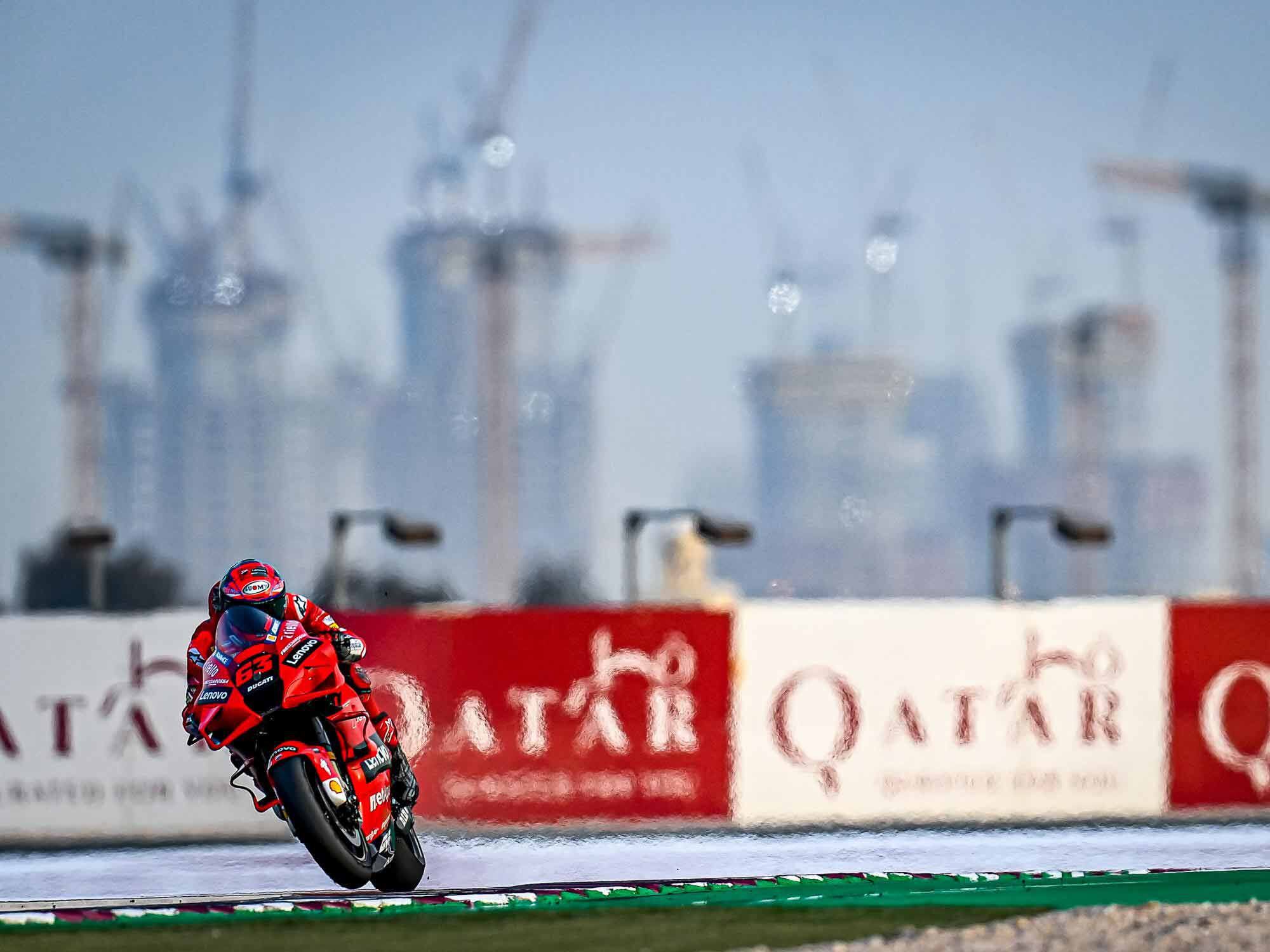
MotoGP testing has concluded at Losail International Circuit, now the focus turns to the first race of the 2021 MotoGP season. (MotoGP/)In the recent past the MotoGP norm has been to have a couple of preseason tests at hot, humid Sepang in Malaysia, and have a go at a Spanish track as well. But this is the time of COVID and everything’s different.
Each track acts as a filter on the starting field. Ducatis go well where strong acceleration and top speed count most. Yamaha and Suzuki excel where long fast corners outnumber corners that favor point-and-shoot riding. Honda, back when star rider Marc Márquez was neither injured nor convalescing, worked best where hard braking, quick turning, and sudden acceleration were needed.
After five days of running Qatar at night under the lights, four riders, one Ducati and three Yamaha, are under Márquez’s old 2019 lap record of 1:53.380: Jack Miller, Maverick Viñales, Fabio Quartararo, and Franco Morbidelli.
As the pundits-on-scene correctly point out, teams and riders went to Qatar not to “win the practice” but to get actual track time, severely limited by rule to specified venues and times each year, with which to evaluate what they have built over the past winter. They are not trying to set fast laps. In fact, because their true goal is to improve the bikes, they devote the most time and effort to their worst areas of performance.
Something similar used to confuse race watchers during Friday and Saturday practices because Valentino Rossi, back in his greatest days, was often slow. This was his method of working: to concentrate on specific areas of the track to solve their special problems, not putting together a fast lap until qualifying. This is why he is called “a Sunday rider;” you get points for what you do on Sunday, not for wasting time and rubber trying to teach the one-lap wonder boys a lesson in the free practices.
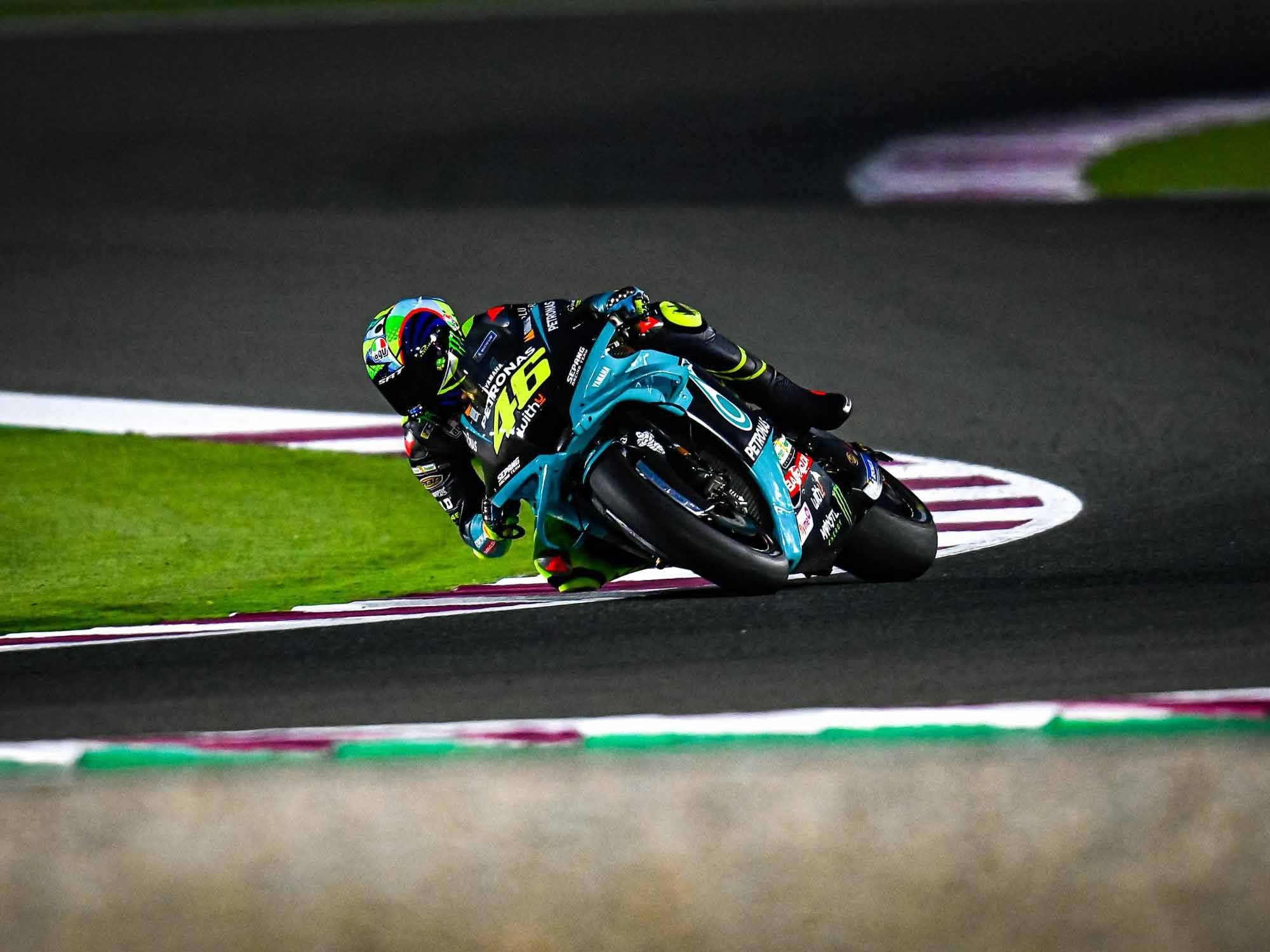
As Rossi has shown during his long career, testing lap and practice times are not a true indicator of who has the speed. Testing is for getting the bike set for when it matters on Sunday. (MotoGP/)Aside from Yamaha and Ducati, Honda is out of it for the moment; although its present riders show promise, none of them is ready to rule. Pol Espargaró, newly on Honda, was top man for the team at Qatar in tenth. KTM has “hit a wall” and is working out the problem. The Suzukis were seventh and eighth fastest, respected for Joan Mir’s consistency in winning last year’s championship, but not yet in top places. Aprilia’s Aleix Espargaró was sixth.
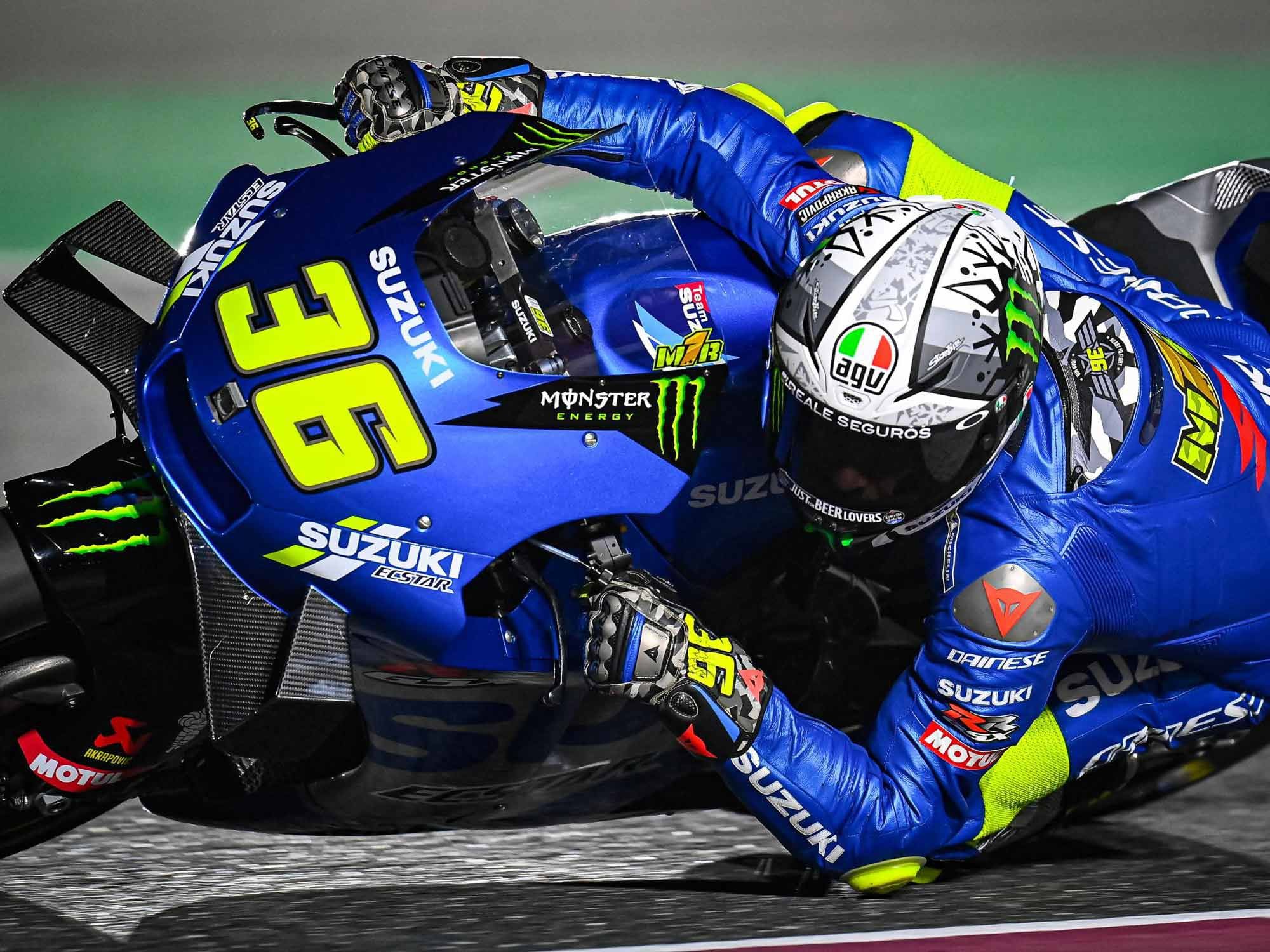
Joan Mir’s consistency won him the title last year. Will it be more of the same in 2021? (MotoGP/)There is Yamaha again, at the start of the year looking pretty good. The new bike has been described as a 2019 chassis with engine mounts altered to accept the 2020 engine. Quartararo’s strong performances last year were achieved on a 2019 bike (he was a satellite rider then, but now he’s factory).
In the past several seasons Yamaha has seemed to have improved every spring. But as soon as actual racing has started, the old problems of poor rear grip in the last third of races and loss of front tire condition during drafting have re-emerged. Yamaha’s intentional horsepower shortfall requires drafting—especially so in 2020 because of engine reliability problems that forced a redline reduction. It has always been Yamaha’s policy, even in the two-stroke era, to shape engine power for a range of acceleration rather than to go more for peak as Honda and Ducati (and latterly, KTM) have done.
That power shortfall persists. Quartararo said this past week, “On the straight, if there is a Ducati, it will overtake us and we need to find a solution to overtake them back and make a gap.”
Loyal Yamaha engineers would surely chorus “Perhaps here at Qatar, but when we get to other tracks our advantages will appear.”
Those free to speak their minds would surely add, “Qatar gives advantage to both Ducati and Yamaha for different reasons, yet Quartararo said what he did.”
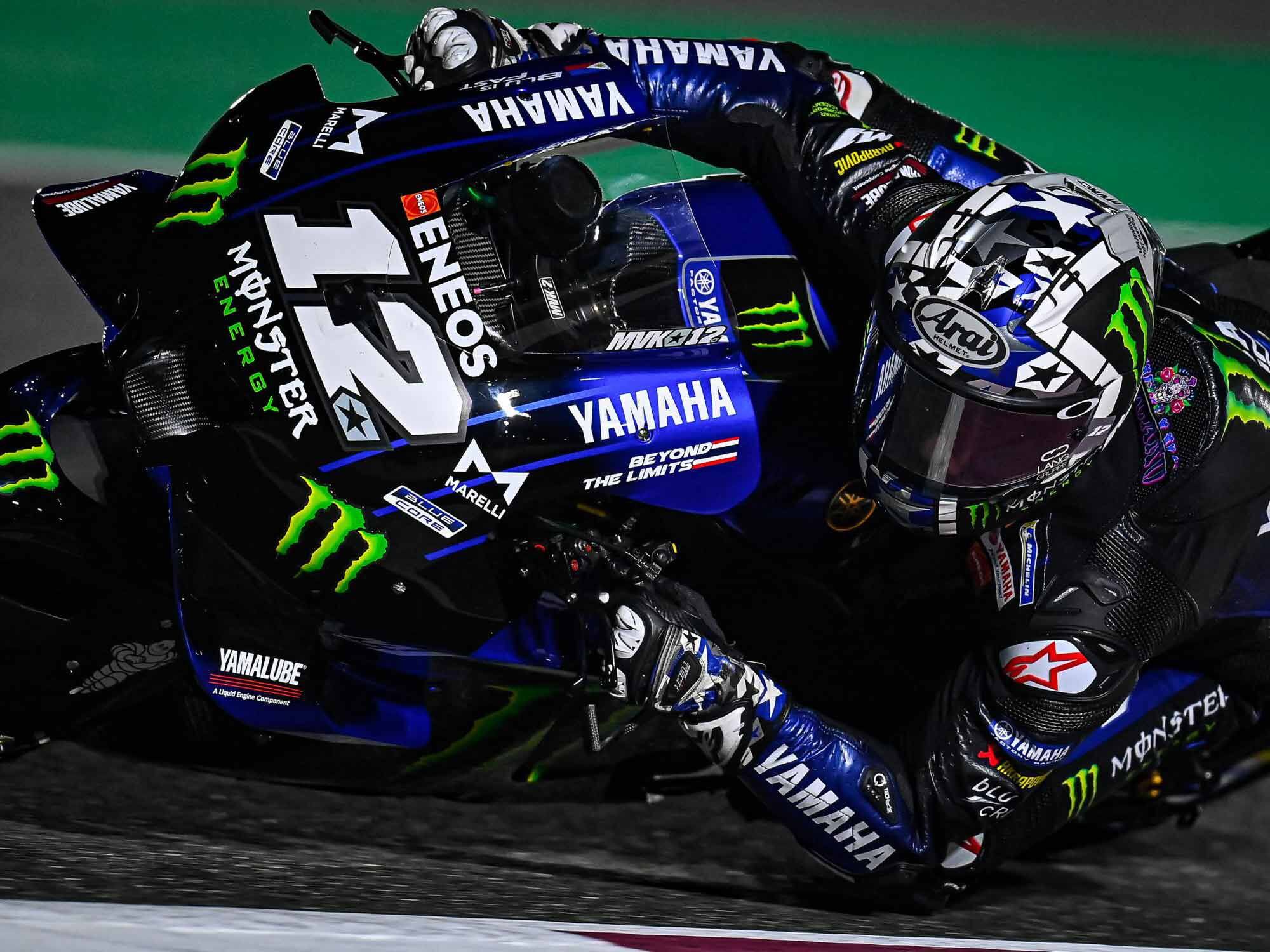
How will the front tires of the Yamahas perform when in a race situation? (MotoGP/)Also yet to be determined is what will happen to Yamaha front tires when they must sit in the hot slipstream of more powerful bikes. Last year the Yamahas were able to make fast single laps in practice, but in races there was often front tire fade. Over the years this has given Viñales’ career the aspect of Greek tragedy.
Marc Márquez did not ride this test, but it’s said he’s been cleared for more intensive physical conditioning for an early return to action. His fans expect him to promptly shrink his rivals to the status of midgets. In his absence the Hondas ridden by others are said to have “had their sharp edges filed off” to make their performance more accessible to those others.
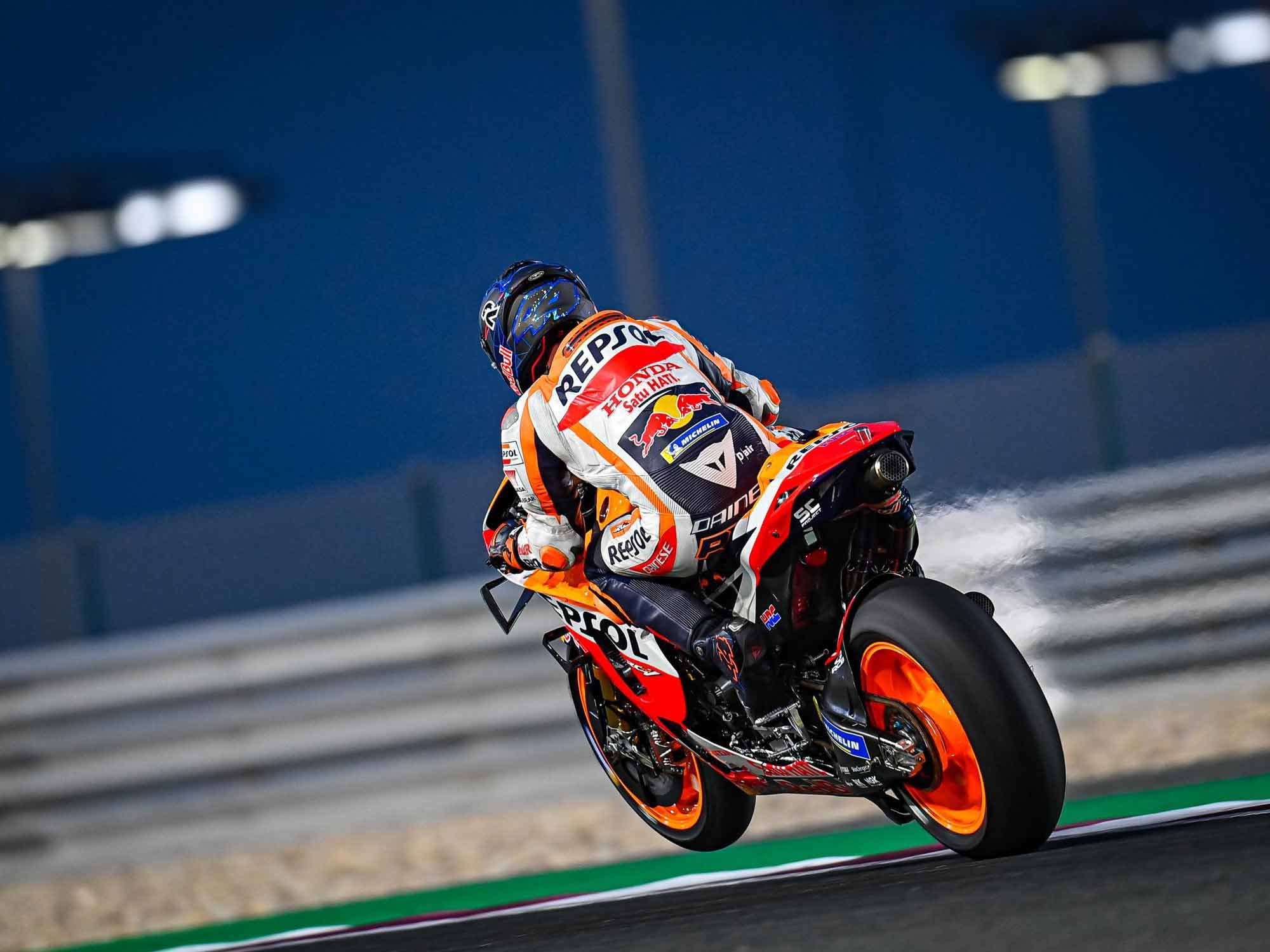
Pol Espargaró was the top Honda rider in testing. (MotoGP /)As David Emmett has pointed out, with engine development on hold until 2022 engineering budgets are now funding aero trickery. Motorcycles, their shortness denying them the tapering tails that so streamline aircraft, fish, and birds, have the aero coefficients of bread vans. The shock innovator in recent years has been Ducati, and it did not disappoint at Qatar. As before, both front and rear wheels have been smoothed by the addition of carbon fiber sectors centered on 6 o’clock. Seeing how close these covers come to the pavement at full lean, speculation has arisen that they may produce measurable downforce by acting as ground effect venturis. If they do, they also produce a torque tending to increase the bike’s angle of lean. So far I’ve seen no rider comments on a change in steering feel at high lean angle.
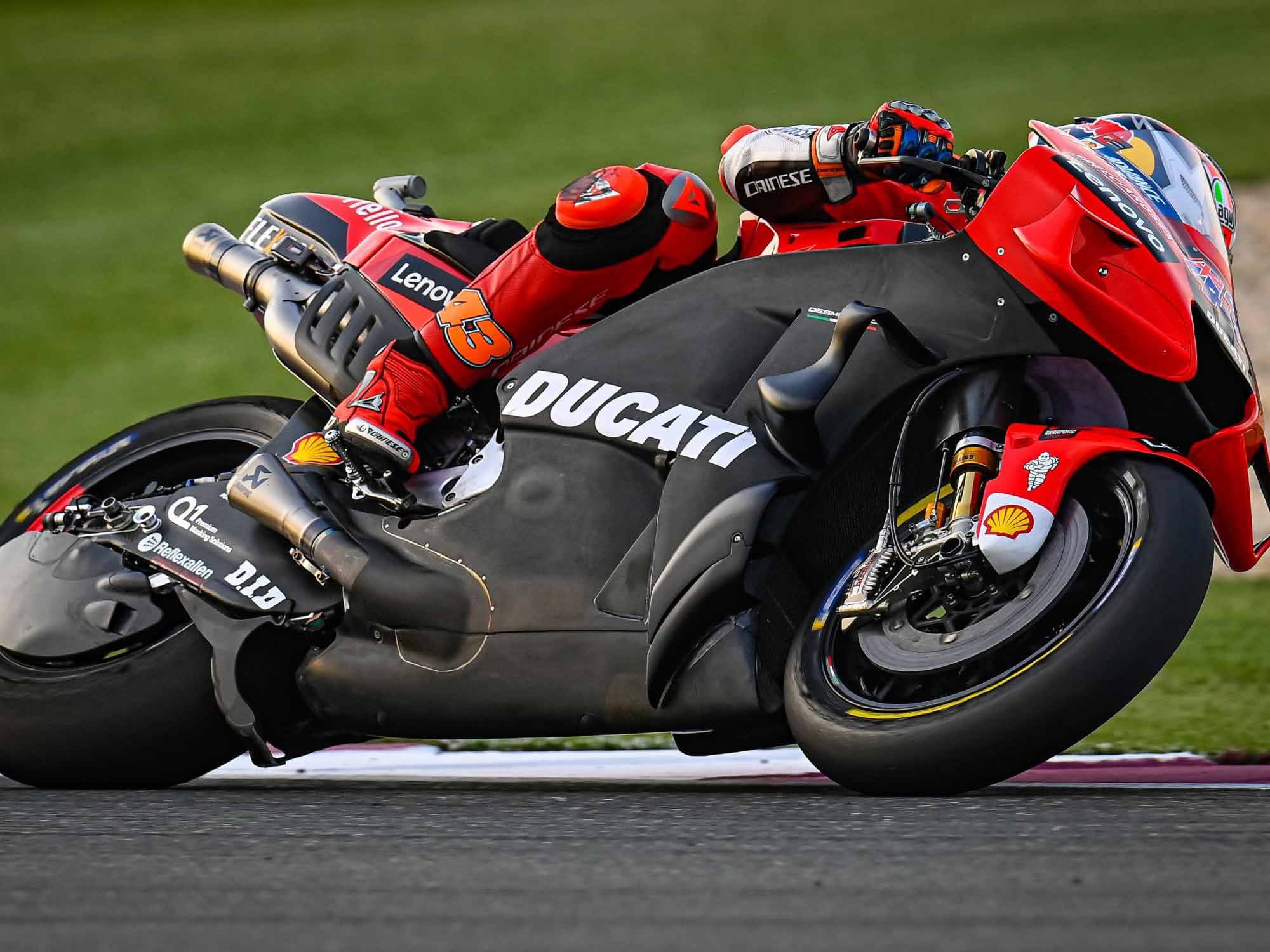
Carbon fiber wheel covers may produce measurable downforce while leaned over in corners. (MotoGP /)A right and left pair of “periscope scoops” pick up air at fairly low level and duct it into the space behind Ducati front wheels. We know from the ability of fast-moving bikes to vacuum dust up out of track texture that there is high air velocity and therefore low pressure (Bernoulli’s principle—air in motion loses pressure) immediately behind the tires. Low pressure behind a moving object is drag, so let’s just dump some air down there and see.
A frequent method of playing with such effects in the wind tunnel is to have the bike and rider on the balance and technicians with long poles standing off to the sides, out of the free jet. On the ends of those poles may be various vanes and other devices whose possible utility the aero people want to evaluate. On cue, a tech steps forward and with the pole places a “gadget” in the desired place. Is there an effect on drag? In the data cabin, techs-under-glass either nod or shake their heads.
My late uncle recalled to me being on a Boeing 707 PR flight in the mid-to-late ’50s and seeing engineers peering out the windows at stubby turbulators stuck to the wing’s upper surface, trying to make out their effects on areas of yarn tufts stuck by one end to the wing. Where the tufts whirl madly about, the flow is detached and turbulent. Where they lie down flat, the flow is attached and smooth. Computer Fluid Dynamics (CFD) has been around a long time now, but it lacks imagination. So the “play” described above is how aero people can get a direct feel for what the invisible air is actually up to (one of the “poles” emits a stream of smoke at the push of a trigger). Someone, somewhere, is writing the necessary checks to cover all this.
RELATED: Active Aerodynamics For Superbikes
Where might aero gains be made? One foggy morning in 1993 I watched first 500 practice at Australia’s Eastern Creek circuit. Nature’s excellent flow visualization scheme showed me that no bike had a smooth wake of the kind depicted in new-model brochures. All wakes were whirling masses of energy-sapping turbulence—I could clearly see engine power being converted into purposeless random motion and heat.
The post-dustbin-fairing FIM aero rules of 1958 require that the front tire be visible over 360 degrees, seen from either side. Yamaha has provided stationary smooth surfaces flush with the rim, guiding airflow to a fender-like structure that also includes telescoping fork tube fairings. Interestingly, the top of that long-suffering front tire is exposed.
Airflow around fork tubes continually sheds vortices (like the ones you feel on your body as you draft a boxy truck on your bike). The “wind in the wires” sound still used by Hollywood to tell us “airplane in big trouble” was originally caused by high-frequency vortex shedding from the bracing wires of World War I biplanes. As the vortices carry away energy they produce drag, but by giving them airfoil section (in the form of covers) vortex production is stopped. Taken as a whole, what Yamaha has done is to streamline the front wheel, which is illegal. So in order to legalize it, separate parts are used, each with a legal purpose, such as “fork tube stone guard,” “brake disc cooling vane,” etc.
Ducati’s 6 o’clock wheel sector covers may, as some claim, produce downforce at high lean angle, but more likely what they do is give guidance to airflow past the lower parts of the wheels by preventing the air from becoming disturbed by the moving wheel spokes.
So far, the biggest single source of drag on MotoGP bikes—the lack of an (illegal) aft fairing to recover energy from flow over the whole vehicle—has received little attention. Makers of leathers attempt with their “backpacks” to guide airflow from the rider’s helmet onto his back, but even today we see riders lift their butts in fast sections, as they have been taught to do in routine wind tunnel sessions. When flow over the rider’s back is separated and turbulent, the leathers tend to lift up and drag is high, so riders lift their butts until they can feel their leathers lie down on their backs, indicating that airflow is attached and that some energy recovery is taking place. For many years riders have spoken of seeing modest gains in rpm from this practice.
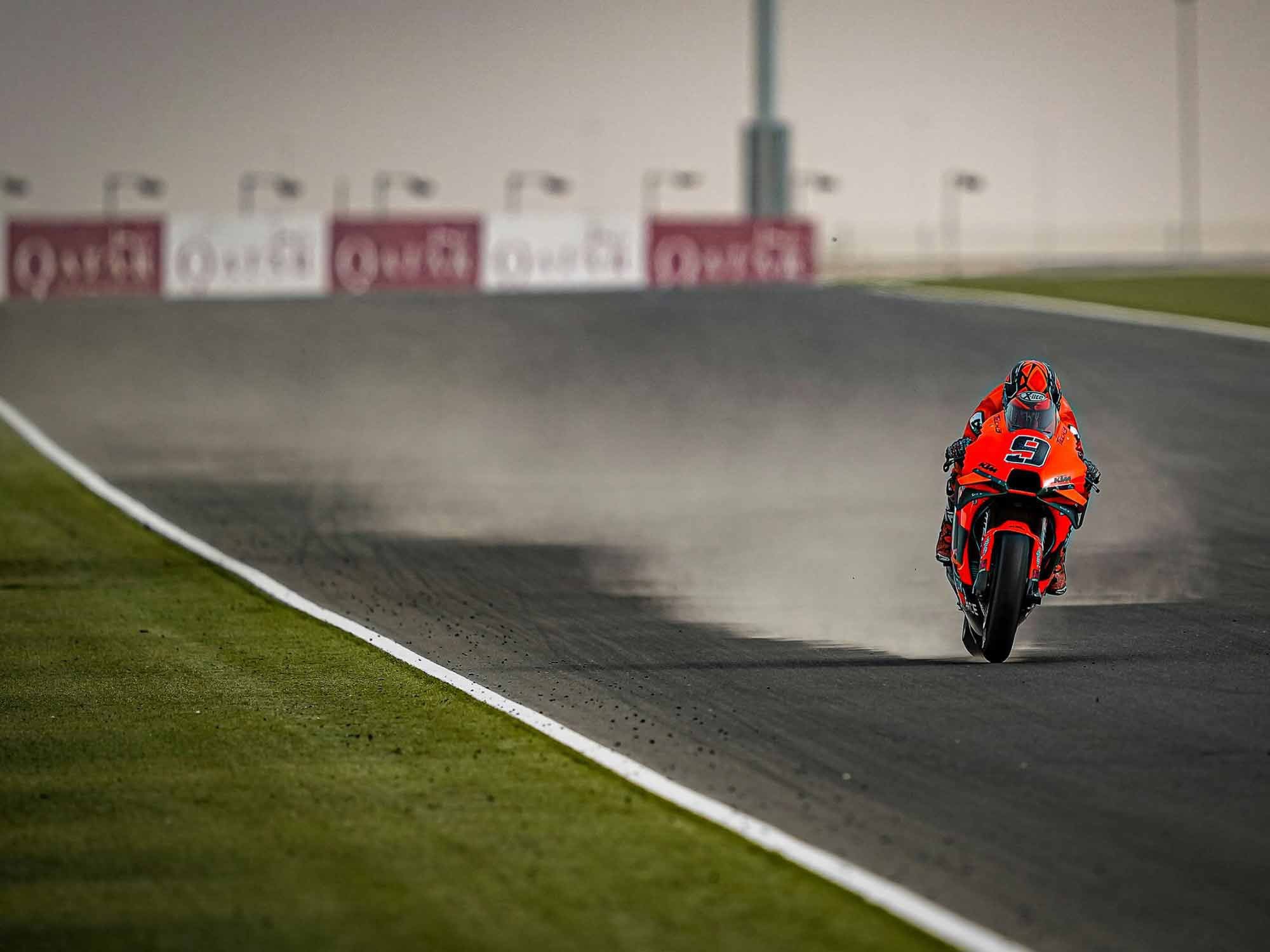
Sand deposited on Losail’s asphalt shows the turbulence left in the wake of a modern MotoGP racebike. (MotoGP/)Top views of the 2021 Ducati show the classic fish shape, widest at the front, with width decreasing toward the rear. Least desirable is a “snowplow” or arrow-point shape that, by pushing air outward as the vehicle passes, makes it act even wider than it actually is to the airflow. As in fish and aircraft, the tapering tail serves to recover energy from the flow, rather as squeezing a wet bar of soap can cause it to shoot out of your hand: attached airflow exerts inward pressure on the tapering tail, producing a net force that points forward. Not only do the 1958 rules prohibit aft streamlining, but the inherent shortness of motorcycles directly limits what can be done.
In the closely competitive trucking industry some progress has been made in reducing drag by stopping the shedding of energy-rich vortices. We see some fairly short tapering cargo box extensions now in use, and promising results have been had by placing retractable guide vanes, mounted on movable “poles” just as in wind tunnel play, where they can guide airflows smoothly back together as they stream past the aft end of the box. Such guide vanes have also been used in F1 to achieve specific goals.
Would such vanes-on-a-stick be legal, or would they have to be disguised as selfie pods or shamanic amulet carriers? Ducati’s Gian-Luigi Dall’Igna is surely exploring every avenue.
Another problem is cooling drag. It takes pressure to push cooling air through heat exchanger cores, past the exhaust pipes, over lumpy engine surfaces, and finally out through “gills” at the sides. Ducati is said to have discovered, in developing the Supermono of 1993, that releasing slow-moving heated air through such gills increases drag by effectively making the vehicle wider. Much thought has been given to this problem; one path that has been tried is to place the cooler(s) behind a diffuser. By decelerating air as it enters the bike, the air turns part of its energy into the pressure that can push it through the rad cores. The air is then re-accelerated before it’s allowed to rejoin the free stream. The problem is that a modern MotoGP bike is already so solid, with its engine, intake airbox, airbox ducts, and fuel so densely packaged, that there’s no room for such a thing.
RELATED: Honda Working On Rear End Aerodynamics
Ideally, a coolant radiator and its ducts are a low-grade jet engine. Take in air, add heat energy to it, and then eject it out the back at a higher velocity. De Havilland’s famed Mosquito aircraft reportedly not only canceled its normal cooling drag in this way, but may have actually produced net thrust.
How about starting with just one part of the job: efficiently decelerating cooling air as it approaches the faces of the coolers behind the front tire? Maybe the top of Yamaha’s new front fender and its two fork tube airfoils can function as a low-grade diffuser, reducing loss in this area?
Not enough room? Diffusers don’t have to be long and gently sloped. On the C-119 “Flying Boxcar” cargo plane, each engine’s nacelle diffuser is just over 9 inches long and widens at 25 degrees rather than the 7 degrees textbooks cite as “ideal.” Yet diffuser thrust is real; when NACA (which in 1957 became NASA) was developing diffuser nacelle technology, such a diffuser ring vibrated loose from its mounts, and its thrust drove it forward into the prop.
My point in going on about all this is that there’s plenty for Mr. Dall’Igna and his counterparts in the other teams to busy themselves with between now and when Dorna permits engine development to resume.
-
-
Hello Essem,
Welcome to The Motorbike Forum. Please feel free to browse around and get to know the others. If you have any questions please don't hesitate to ask.
Why not tell us a bit about yourself too.
-
Hello LeeC1982,
Welcome to The Motorbike Forum. Please feel free to browse around and get to know the others. If you have any questions please don't hesitate to ask.
Why not tell us a bit about yourself too.
-
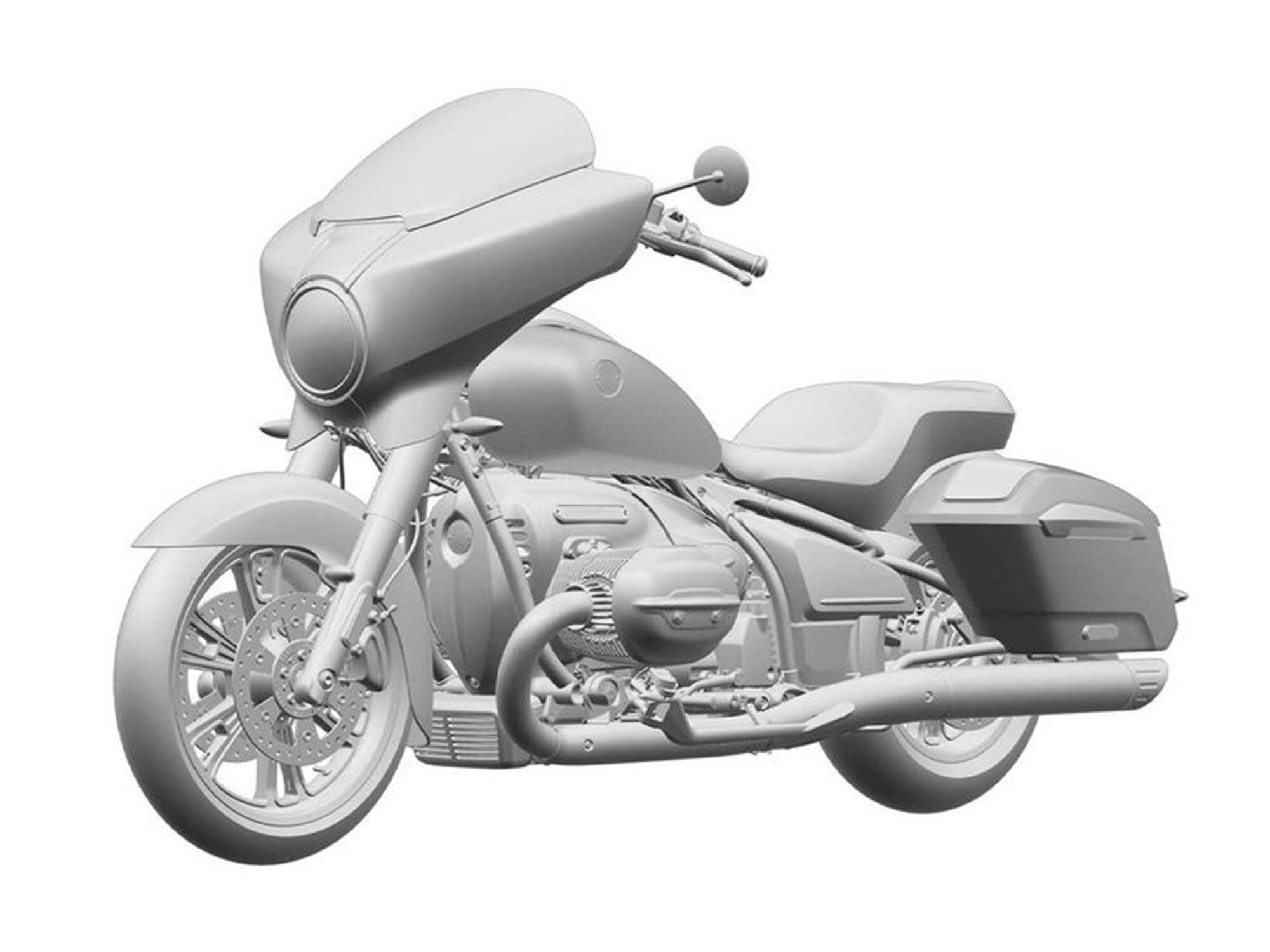
BMW will be expanding its R 18 series next year. The fairing-equipped R 18 B (shown) will be one of the models added for 2022. (BMW/)A year ago we revealed the design drawings for a bigger, bulkier bagger version of BMW’s new R 18, and now that bike has finally been confirmed as part of the company’s 2022 model range along with an even heavier model called the R 18 Transcontinental.
Newly filed emissions certifications published by the California Air Resources Board (CARB) show four versions of the R 18 will be in BMW’s 2022 range. The basic R 18 and its bags-and-shield R 18 Classic sibling will remain as they are today, but they’ll be joined by the R 18 B and R 18 Transcontinental.
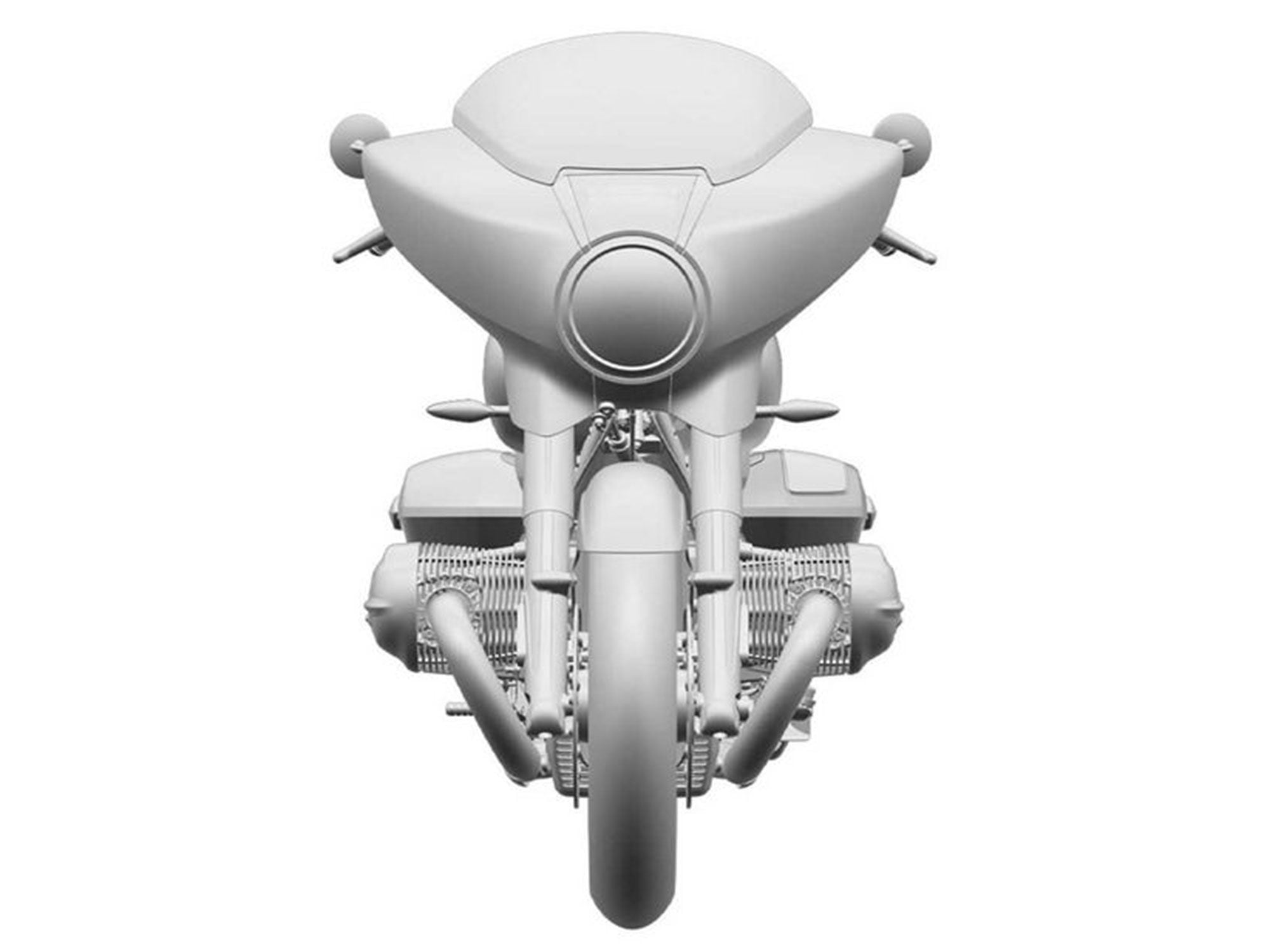
It’s likely the B will wield a full fairing and hard bags à la Harley’s Street Glide. (BMW/)While the new bikes share the same 1,802cc pushrod boxer twin engine with the existing R 18 variants, with identical emissions performance and hence the same power and torque figures (91 hp at 4,750 rpm and 116 pound-feet at 3,000 rpm), they’re both significantly heavier.
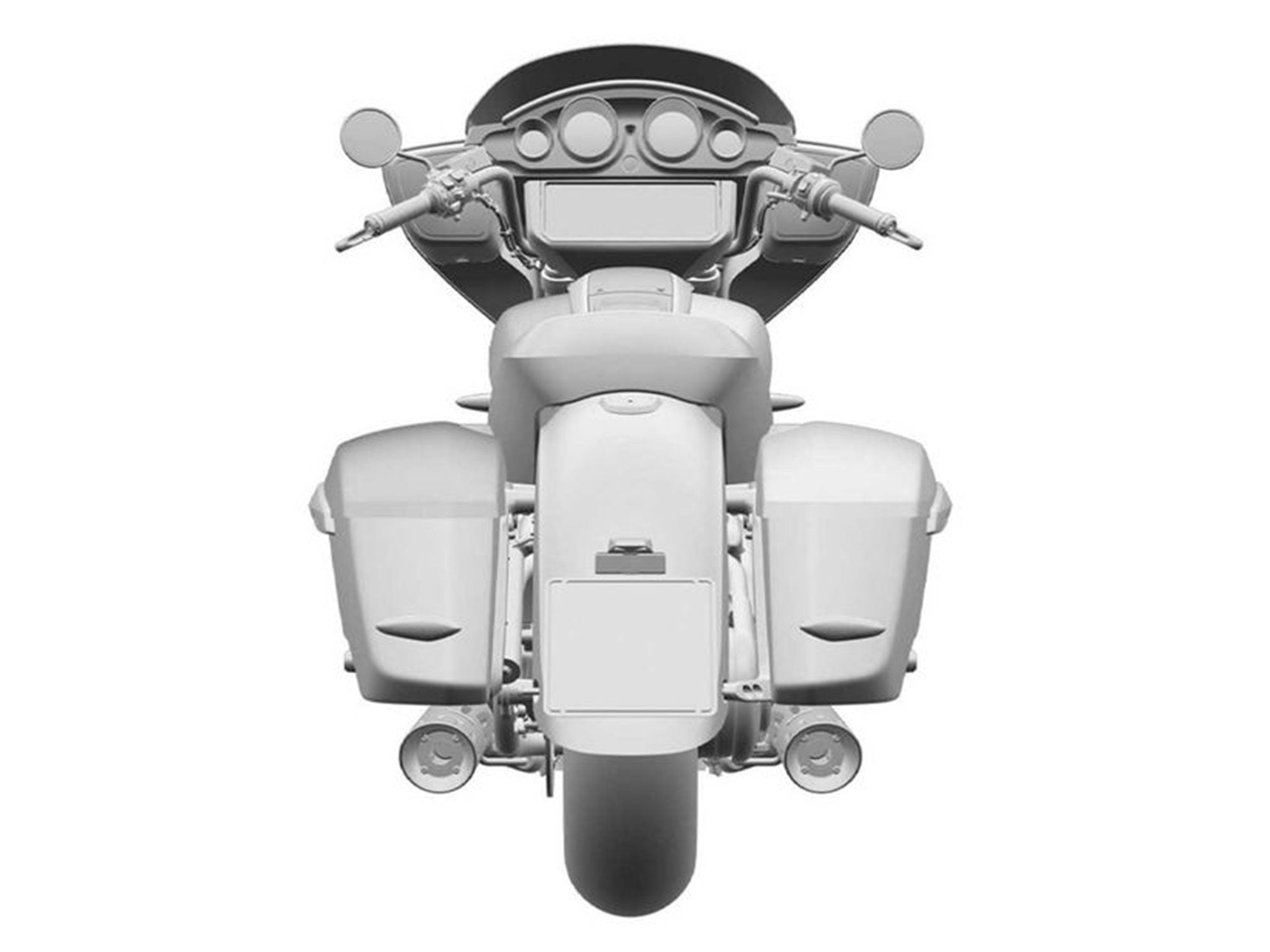
Rather than the base R 18′s solo gauge, the B will probably get a huge TFT touchscreen as well. (BMW/)Although CARB documents use an unfamiliar “EIM” (estimated inertial mass) measurement intended to represent the actual running weight of a bike including the rider, rather than the usual dry or curb weights we’re used to seeing on spec sheets, the differences between the models should translate. Under the EIM formula, the base R 18 comes in at 420 kilograms (926 pounds), while its quoted weight is 761 pounds fully fueled. That means the EIM calculation is adding 75 kilograms or 165 pounds for the rider. It’s the same for the R 18 Classic, with an EIM of 440 kilograms (970 pounds), compared to a spec sheet weight of 805 pounds.
RELATED: 2021 BMW R 18 First Ride
That means we can be pretty confident that the EIM weight for the new R 18 B—480 kilograms (1,058 pounds)—will translate to a fueled curb weight of 893 pounds. And the big boy of the lineup, the Transcontinental, which has an EIM of 510 kilograms (1,124 pounds), will be about 959 pounds fueled but without a rider.

Using the EIM formula to account for rider weight, it still appears both new models will be quite a bit heavier than the base R 18. (BMW/)In looking at the design drawings we revealed 12 months ago, it seems likely the R 18 B will be the version of the bike with hard bags, a larger tank, and a wide, bar-mounted fairing with a low screen. While the chassis and engine are shared with the normal R 18, the tank is significantly larger and every body panel is changed, with deeper fenders front and rear. On board, the normal R 18′s minimalist single gauge is replaced with a comprehensive set of dials above a massive TFT touchscreen. The bike’s bagger styling cues fit neatly with the “R 18 B” name, and the weight figure seems about right as well.
RELATED: BMW Unveils Production R 18 Cruiser
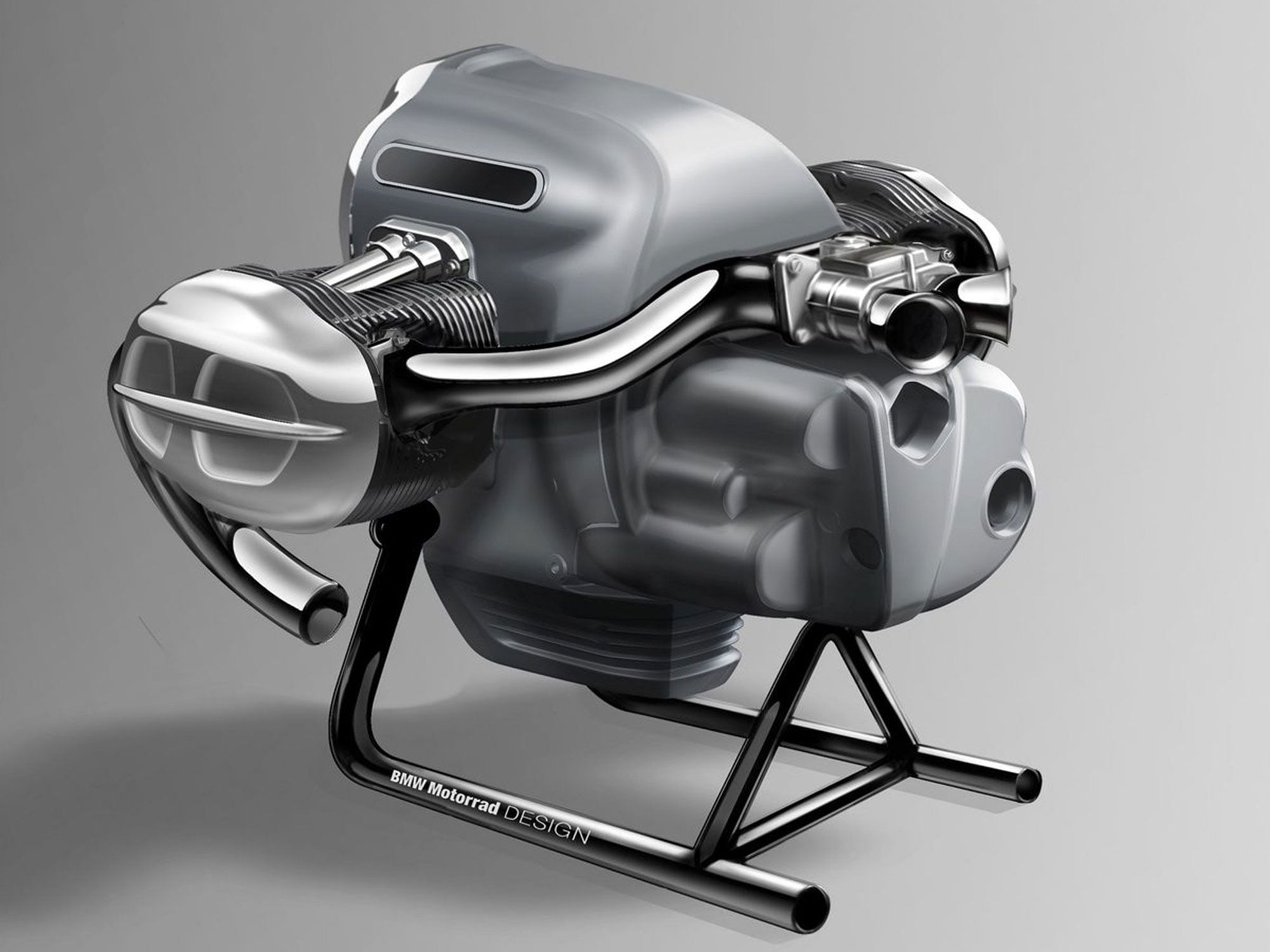
Both bikes will be powered by the same 1,802cc boxer twin engine on the first R 18 variants. (BMW/)That just leaves the Transcontinental. BMW filed trademark applications for the Transcontinental name in December of last year, and while we’ve yet to see that bike, it seems likely that it will be similar to the R 18 B but with a top case forming the backrest to a more comfortable pillion seat, plus a taller screen. BMW has also been seen testing the bike with a wart-like radar sensor mounted in the fairing above the headlight, showing that the radar-assisted adaptive cruise control that debuted on this year’s R 1250 RT will also be finding a home on the R 18 B and Transcontinental, at least as an option.
-

The 2022 Indian Chief Dark Horse in Alumina Jade below the Golden Gate Bridge in San Francisco. MSRP for this bike is $16,999. (Jeff Allen/)Minimalism is often the sign of a craft perfected; as master modern architect Ludwig Mies van der Rohe said: “Less is more.” To reduce, subtract, and refine until you are left with only what’s needed. To take away the clutter but not the spirit. In this case, to shave about 120 pounds and 4 inches off of the previous Chief model, refine chassis design, and produce a new motorcycle that can do more with less. The 2022 Chief Dark Horse is part of Indian Motorcycle’s first major update to the heavyweight cruiser lineup in a decade, but redesigning a Big Twin is treading on hallowed ground.
The two men leading design on this project are not only experienced and proven designers, but riders, customizers, and passionate motorcycle people. Ola Stenegärd is Indian’s director of Product Design following a 15-year career at BMW (an interview with Stenegärd will be coming soon here at Cycle World). His hand-built 1972 Shovelhead chopper, Forsaken, is one of my all-time favorite builds. Rich Christoph is the lead industrial designer for this rejuvenation of Indian’s flagship as he was on the Scout, FTR750, FTR1200, and Harley-Davidson’s Nightster. When I called Christoph he was in between restoring some 1920s farm equipment, his 1974 Kawasaki G3SS, and preparing to go ice racing the coming weekend. Both of them speak with the fervency that only comes from living one’s passions. They’re the type of people I want designing my motorcycle.

Ergonomics on the Chief Dark Horse were designed for riders 6 feet and under, but other models are made to accommodate taller riders. (Jeff Allen/)“When you do a classic American cruiser, one this simple and this clean, honoring the Indian name, I always fall back to Ola’s and my knowledge about the customer, what they’re going to want to do with it, and what makes a motorcycle stand the test of time,” Christoph says. “You have to be a rider. You have to be involved.”
There’s a raw beauty in the air-cooled American V-twin. The rumble of the engine and its space to move in the frame, which you can also see. It’s honest. It has to be. A rider has to look at the bike and see the potential for customization. This simplicity and space had to be maintained. “Everything starts with the frame,” Stenegärd says. “No pressed steel hiding where you can’t see it, nothing ugly appears when you lift the tank. The frame itself needs to be a piece of art.”
Every piece of the frame has some sort of curvature or flow to it. The welds are clean and nicely finished. Small details like recessed engine mounts show the time and attention paid to subtle but impactful features. The gooseneck and window created behind the steering head at the front of the frame is more a reference to V-twin customs with pulled-back gas tanks than it is to anything in Indian’s lineage, but it works. It works very well. The line from gas tank, through the seat, down through the shocks to the rear axle is, as Christoph said, simple and clean. And, as intended, being able to see so much of the tubular steel frame has my mind spinning as I consider custom potential.

Base-model Chief, Chief Bobber, and Super Chief models come with a standard Thunderstroke 111, while Dark Horse and Limited variants get the larger 116. (Jeff Allen/)Powering the Dark Horse is Indian’s Thunderstroke 116, an engine that I have put about 15,000 delightful miles on since 2019. For 2022, the 1,890cc, two-valve-per-cylinder, pushrod twin has been slightly modified for the entire air-cooled Indian line, adding frame mounts to the front cylinder to increase the chassis’ torsional rigidity, and slimming down the primary cover to make a little more room near the rider’s left foot. New throttle maps, Rain, Sport, and Standard, were also designed for the Chief application, specifically to meet Euro 5 emissions standards and work with the new intake and exhaust setups.

The 4-inch touchscreen display serves as the information center for the Chief, offering GPS, Bluetooth smartphone connectivity, and more. (Jeff Allen/)Cruising along at 70 mph, the engine spins an effortless 2,500 rpm. Shifting is smooth and definite. The open-road origins of the Thunderstroke are clear as the Big Twin purrs along down the highway.

On city streets or open roads, the Chief Dark Horse quickly finds its stride. (Jeff Allen/)The air-cooled 49-degree V-twin pulses in the frame, giving the rider the connected feeling that is so important in the cruiser riding experience. But the ride-by-wire and throttle sensor placement result in a vague throttle feel that leaves something to be desired. The clutch feel is also barely existent, so it took some getting used to before I could achieve hard launches in Standard or Sport modes without spinning the tire.
The new Chief family consists of three models, Chief, Chief Bobber, and Super Chief. Each model is offered in base trim with a Thunderstroke 111, as well as a Limited or Dark Horse version with chrome or black trim, respectively, and the Thunderstroke 116 engine. The Super Chief is Indian’s more touring-oriented model with 16-inch spoked wheels, swept-back bars, a pillion seat, soft saddlebags, floorboards, and a quick-detach windscreen. For those looking for a more traditional cruiser seating position, the Bobber comes with the same 16-inch wheels, forward foot controls, and mini ape handlebars. With drag racing-inspired handlebars, solo seat, and mid-mounted foot controls, the base-model Chief and Chief Dark Horse have the most aggressive, stripped-down aesthetic and ergonomic package of the lineup.

Window in front of the gas tank. (Jeff Allen/)In the center of the Chief’s handlebars a new, circular, 4-inch Ride Command display serves as the bike’s control center. Navigation, gear indicator, speedometer and tachometer, music through Bluetooth, caller ID, and more are displayed on the touchscreen, navigated with an easy-to-use joystick near the left thumb. Best of all, when the bike is off, it doesn’t look like a big screen, just a normal, classic round gauge.
Each Chief model comes with Pirelli Night Dragon tires, a solid improvement over the Metzeler Cruisetecs on previous models. While they admittedly trade high mileage for grip, the spirit of the Dark Horse tells you to carpe that diem and throw caution to the wind. Like all air-cooled Indian models, traction control is not an option, so with a claimed 120 pound-feet of torque on a 672-pound bike (measured ready-to-ride on our scale), the added grip is very much appreciated.
The Chief’s ZF-manufactured suspension offers remarkable performance. The fork is plush but stayed tight and consistent throughout even our most extreme testing, with minimal brake dive and smooth rebound. The shocks, despite their short 3-inch travel, were also impressive, making everything but the largest bumps disappear, and again, smooth and consistent compression and rebound give the Chief a planted feel, even when maneuvering cut-up canyon roads with haste.

A single 300mm disc brake mounts on a 19-inch cast wheel up front. (Jeff Allen/)A 29-degree rake on the Chief had me skeptical, but with 5.2 inches of trail, it has surprisingly neutral and responsive handling. The center of gravity is low, giving it a nimble and well-balanced feel. At speed, the Chief easily drops into turns, follows the intended line, and straightens back out with low effort at the bars. At parking lot speeds, the same balanced feel remains, though the vague throttle and clutch feel make precise application challenging at first.
Despite a listed spec of 28.5 degrees of maximum lean angle, I was able to push the Chief through mountain roads quickly, only very slightly limited by scrape points. Mid-controls make it easy to shift your weight for real canyon carving, and footpeg feelers give enough warning before scraping hard parts (frame on the right, kickstand on the left). The Pirellis are, again, very appreciated. I found myself pushing the Chief harder and harder trying to get it out of its comfort zone, and it was not an easy task.
While the single front disc brake doesn’t really hit the performance-oriented aesthetic, it does function more than adequately. Good feel through the lever and well-tuned suspension make precise brake application and hard stops easy.

A moment of solitude along the California coastline while enjoying the Chief on winding roads. (Jeff Allen/)The solo seat on the Chief, despite being somewhat small for the class, is exceptionally comfortable. I remarked on it several times in testing, never getting sore or achy there. At 6-foot-4, I was cramped on this model, but only felt some discomfort in my hip flexors during longer stretches on the highway.
The Chief walks the line of modern, luxurious amenities, the electronic clutter that comes with them, and classic minimalistic design. You can see the Indian logo cast into the neck of the frame, but a thick wiring loom from the display hangs down to obstruct that charming window view. The engine rouses itself with a satisfying rumble, but only after you hit the power switch, hear the whistle of the fuel pump, wait for the screen to turn on, and then hit the ignition. Large plastic covers hide electronics beneath the seat. They are slight compromises in an otherwise tight and tidy machine, but they do exist.

Minus about 120 pounds and 4 inches from previous models, the new Chief is a much more versatile beast. (Jeff Allen/)Customization has been built into the Chief in more than just its inspirational design. Parts will fit across all three models. Exposed shocks, though they function beautifully, can easily be replaced to adjust ride height and performance. The tubular steel frame can adapt aftermarket gas tanks, or be cut and welded for those serious about customization. Exposed risers open up handlebar options. There is great potential here.
When Harley-Davidson canceled the Dyna line to expand new Softails in 2018, there was a void left in the cruiser market. As high-performance customs continue to trend in this space and American V-twin racing quickly gains popularity, the Chief’s clean, simple layout presents itself as an excellent candidate for performance-oriented customization. With a solid chassis and upgrades already available for the Thunderstroke engine, the platform is there; time will tell how the aftermarket accepts it.

The angle of the Chief’s rear shocks helps to continue the visual line of the frame to the rear axle. (Jeff Allen/)The approach to the new Chief is honest, but modern. The bike is built to ride hard and it feels that way. It’s sturdy, simple, steel. Riding the bike is an incredible experience and Indian has truly brought a new level of competition to the heavyweight cruiser segment. By prioritizing the customer, valuing their legacy, and holding steadfast through homologation, Stenegärd and Christoph have helped Indian keep the soul and produce a new American icon.
2022 Indian Chief Dark Horse Specs
Engine Type: Air-cooled V-twin Displacement: 1,890cc Bore x Stroke: 103.2 x 113.0mm Compression Ratio: 11.0:1 Valve Train: Pushrod, 2 valves/cylinder Transmission / Final Drive: 6-speed/belt Claimed Torque: 120 lb.-ft. @ 2,900 rpm Fuel System: Closed-loop fuel injection w/ 54mm throttle bodies Clutch: Wet, multiplate Frame: Tubular steel Front Suspension: ZF Suspension 46mm telescopic fork; 5.2 in. travel Rear Suspension: Dual ZF Suspension shocks, preload adjustable; 3.0 in. travel Front Brake: 4-piston caliper, 300mm semi-floating disc w/ ABS Rear Brake: 2-piston caliper, 300mm floating disc w/ ABS Wheels, Front/Rear: Cast; 19 x 3.5 in. / 16 x 5 in. Tires, Front/Rear: Pirelli Night Dragon; 130/60B-19 / 180/65B-16 Rake / Trail: 29.0°/5.2 in. Wheelbase: 64.0 in. Ground Clearance: 4.9 in. Seat Height: 26.0 in. Fuel Capacity: 4.0 gal. Claimed Dry Weight / Measured Wet Weight: 647 lb./672 lb. MSRP as tested: $16,999 
Like a postcard, Indian’s new Big Twin sits before a silhouette of the Golden Gate Bridge in the background. (Jeff Allen/)Gear Box
Helmet: Hedon X Bike Shed Heroin
Jacket: Vanson Stormer
Pants: Tobacco Selvedge Riding Jeans
Boots: Red Wing 218 LoggerMax
Gloves: Velomacchi Speedway Gloves
-
-
-
Hello Frodo,
Welcome to The Motorbike Forum. Please feel free to browse around and get to know the others. If you have any questions please don't hesitate to ask.
Why not tell us a bit about yourself too.
-
Hello Avocado,
Welcome to The Motorbike Forum. Please feel free to browse around and get to know the others. If you have any questions please don't hesitate to ask.
Why not tell us a bit about yourself too.
-
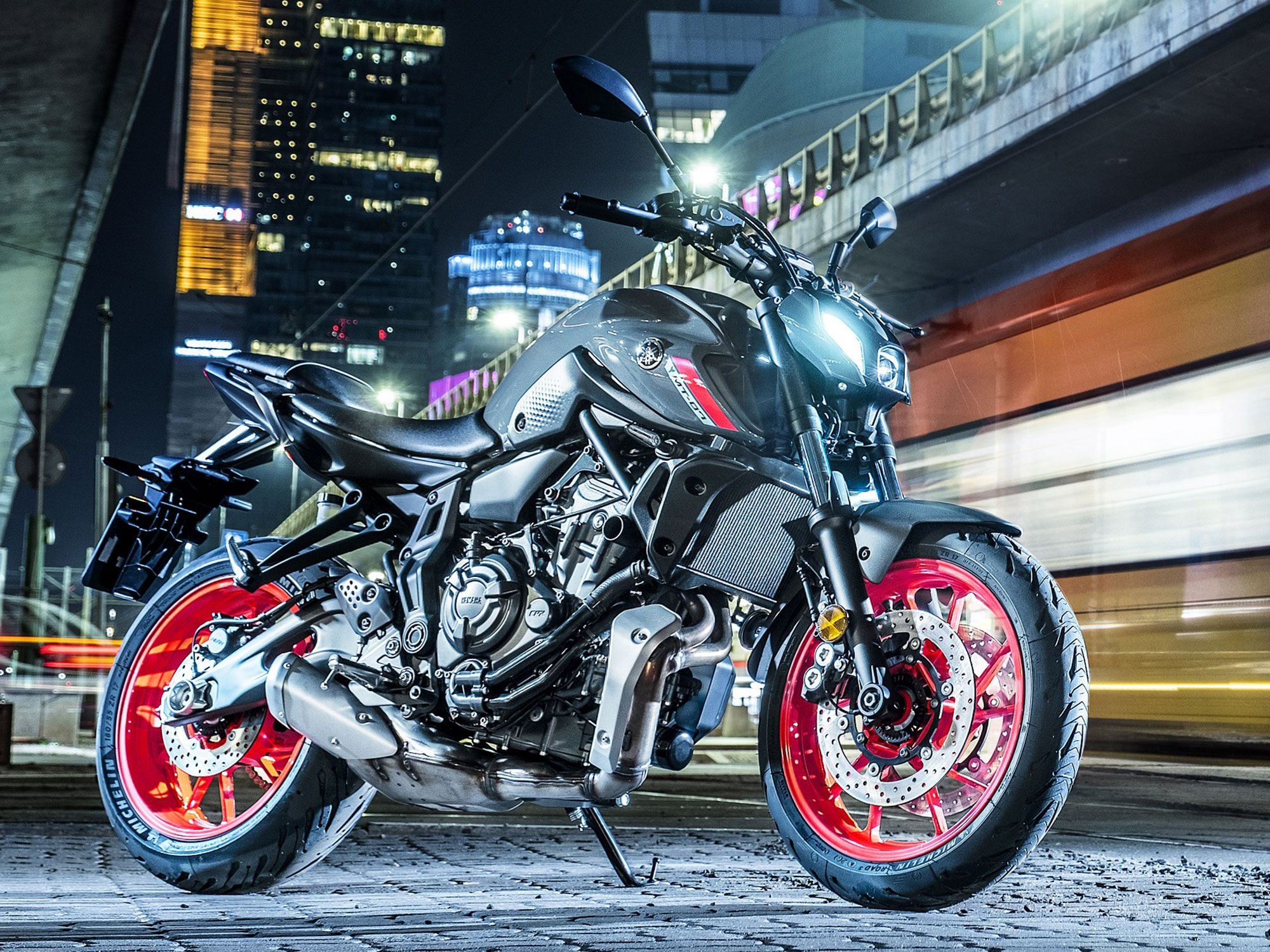
It’s confirmed: Yamaha will have a YZF-R7 for 2022, likely using the MT-07′s (shown) 698cc parallel-twin engine as a foundation. (Yamaha/)It might never have won the WSBK title that it was designed specifically to conquer back in the day, but Yamaha’s 1999 YZF-R7 is high on the most wanted list when it comes to superbike exotica. For 2022 it’s now confirmed that the name is returning to the Yamaha range, though it will be attached to a much more attainable, MT-07-based sportbike.
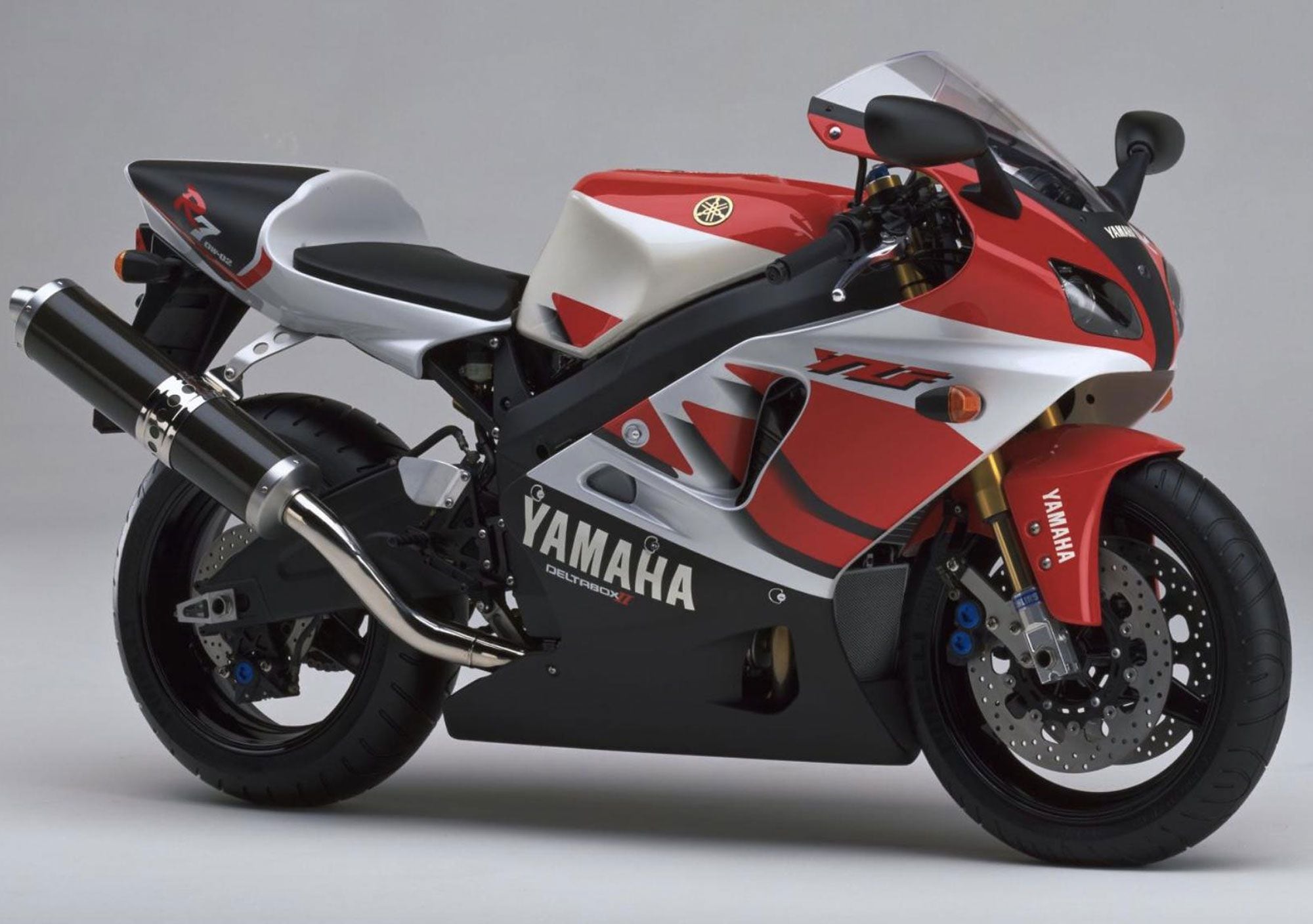
The original YZF-R7 from 1999 packed a 749cc four-cylinder mill, so the new bike should be substantially tamer—and less expensive. (Yamaha/)With the YZF-R6 missing from the 2021 lineup, for the first time in decades Yamaha hasn’t got a midrange supersport model in its armory. There’s the YZF-R3, and then the YZF-R1, but no intermediate step, and that’s an intimidating leap for even the boldest of inexperienced riders. Whereas 600cc fours used to provide an invaluable transition in the sportbike learning curve, there’s relatively little in that section of the market now. The rapturous reception awarded to Aprilia’s new RS 660 shows there’s appetite for such machines, and even if an MT-07-based YZF-R7 might sound like a poor substitute for the full-fat original, it could still prove to be a huge draw bringing sportbike fans to the Tuning Fork brand.

These CARB filings show Yamaha putting two YZF models down for certification, though the differences are likely just color options. (Yamaha/)The confirmation of the new bike, which has been rumored for some months, comes via a new filing with the California Air Resources Board (CARB). In the latest batch approvals added to the list of upcoming 2022 models lie two registrations for the YZF-R7—“YZFR7NCB” and “YZFR7NCL” are actually identical filings, with the difference expected to be the color schemes. The final “B” in the designation probably refers to Raven Black, while the letter “L” means Team Yamaha Blue.
In terms of specs, the CARB filings don’t give much away, but the emissions performance of the 689cc parallel twin is identical to that of the latest 2021 MT-07, which means it’s a safe bet that the power and torque levels will also be unchanged. That means we’re looking at a peak of 72.4 hp at 9,000 rpm, with torque maxing out at 49.4 pound-feet at 6,500 rpm. For comparison, the original 1999 YZF-R7, for all its legendary status, made 105 hp at 11,000 rpm and 53.5 pound-feet at 9,000 rpm—pretty unspectacular numbers by today’s standards, even if they still beat those of the new 2022 model.
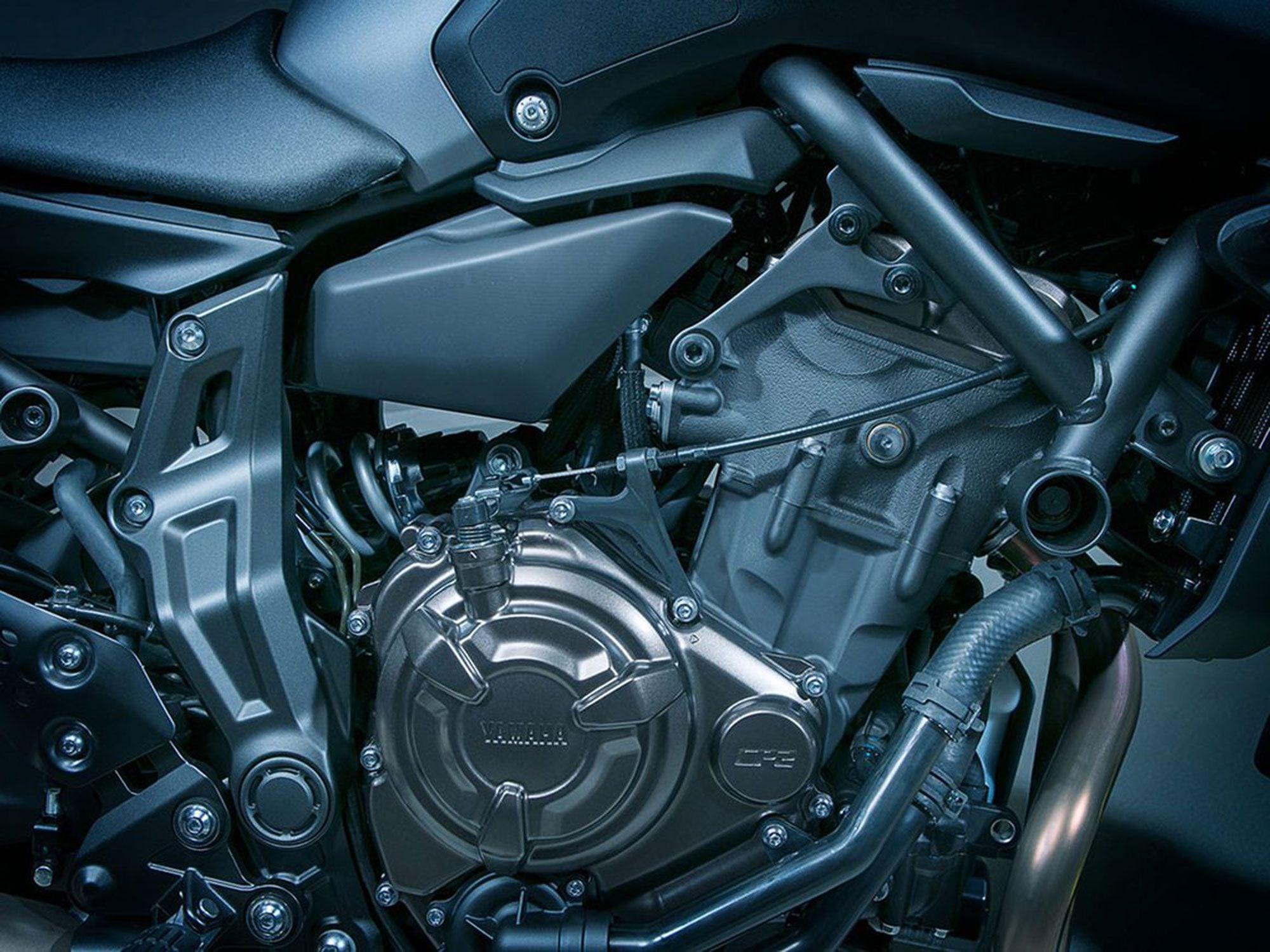
The MT-07′s lower-revving crossplane parallel twin will power the new YZF-07. (Yamaha/)Of course, with a lower-revving and emissions-friendly 689cc twin rather than the screaming 749cc four of the original, the 2022 bike is never going to be able to achieve the same performance, but neither will it be anywhere near as expensive or exclusive. Presuming it carries over the MT-07′s chassis as well as its engine, simply wrapping it in full-faired bodywork and adding dropped bars and rearset pegs, the price isn’t likely to be too far removed from the MT’s $7,699.
The evidence that the chassis will be carried over comes from the fact that the weight listed on the CARB documents is again identical to that of the MT-07. While CARB uses an unusual weight formula that’s intended to represent a typical inertial mass of the bike including a rider, the resulting figure it gives is 280 kilograms (617 pounds). In more familiar terms, with no rider included, that means we’re looking at a machine that weighs around 406 pounds wet.
Although it’s listed as a 2022 model, the fact that Yamaha has already put the YZF-R7 down for certification could be an indication it’ll arrive sooner rather than later. It’s currently the only 2022 bike that Yamaha has had certified, so we wouldn’t be surprised if it gets an early launch.
-
Hello motoman,
Welcome to The Motorbike Forum. Please feel free to browse around and get to know the others. If you have any questions please don't hesitate to ask.
Why not tell us a bit about yourself too.
-
-
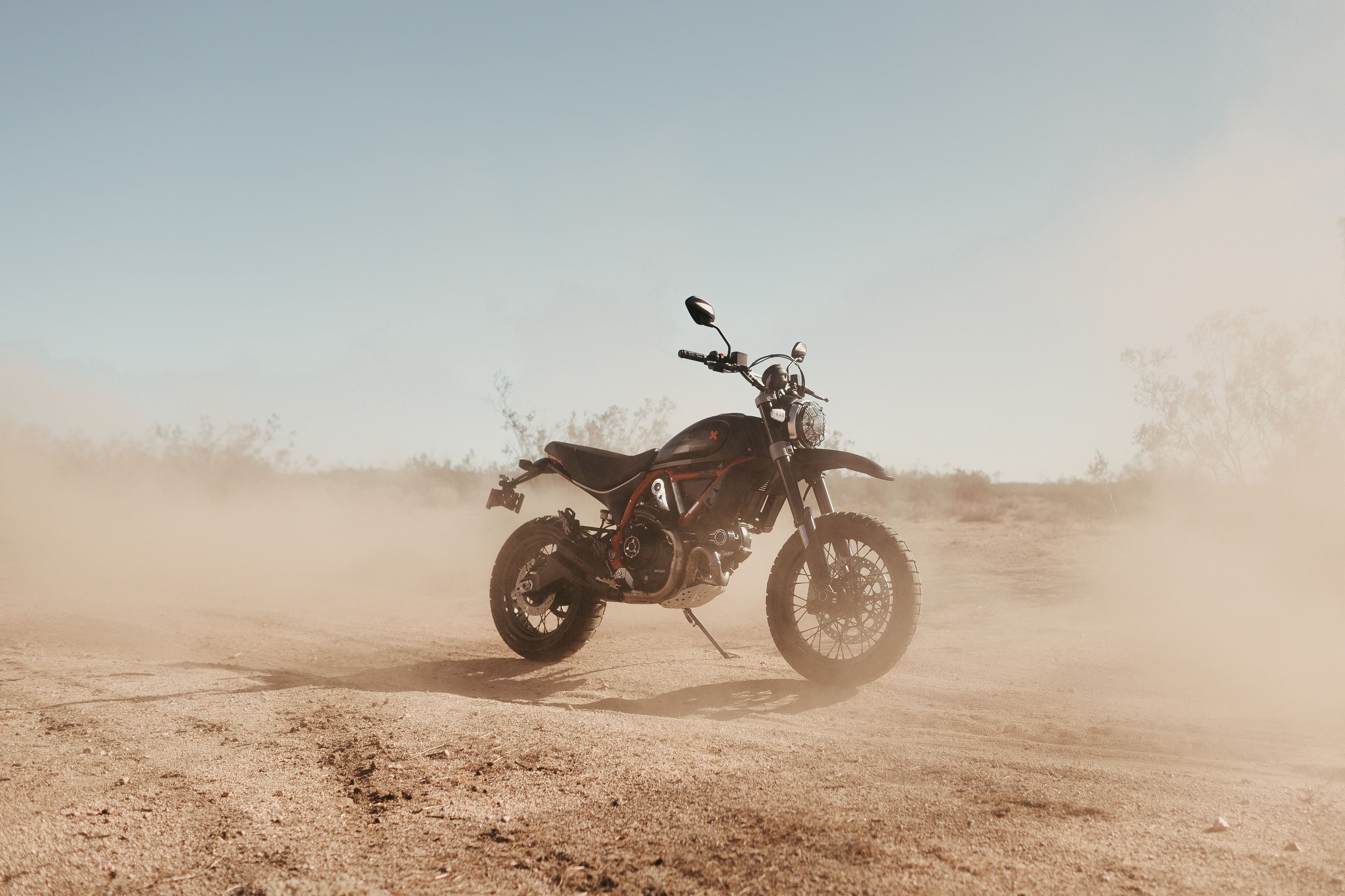
The 2021 Ducati Scrambler Desert Sled Fasthouse. (Ducati/)In celebration of Jordan Graham’s victory at the 2020 Mint 400 desert race, Ducati is introducing the 2021 Scrambler Desert Sled Fasthouse. Limited to just 800 units, the Desert Sled Fasthouse is individually numbered and shares the same red frame and livery as the racebike.
The Desert Sled Fasthouse, like the standard model, runs a 19-inch front/17-inch rear setup with adjustable Kayaba suspension, providing 7.9 inches of travel. The engine is the same classic 803cc air-cooled engine as found throughout the Scrambler 800 range, which Ducati claims produces 73 hp and 49 pound-feet of torque. Unique to the limited-edition model is a new seat cover and black spoked wheels. MSRP is $12,295 ($300 more than the standard Desert Sled).
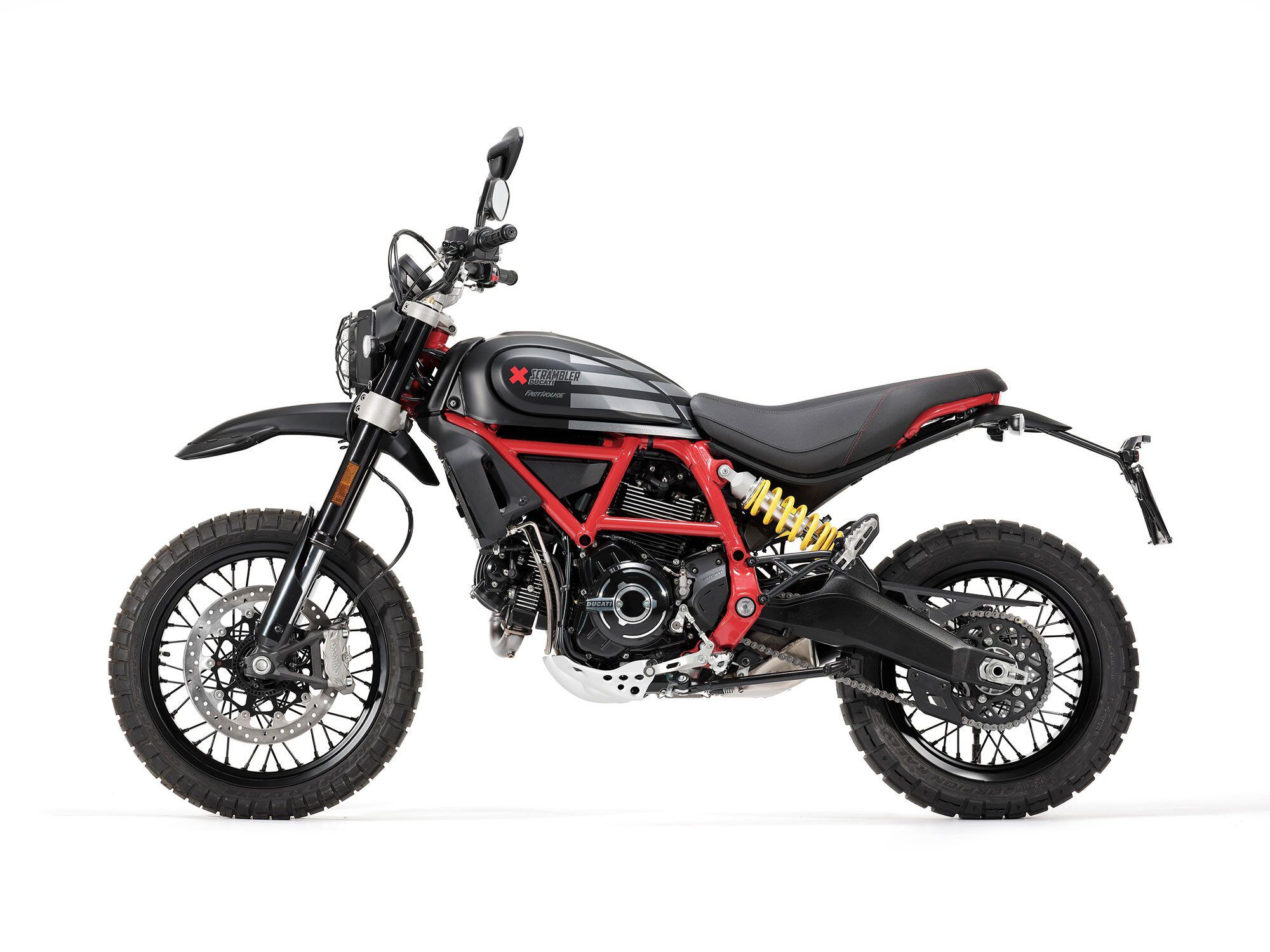
In 2020, Ducati teamed with SoCal moto apparel brand Fasthouse for the Mint 400, the famous desert race in Nevada that provided the backdrop to Hunter S. Thompson’s seminal <em>Fear and Loathing in Las Vegas</em>. (Ducati/)Over the years, Ducati has released many tribute replicas, like the Bayliss, Bostrom, Hayden, and Fogarty replica superbikes, but this is the first time the Scrambler sub-brand has had a go at celebrating one of its famous sons—or more exactly, a specific achievement. So while it’s not expressly a Jordan Graham replica, it kind of is, isn’t it? I mean, if he hadn’t won the Mint 400 and successfully campaigned the black and red Sled in the National Hare and Hound Association (NHHA) Hooligan series, there wouldn’t be much to celebrate, would there?
Sure, the Fasthouse Sled basically just sports a cool color scheme, but it’s very much a homegrown-in-the-USA model, which for American Ducatisti is very cool. A 21-inch front wheel and 18-rear wheel would have been cool to more closely resemble Graham’s racebike, but that would have meant some serious R&D rather than a color treatment.
The Desert Sled Fasthouse—and indeed the entire Mint 400 project and collaboration with Fasthouse—was driven by Ducati North America and its desire to showcase a more serious side of The Land of Joy. 2020 was the inaugural year for the Hooligan class in the Mint 400, and the honchos at Ducati NA saw it as an opportunity to make a little of their own history. They told Graham to play it safe and just finish. He had other ideas, crossing the line 45 minutes ahead of the second-place finisher.
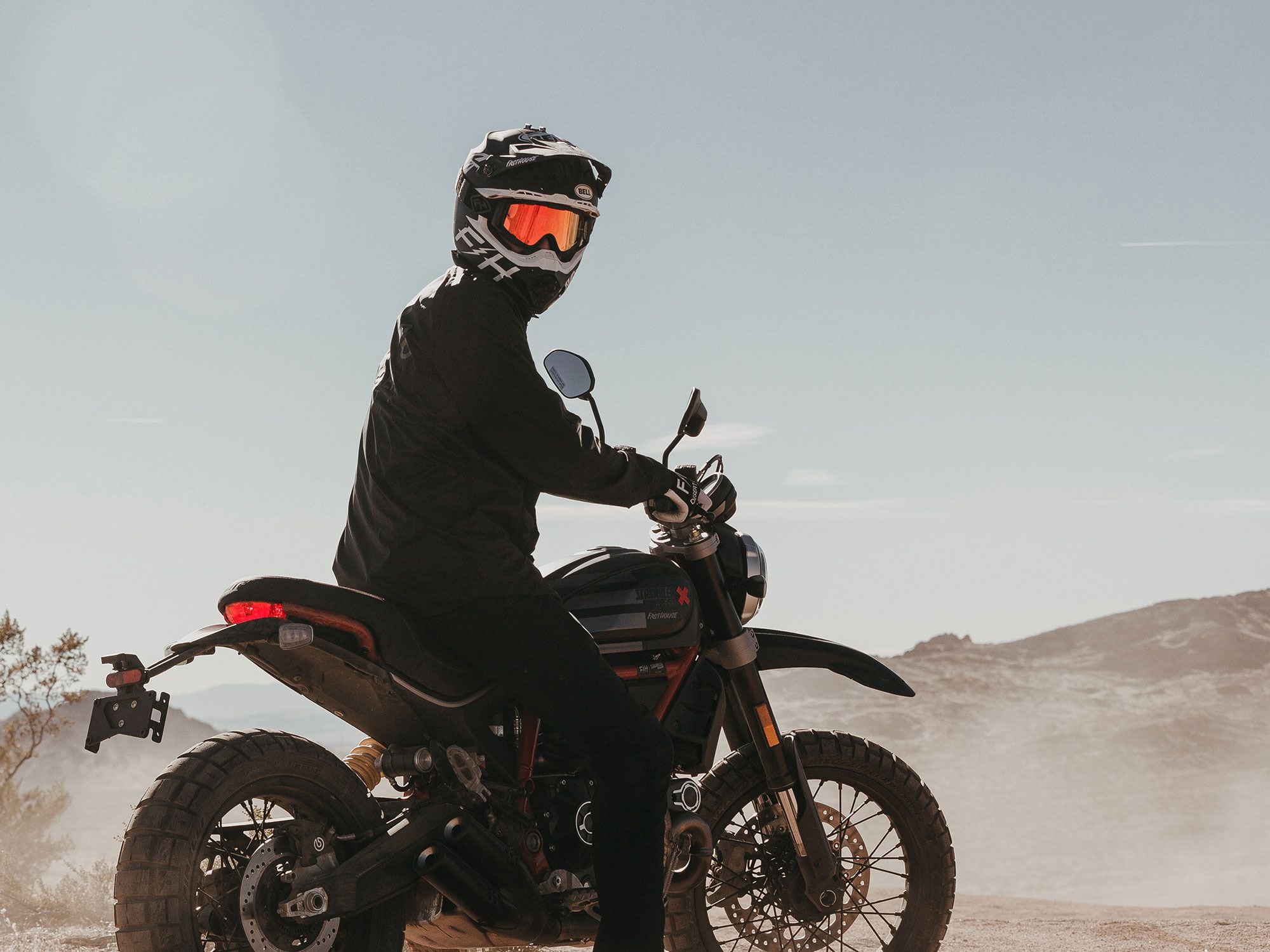
Fasthouse’s paint scheme is reborn in production form. (Ducati /)It’s not the first time Ducati’s American contingency spurred its padrones back in Italy to take the Scrambler seriously. Back in the 1960s, the Berliner Motor Corporation, Ducati’s US distributor at the time, pressed the factory to produce a scrambler-style motorcycle for American riders. And the rest, as they say, is history.
In anticipation of the release of the Desert Sled Fasthouse, I gave Graham a call to see if he was getting excited about seeing a bike that had until now been essentially “his bike.”
If anyone’s ever been excited to share his steed with 800 other riders, it’s Graham, who is as evangelical about motorcycles as the entire cast of On Any Sunday.
While Graham is supported by Ducati, his affection for the Desert Sled is completely genuine (he owns two himself): “I have a ton of people on Instagram DM me or email me, and they’re like, ‘Hey, should I really buy a Desert Sled?’ And talking to them months after, they’re like, ‘I’m so glad I bought this and not a dirt bike.’ It’s something you can actually ride on the highway, and realistically you don’t have to service it like a new dirt bike.”
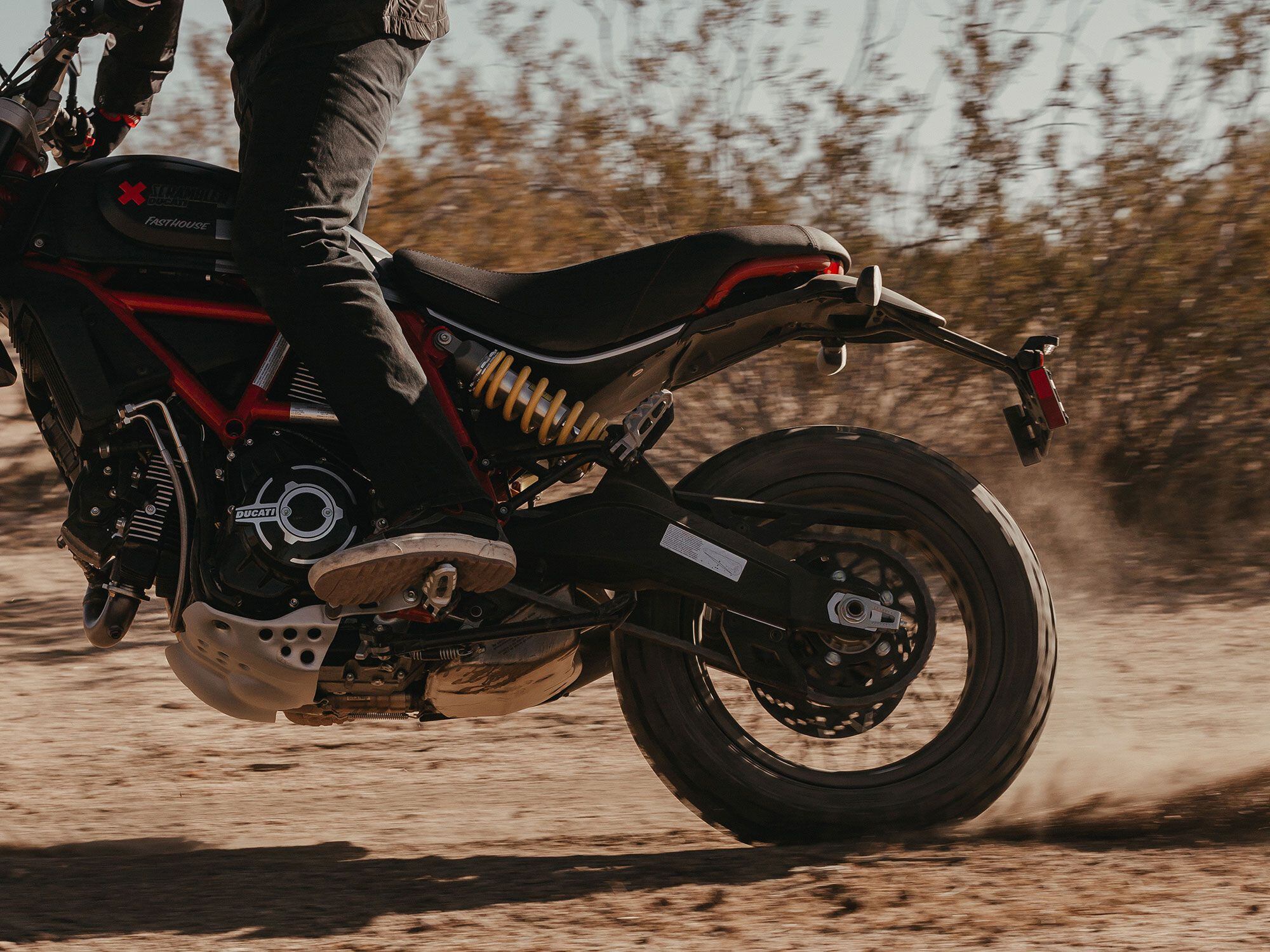
The Desert Sled Fasthouse runs Pirelli Scorpion Rally STR tires. (Ducati/)While Graham’s racebike is fitted with 21-inch front/18-inch rear knobbies, a high-mount Termignoni exhaust, aftermarket suspension, an Earle Motors swingarm extender, and a few other goodies, in all significant ways it’s basically a stock Desert Sled. He’s used to flogging his racebike or his own custom Icon, but Graham was pretty thrilled to spend a day shooting promotional footage of the production Desert Sled Fasthouse.
“The bike just got off the boat from Italy the day before,” Graham says, “and I absolutely flogged the thing all day long and it put up with the abuse. The first thing I did was unhook the ABS and zip-tie it to itself. I was riding the thing really hard and putting it through the paces. I was doing ridiculous hill climbs, drifting in lake beds, and hitting whoops and it was pretty rad to do on a streetbike.”
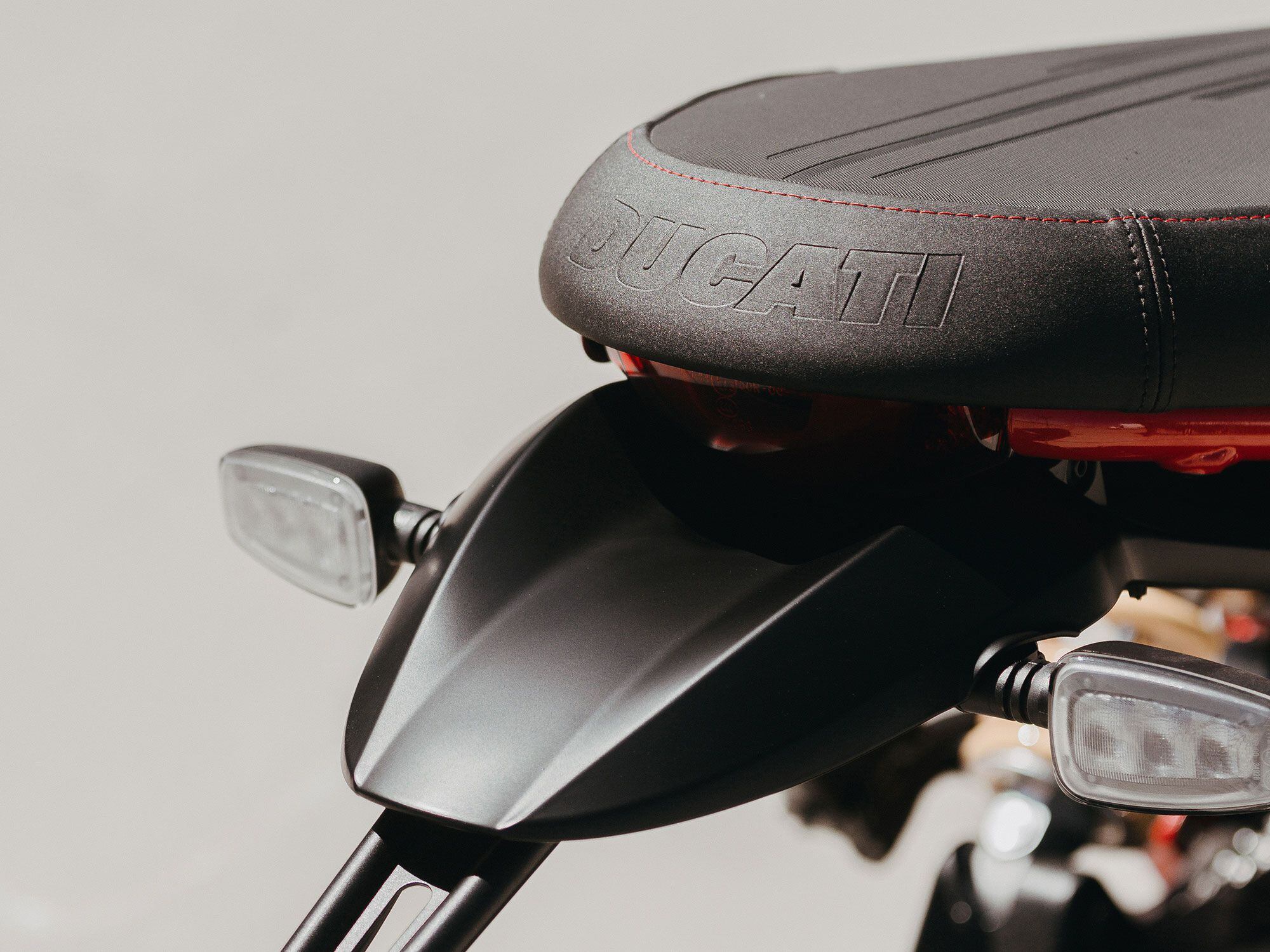
Bespoke seat cover. (Ducati/)Understand, Graham’s skills behind the bars far eclipse the typical rider’s—for the average person, trying to drift in lake beds would end in a skyward trip over the bars and an abrupt landing. But Graham’s point is valid: scramblers—of any make—have long service intervals like every other streetbike—7,500 miles until the first valve adjustment on the Desert Sled, for instance. They’re designed for regular road riding and they’re able to keep the fun alive when the pavement ends. Plus, scramblers have a timeless sense of laid-back style that modern dual sports and ADV-tourers, as great as they are, just can’t match. The Desert Sled Fasthouse, maybe more than anything, is about the spirit of the thing—the spirit of desert racing, of good-time retro vibes, and a hint of possibilities. After all, that’s all it took to inspire a couple folks at Ducati NA to decide to go desert racing.
So you don’t have to ride like Jordan Graham to have a good time. In case you can ride like him and want to drift through lake beds and hit whoops all day, Graham makes a point of saying you can always have 21/18 wheels re-laced on the stock hubs. So there you go.
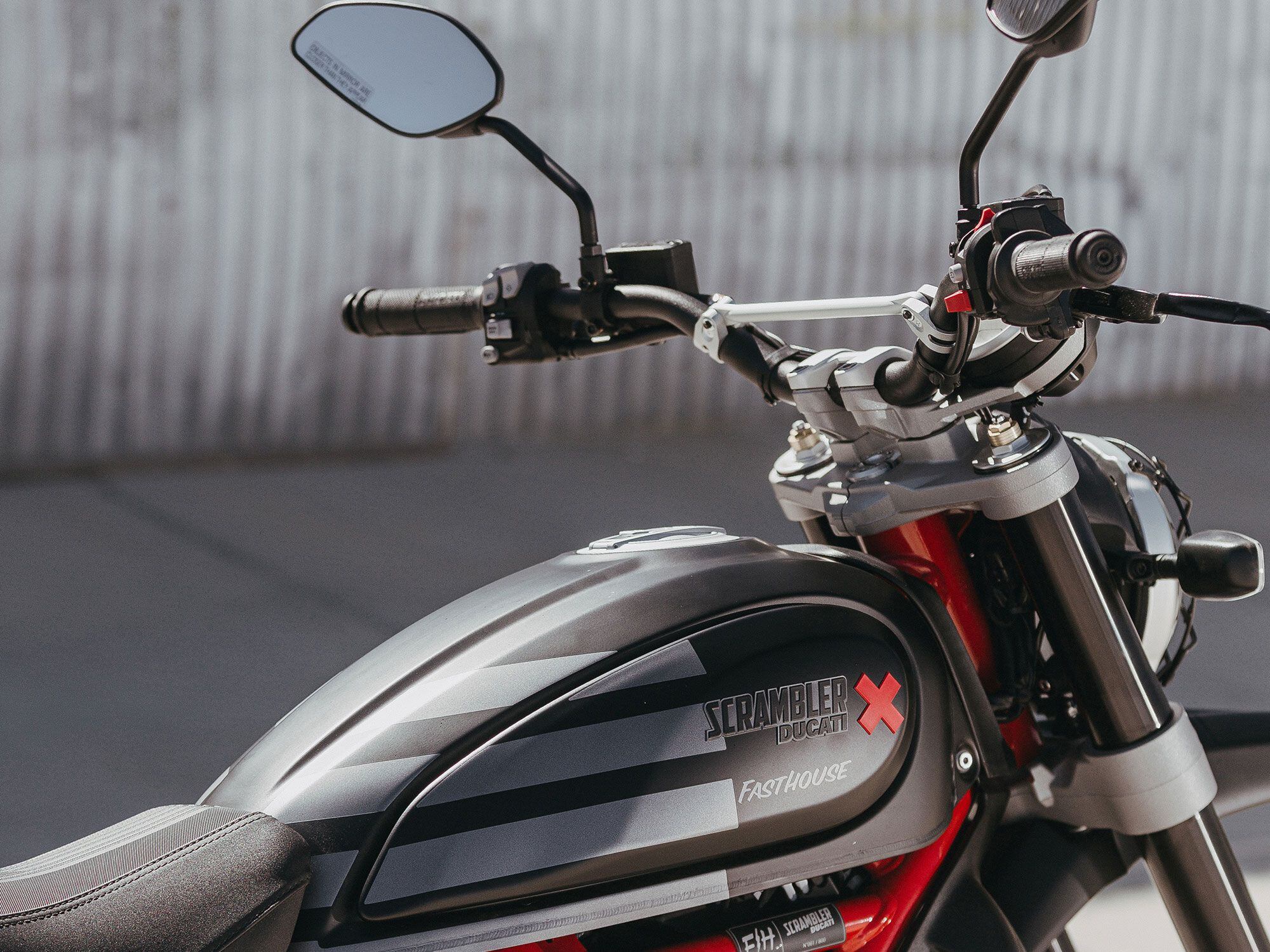
The Desert Sled’s minimalist cockpit and wide, forward bars make it a tantalizing place for those seeking off-road fun. Serious fun for some, as it turns out. (Ducati/)Expect the 2021 Ducati Scrambler Desert Sled Fasthouse to appear at US dealerships in May.
-
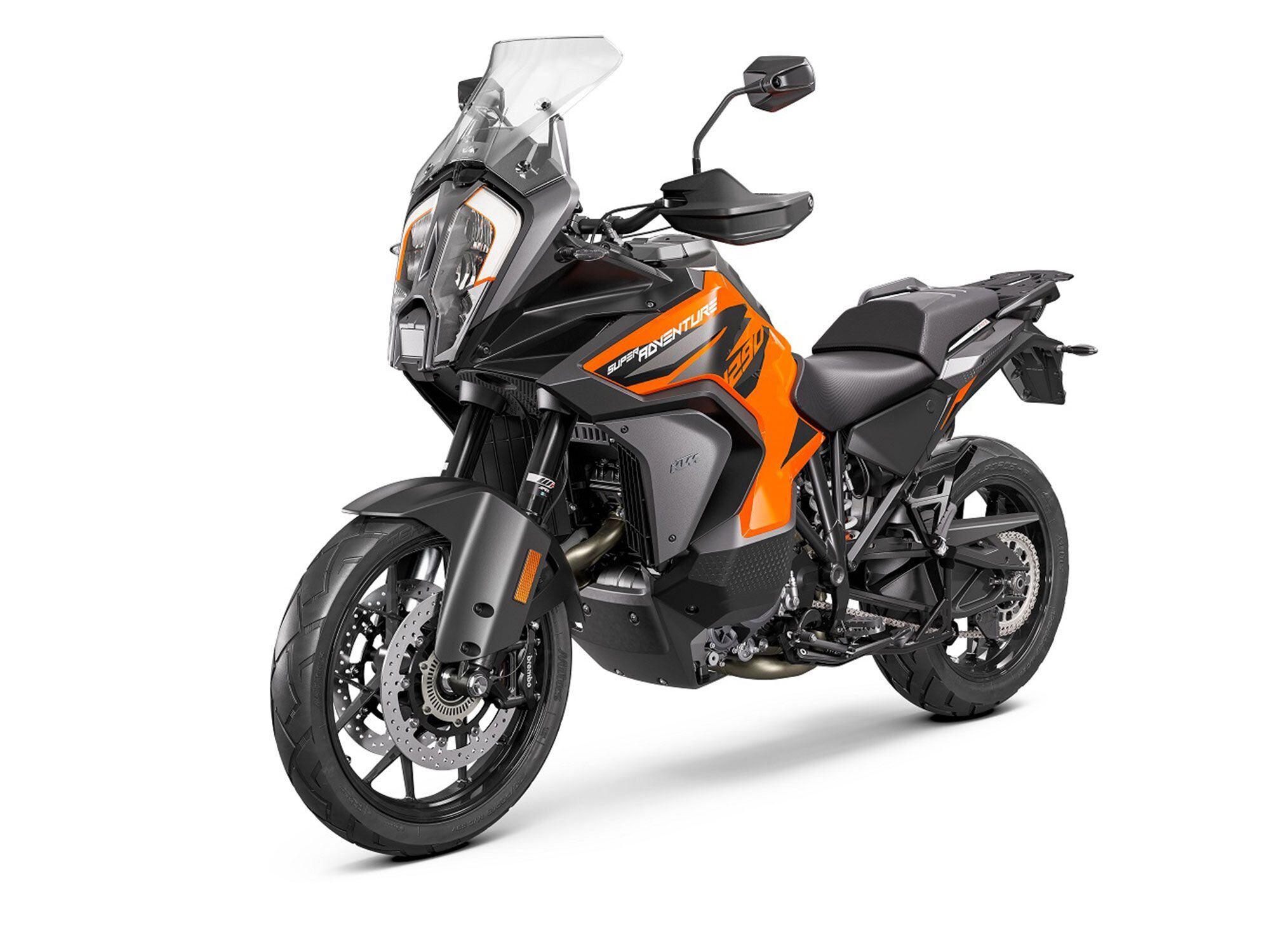
KTM’s third entry in the 1290 Super Adventure range will share the physical dimensions as the previously announced 1290 S model (shown). (KTM/)The decision to cancel last year’s major European motorcycle shows—Cologne’s Intermot and Milan’s EICMA—might have been seen as a blow to the industry by some, but manufacturers are reveling in the ability to launch bikes on their own schedule rather than vying for attention alongside dozens of other new models.
KTM has taken the newfound freedom to an extreme, with a host of separate unveilings for individual models, even when they’re part of a larger single range. The firm did it with the new 890 Adventure, which was revealed apart from the Adventure R and Rally models, and again with the 1290 Super Adventure S and 1290 Super Adventure R, which were each given their own distinct launch dates. Now it’s emerged that there’s another derivative to come in yet another individual unveiling, as the existence of a base-model 1290 Super Adventure has been exposed by European type approval documents.
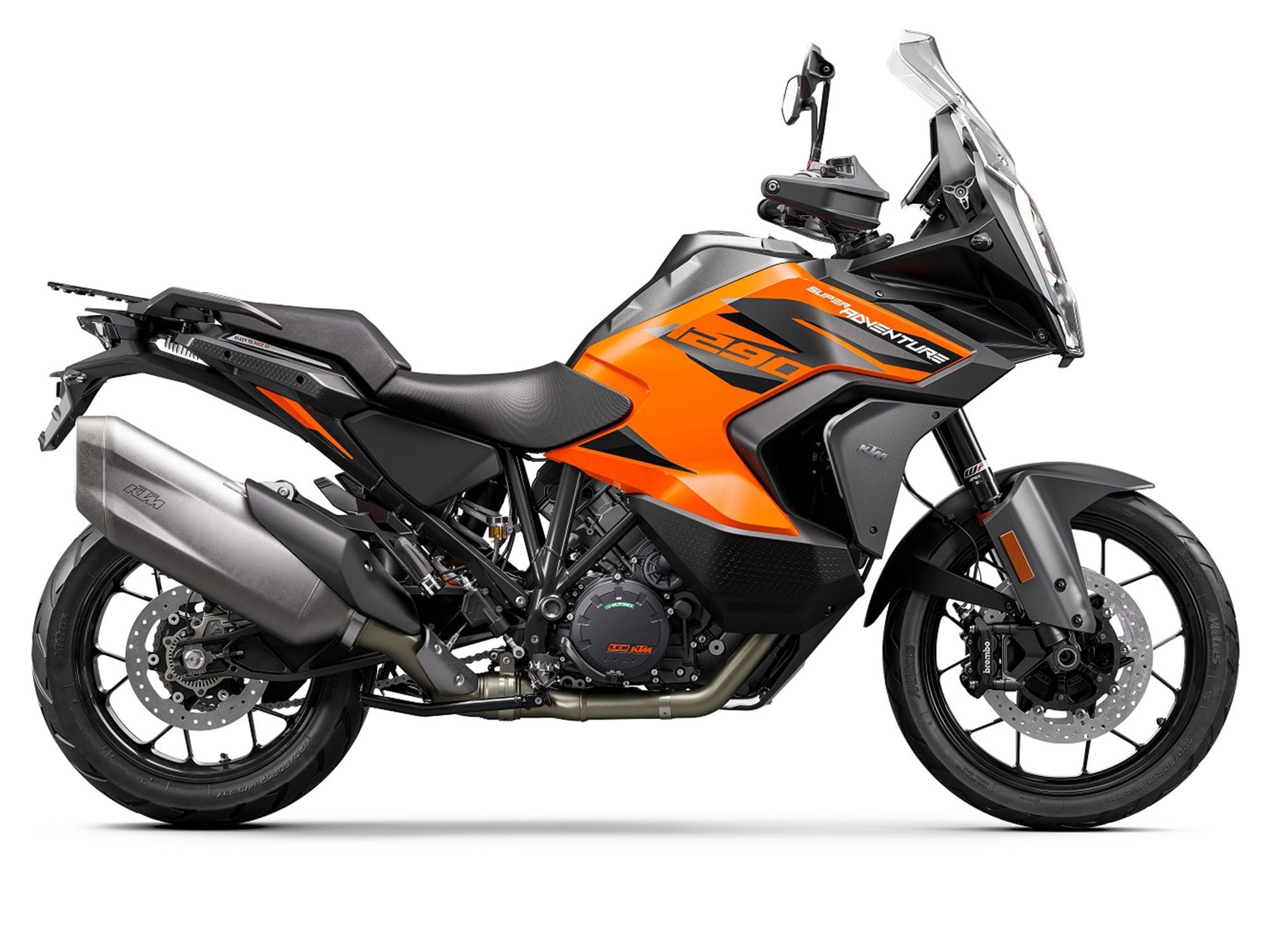
The separate launch date allows KTM to focus on the base model’s merits (lighter weight, lower price) without the distractions of the higher-tech R and S bikes. (The 1290 S is shown.) (KTM/)Launching the base model after the higher-spec machines makes some sense from a marketing perspective. Had the 1290 Super Adventure been revealed at the same time as the S and R, coverage would no doubt have focused on the S’ radar cruise control and semi-active suspension or the R’s high-spec components. By launching it later on, it gives the opportunity to push the basic version on its own benefits, which will no doubt be led by the fact that it has the same performance as the more exotic versions but at a lower price.
According to the type approval documents that we’ve seen, the base version of the 1290 Super Adventure will share its main physical dimensions with the S version, with the same 61.3-inch wheelbase and an identical 88.8-inch length. Those numbers effectively confirm that the Super Adventure will share the S’ cast alloy wheels, sized at 19 inches in the front and 17 inches rear, instead of the R’s wire wheels, which measure 21 inches up front and 18 inches at the back, making the whole bike nearly 2 inches longer, at 90.7 inches.
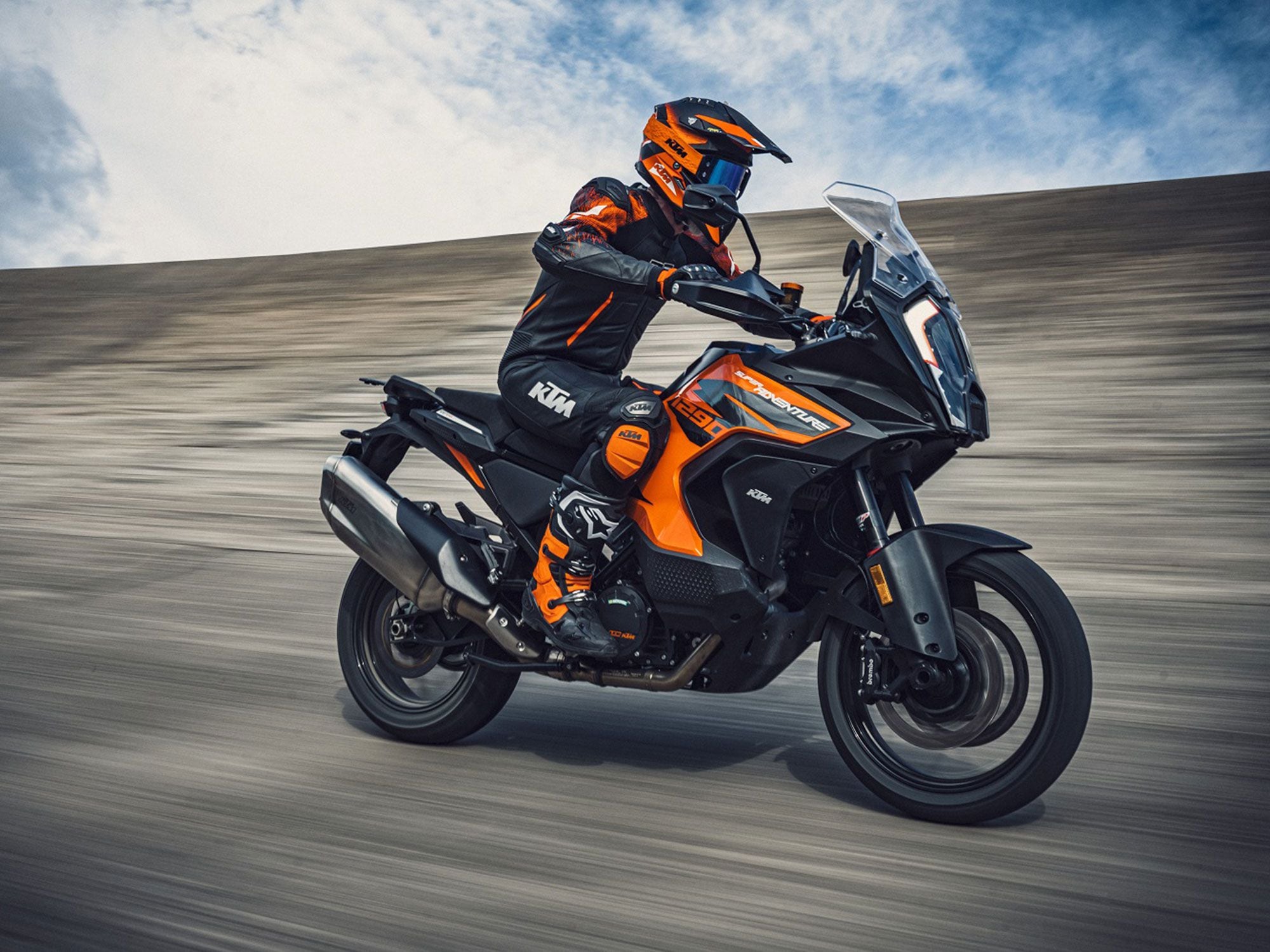
The base 1290 Super Adventure shares the same 1,301cc motor with its higher-spec siblings, but its lighter weight could boost performance. (The 1290 S is shown.) (KTM/)The documents also reveal that the base Super Adventure is 5 kilograms (11 pounds) lighter than either of its siblings. While KTM tends to quote dry weights in its official stats, putting the S version at 220 kilograms (485 pounds) and the R model at 221 kilograms (487 pounds), the type approval documents give curb weights, including oil and a tank of fuel. That means they rate both the S and the R at 245 kilograms (540 pounds), while placing the new base version at 240 kilograms (529 pounds).
The weight might be lower, but the entry-level Super Adventure’s power is identical to the S and R models, with the documents confirming that it uses exactly the same 1,301cc V-twin, making 158 hp, as the higher-spec bikes. That means the cheapest offering in the 2021 Super Adventure lineup might also turn out to be the quickest.
The weight savings is likely to be the result of the base 1290 Super Adventure ditching the S model’s radar-assisted cruise control (it’s already dropped from the R) and its WP-SAT semi-active suspension. The R version already lacks those parts, but uses higher-spec passive suspension and matches the S’ weight thanks to the addition of off-road-oriented components like crashbars around the engine. Visually, we’re expecting the base machine to be nearly identical to the S, though with a gaping hole under the headlight unit where the S’ radar sensor is housed.
This isn’t the only new 2021 KTM model that we’re still waiting to see. Similar documents have also confirmed the existence of a 1290 Super Duke RR that’s set to join the 2021 model range.
-
Hello Chains,
Welcome to The Motorbike Forum. Please feel free to browse around and get to know the others. If you have any questions please don't hesitate to ask.
Why not tell us a bit about yourself too.
-
Hello doudouuu,
Welcome to The Motorbike Forum. Please feel free to browse around and get to know the others. If you have any questions please don't hesitate to ask.
Why not tell us a bit about yourself too.
-
-
-
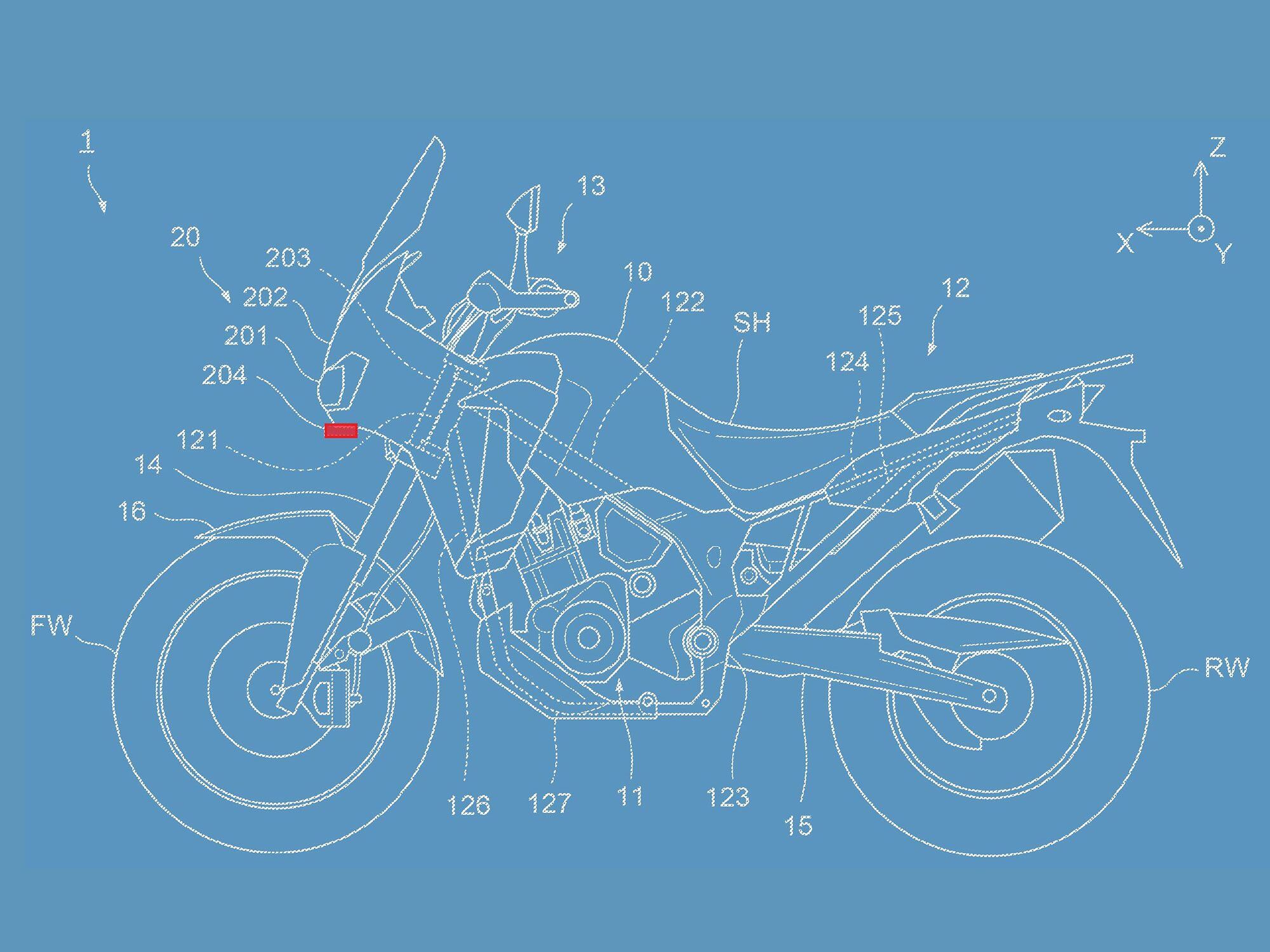
Honda’s looking to develop its own in-house radar system for motorcycles, with the setup likely to appear in the Africa Twin first. (Honda/)While radar-assisted cruise control has been available in cars for years, it’s taken a long time to make its way onto two wheels. Now it’s here though, and manufacturers that don’t have the technology are scrambling to catch up—with Honda working particularly hard on getting its own radar-assisted models into the range.
For 2021, three manufacturers have managed to get radar-assisted bikes into production. Ducati offers a front and rear radar setup on the Multistrada V4 S, albeit as an option rather than standard kit. It’s an option on BMW’s R 1250 RT in 2021 too, though BMW will only sell you a front-facing radar so far. KTM, meanwhile, has introduced a front radar on the new-for-2021 1290 Super Adventure S, becoming the only company to offer the system as standard equipment so far.
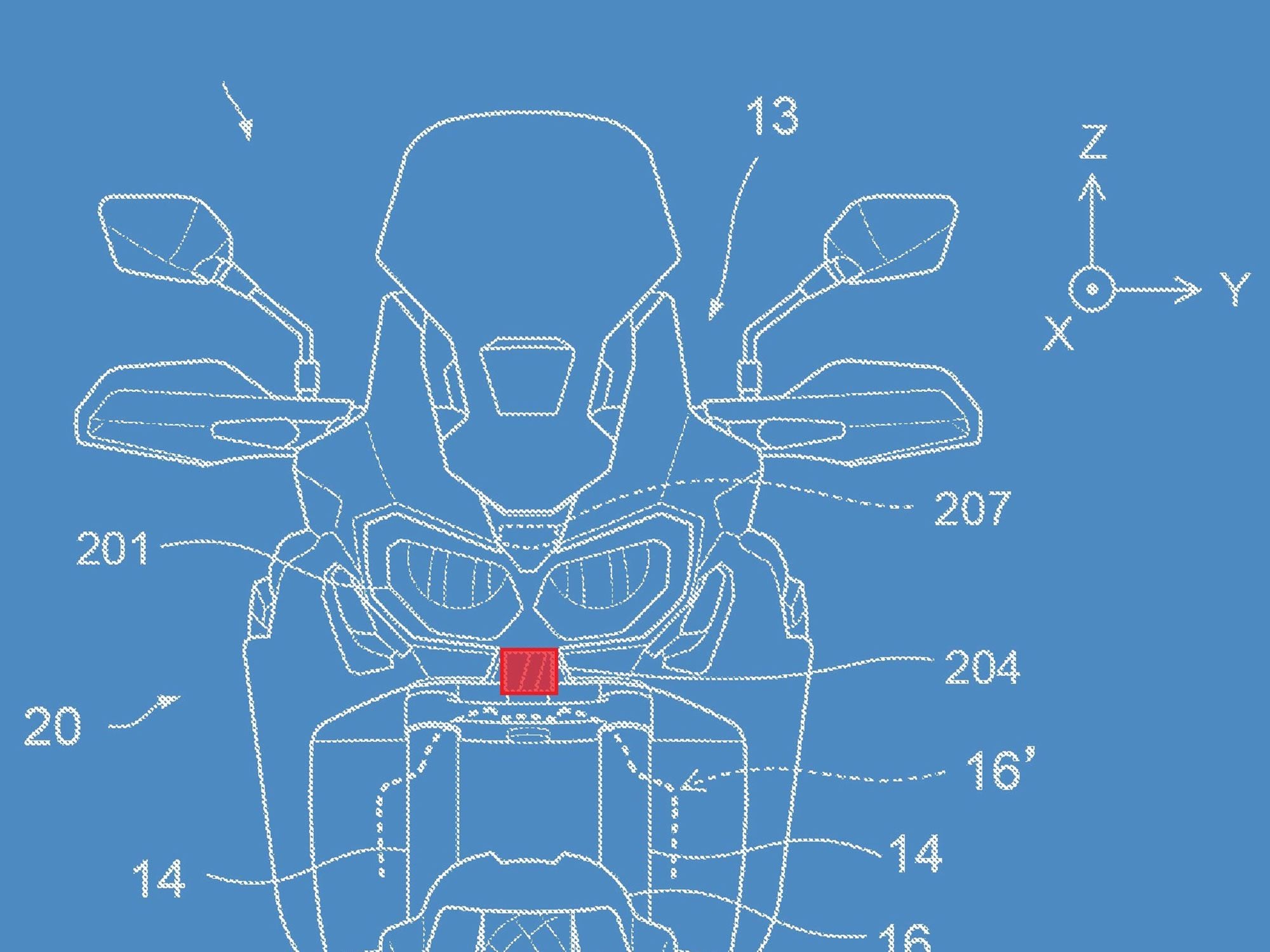
Patents show a radar layout using three separate sensors, one in front and two in the back. (Honda/)All those existing models use the same basic components, developed by Bosch. The radar sensors themselves are basically the same as those used in cars, but it’s taken years of work to create the computer systems that interpret their signals and react correctly on bikes. Motorcycles bring the added complication of leaning in corners and the fact that you can’t safely introduce automatic emergency braking systems to them, since unexpected braking is likely to cause more accidents than it prevents. As with their four-wheeled equivalents, the bike radars allow a motorcycle’s cruise control system to maintain a constant distance from vehicles ahead even as speeds change, while the rear-facing radar on Ducati’s Multistrada provides a blind spot warning system. Kawasaki is also signed up to adopt the Bosch radar system, and was recently seen testing just that on an updated version of the Ninja H2 SX SE+.
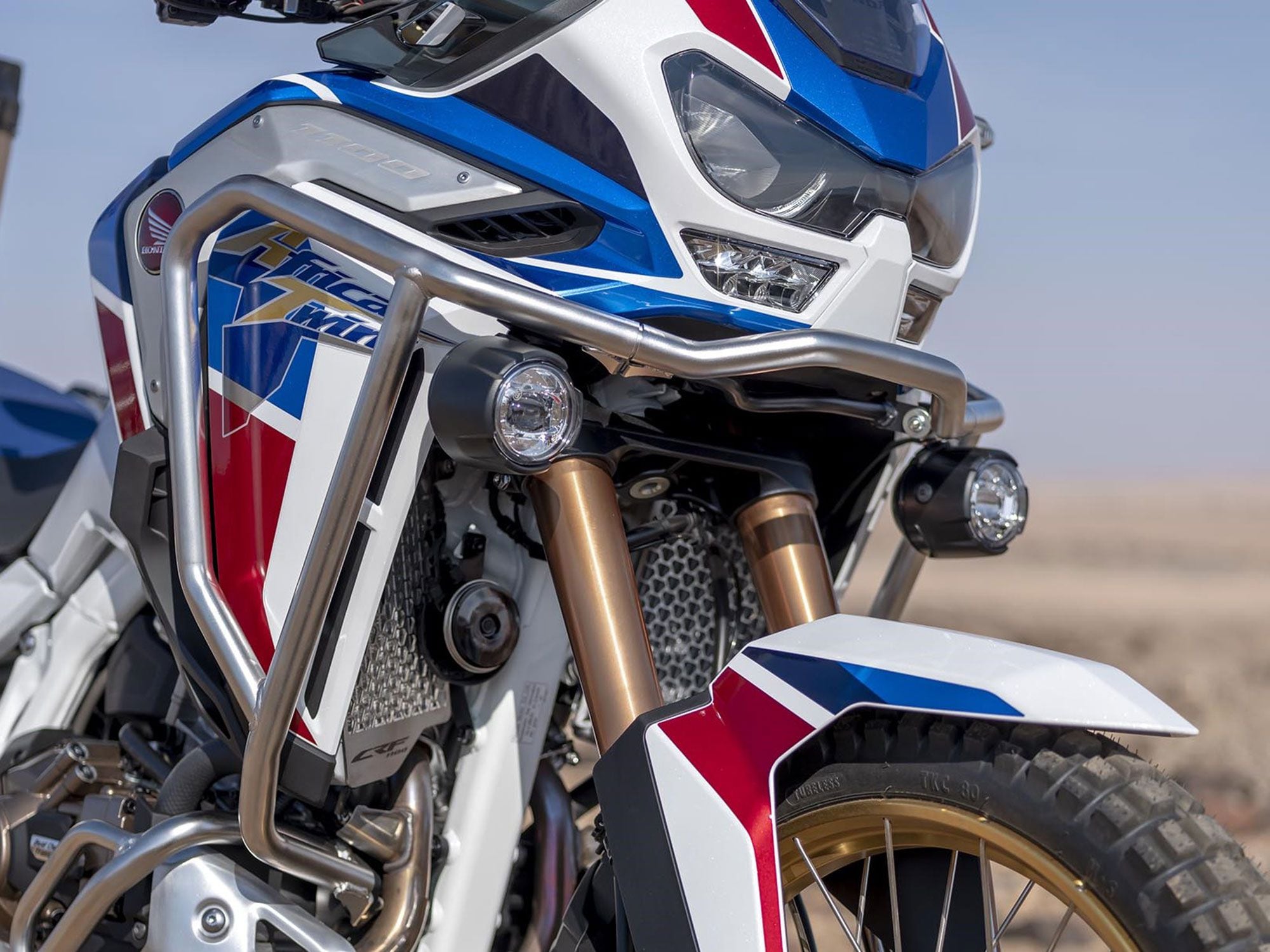
The Africa Twin already has the perfect spot for tucking in a sensor unobtrusively, just under the headlights. (Honda/)Honda’s development work on radar so far suggests the firm is keen on creating its own systems rather than simply buying the existing Bosch setup, and a brace of new patents show how the company is looking to implement them on the Africa Twin. Instead of using just one front radar, or even a front and a rear unit, the firm’s designs show a bike with three separate radar sensors—one at the front and two at the back.
The front radar looks much like the systems already used by BMW, Ducati, and KTM, and in fact the radar sensor’s positioning, just below and between the Africa Twin’s headlights, brings new sense to some of Honda’s styling decisions on the current version of the bike. There’s already a separate front body panel area with a prominent blank, flat section set into it that’s just about the perfect size to hide a radar. With the latest patent documents showing that the radar system was under development before the Africa Twin’s 2020 redesign, it’s virtually certain that the styling has been created with the introduction of radar in mind.
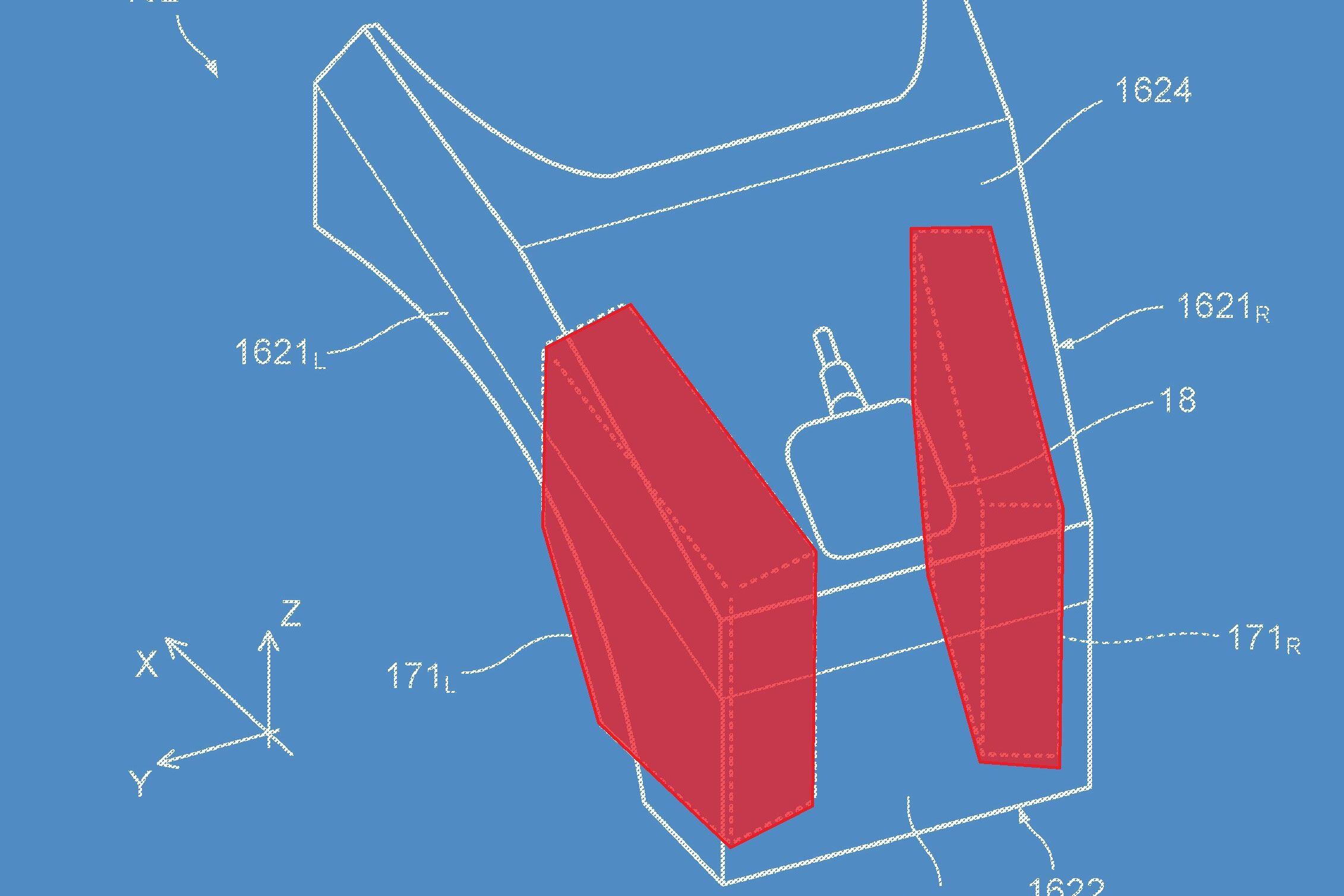
Out back, there are two separate radar units on either side of the license plate, each angled slightly sideways. (Honda/)At the back is where Honda’s setup, as seen in the latest patents, departs from the norm. Instead of a single radar sensor facing directly rearward, as on Ducati’s Multistrada V4 S, there are two separate radar units mounted inside the license plate hanger, just where the license plate lamp is mounted. Instead of facing back, these sensors are angled to point largely sideways, with a slight rearward slant. Since each radar creates a wide detection cone, the result is a radar-swept area that covers not only the area behind the bike but each side as well, thus providing information to a blind spot warning system that can tell if a vehicle is alongside as well as if there’s one behind. Honda also suggests the system could be used as part of a lane-assist setup.
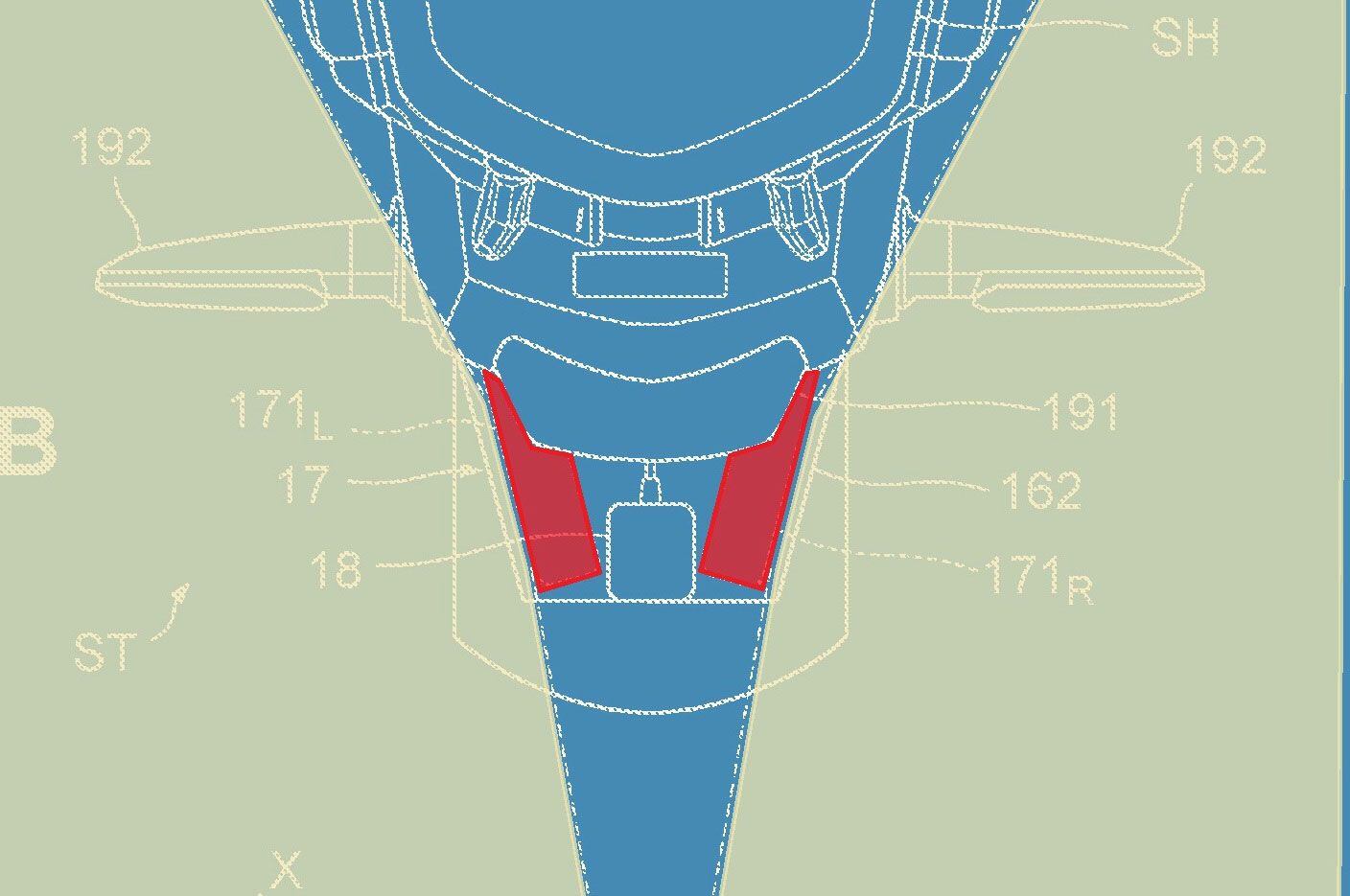
The positioning allows the radar to cover both the rear as well as part of the sides of the bike. (Honda/)Another element of Honda’s radar patents we haven’t seen elsewhere is the use of transponders to broadcast information from the sensors to other vehicles or to roadside receivers. Honda, along with many of the world’s bike firms, has long been working on creating a standardized vehicle-to-vehicle (V2V) and vehicle-to-infrastructure (V2X) system, allowing safety systems like radars or cameras on one car or bike to pass on the information they gather to other nearby vehicles. The idea is to create a daisy-chain of knowledge about each vehicle’s speed, acceleration, direction of travel, and its surroundings, which gets passed to other vehicles in the vicinity to allow them to build a picture of what’s going on, even if it’s out of the direct line of sight, so they can respond to potential dangers or warn their riders much earlier than is possible with today’s systems.
-
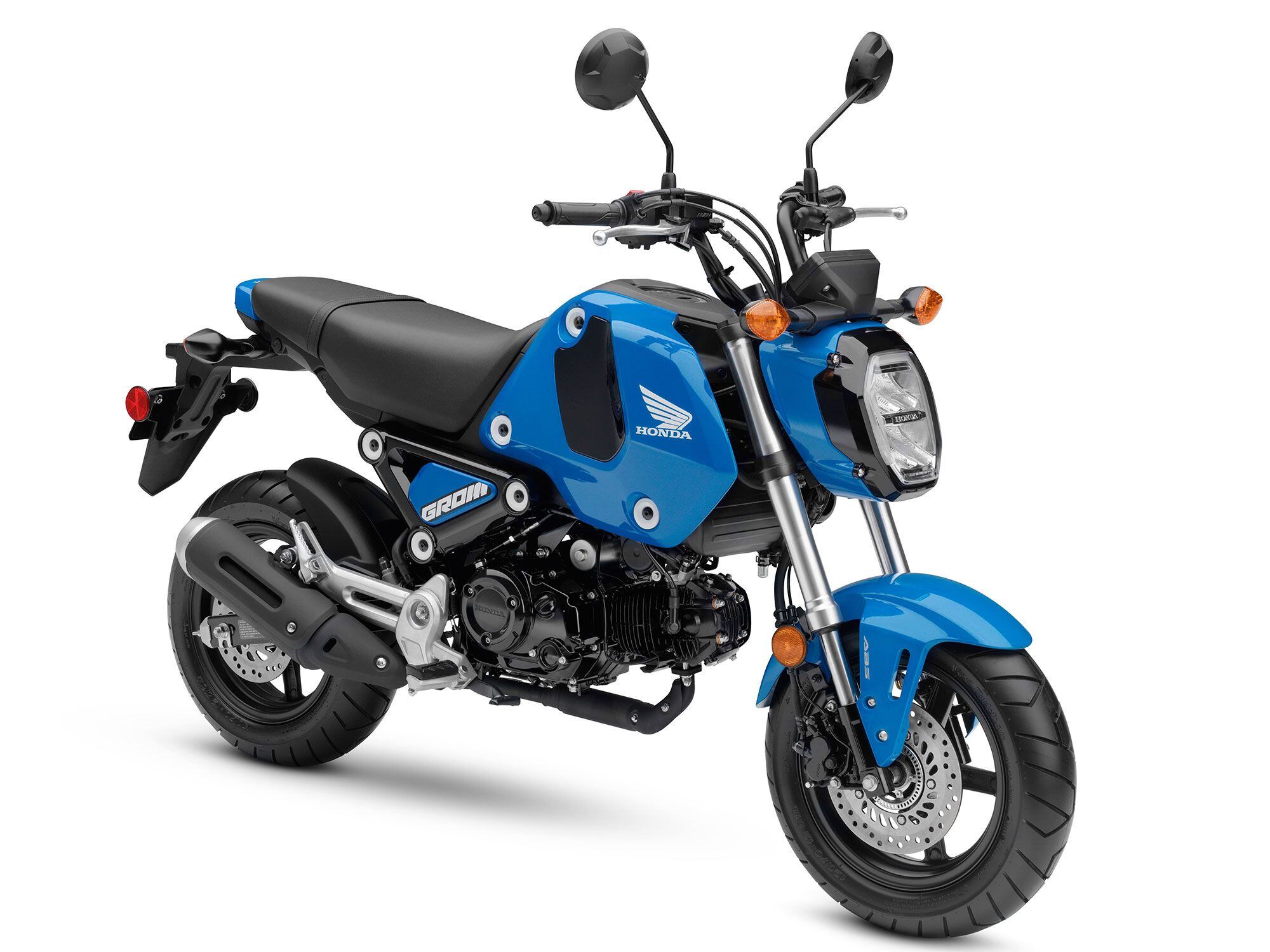
Honda officially confirmed the redesigned Grom will be in the US as a 2022 model. It’ll be available in May with ABS as an option (shown). (American Honda Motor Co./)Late last year Honda gave us word that a new, redesigned Grom would be hitting other parts of the world as a 2021 model, but besides a mention that it would also be eventually available in the US, no other details of the North America-bound mini moto were given. Changes revealed on the global model gave us some hints though, like the addition of a fifth gear, a new headlight, Euro 5 certification for the engine, and a full styling revamp, but we Yanks were left to ponder what the price tag or availability would be. Now that’s been settled, as last week American Honda officially announced that a new version of the Grom, one of its current best sellers worldwide, would be coming to our shores in May as a 2022 model.
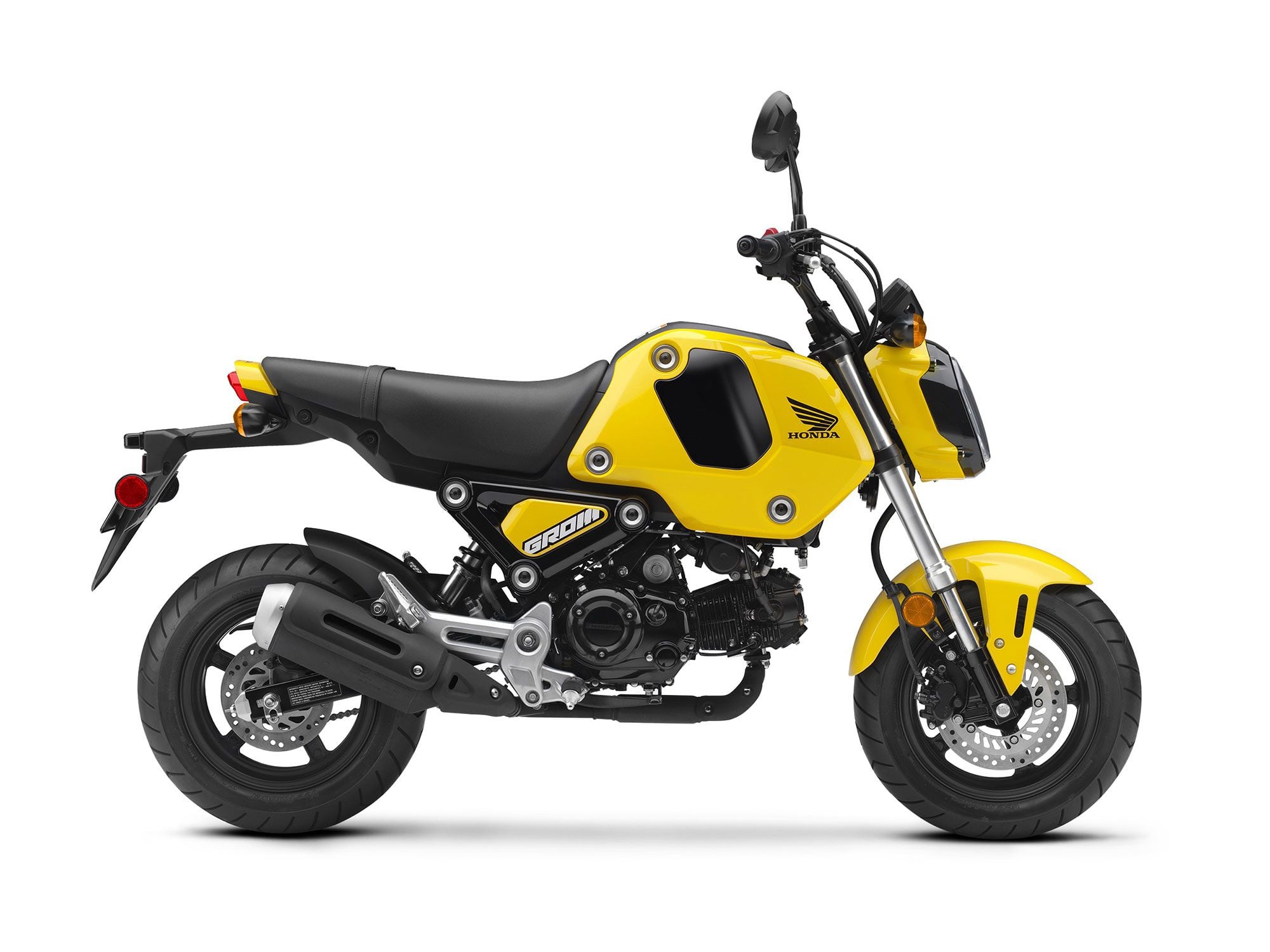
As noted in last year’s Euro release, the US-bound Grom will also have new bodywork and a Euro 5-spec engine with a five-speed gearbox. Here’s the base trim in Queen Bee Yellow. (American Honda Motor Co./)As we’d hoped, the made-over Grom for the US market will get those major revisions, including a reworked 125cc engine and a five-speed transmission. The two-valve single-cylinder mill has a higher compression ratio (now 10.0:1) and meets Euro 5 emissions standards, and the addition of the fifth gear gave Honda the opportunity to add a larger 38-tooth final-drive sprocket for a bit more snap.
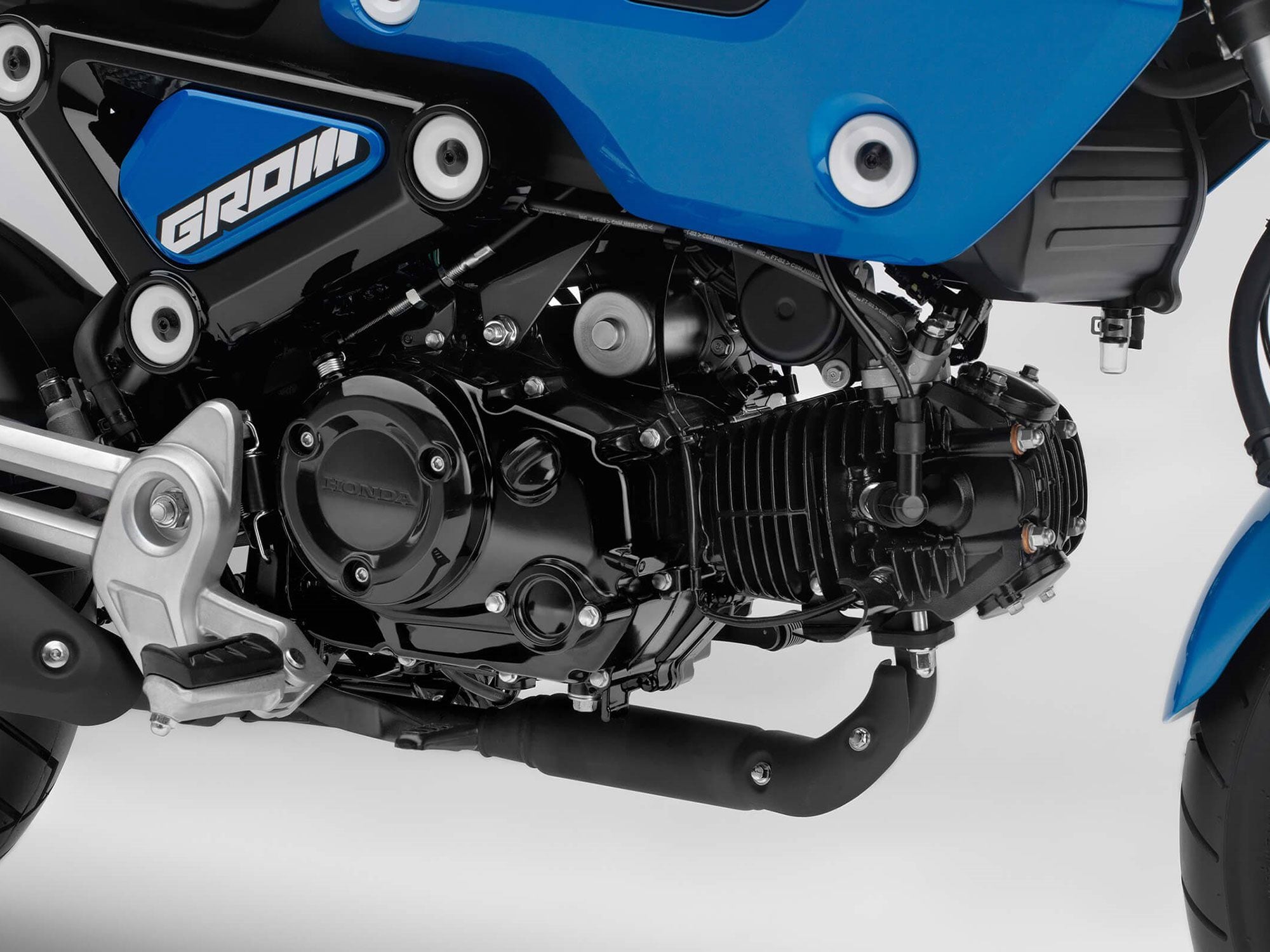
The 125cc two-valve engine has a narrower bore and longer stroke than its predecessor (50mm x 63.1mm compared to 52.4mm x 57.9mm) as well as a higher compression ratio of 10.0:1 (9.3:1 previously). (American Honda Motor Co./)Another big part of the makeover for the 2022 model year is the new bodywork with pared-down styling. Because the Grom has always been about easy customization, owners can get at the four main body panels via six big fasteners, allowing them to pop the panels off the steel backbone frame and mix and match colors for a simple way to swap looks. Also on the styling front is a new look for the engine, exhaust, wheels, and swingarm, which all get blacked out for a more up-to-date vibe; the wheels keep their signature 12-inch size, but feature a new design with a five-spoke pattern.
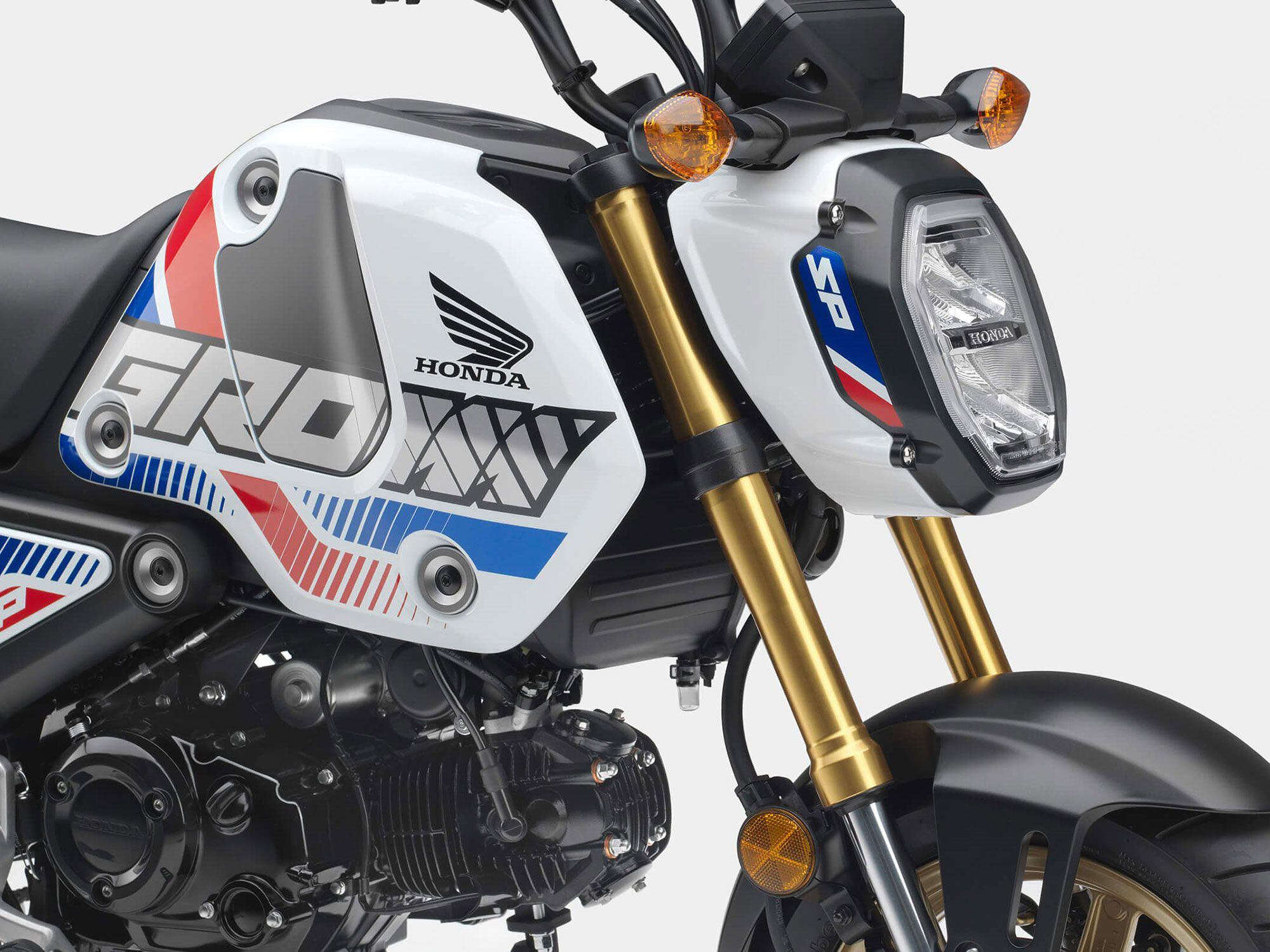
The main body panels are easily removable via those quick-access recessed fasteners; shown is the SP graphic. (American Honda Motor Co./)You might notice a subtle change with the seat too; it’s flat rather than stepped and gets thicker padding. With that comes a new subframe, though the frame and suspension remain unchanged, and Honda is quick to point out that the saddle is still an easily cleared 30 inches off the tarmac. You’ll also see a more robust LCD display with provisions for a gear change indicator added to the speedo, tach, fuel gauge, clock, and twin tripmeters. Dig even deeper and you’ll find out that the mini moto’s 2022 iteration (the Grom’s third) now has a replaceable oil filter, ditching the previous oil spinner and screen for easier maintenance. There’s a redesigned exhaust pipe and muffler now designed as two separate parts, which should give customizers way fewer fits.
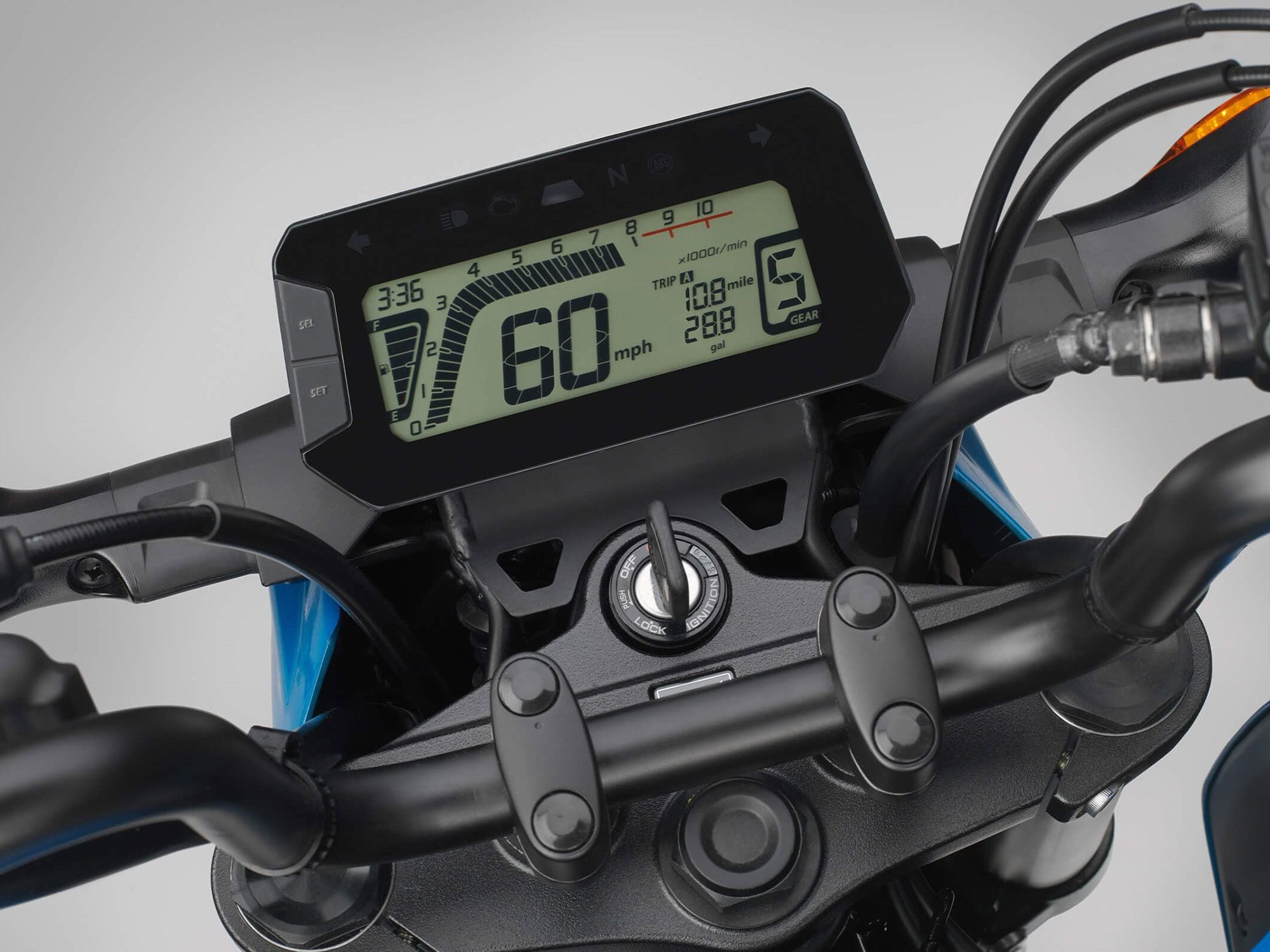
Upgraded LCD dash now includes a gear position indicator to go along with the tach and speedo. (American Honda Motor Co./)For 2022, the Grom boosts fuel capacity a smidge to 1.6 gallons, and the upgraded LCD digital dash now has a gear-position indicator taking its place alongside the speedometer, tachometer, twin tripmeters, fuel gauge, and clock.
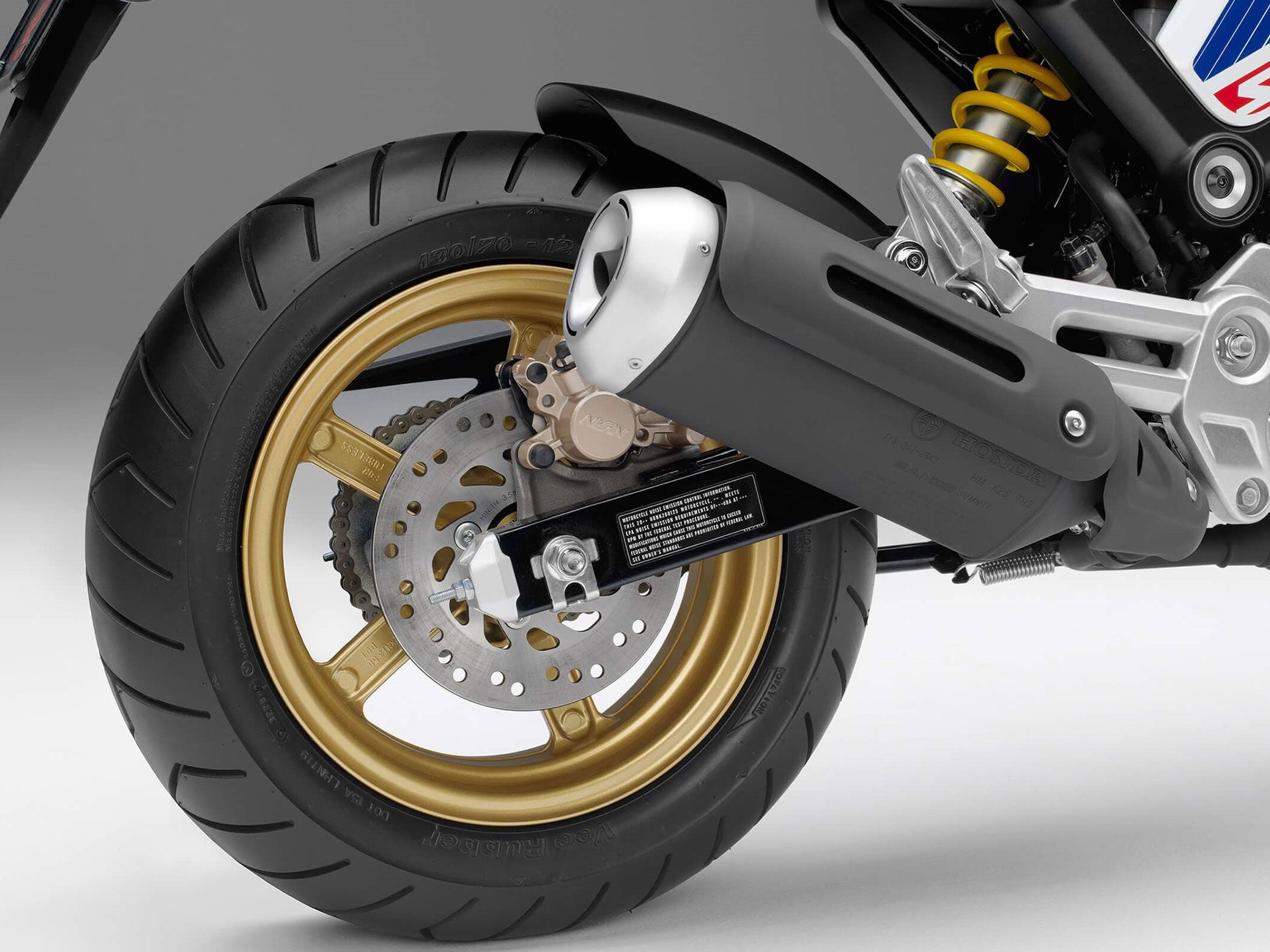
2022 sees a new two-part design for the muffler and exhaust, with wheels getting a new five-spoke pattern. (American Honda Motor Co./)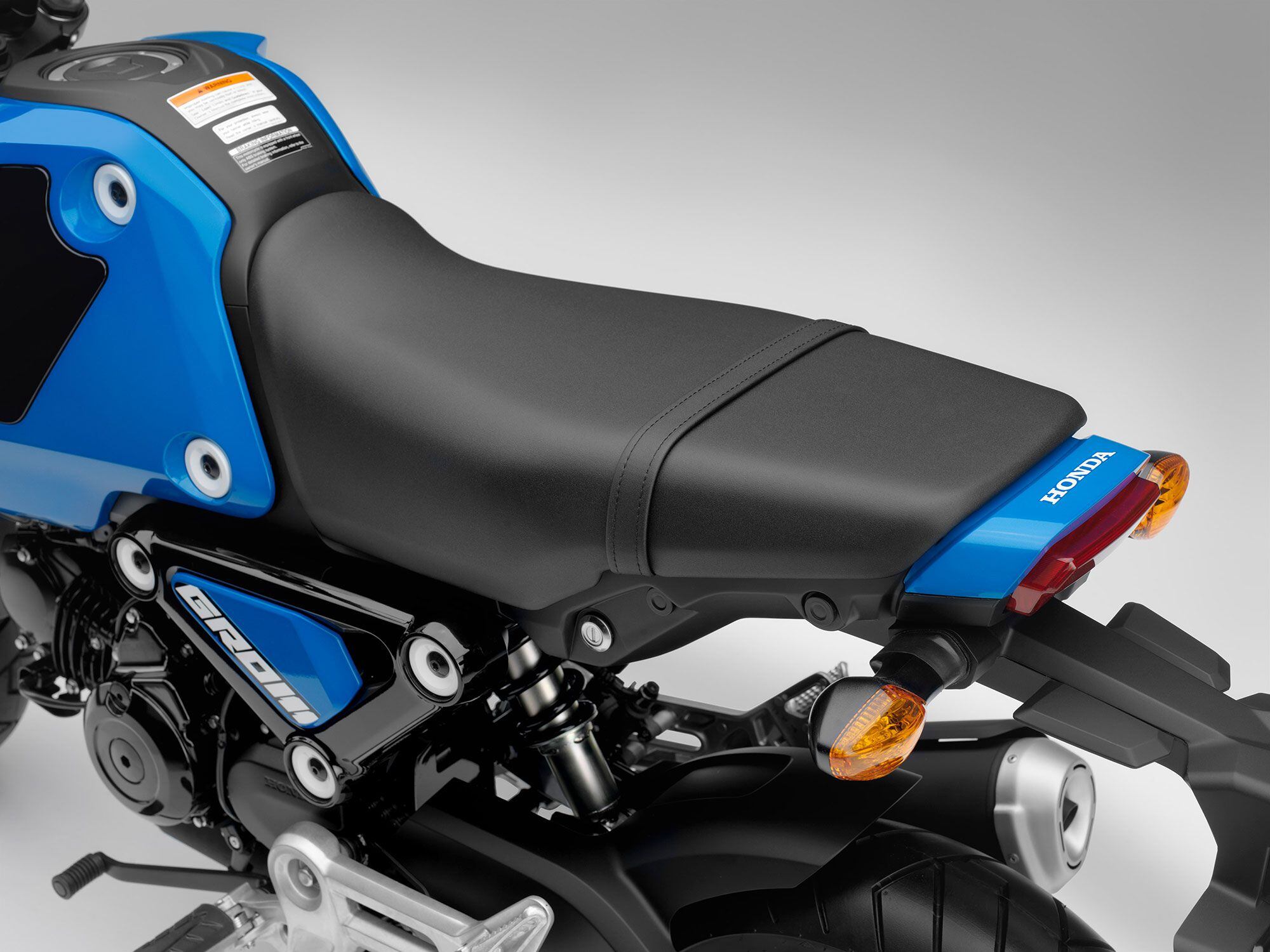
New seat is flatter and plusher, and the fuel tank offers increased capacity for 2022. (American Honda Motor Co./)As a bonus—or at least, instead of an unwelcome surprise—Honda is keeping the price tag in line with last year’s model, at a suggested $3,399 for the base trim. But there are tastier options too, like the new special SP version which sports a gold finish on the fork, wheels, and brake calipers, and tucks in a yellow shock spring out back for an extra pop; that one’ll run you $3,499. Then there’s the higher-spec Grom ABS, which will run $3,599.
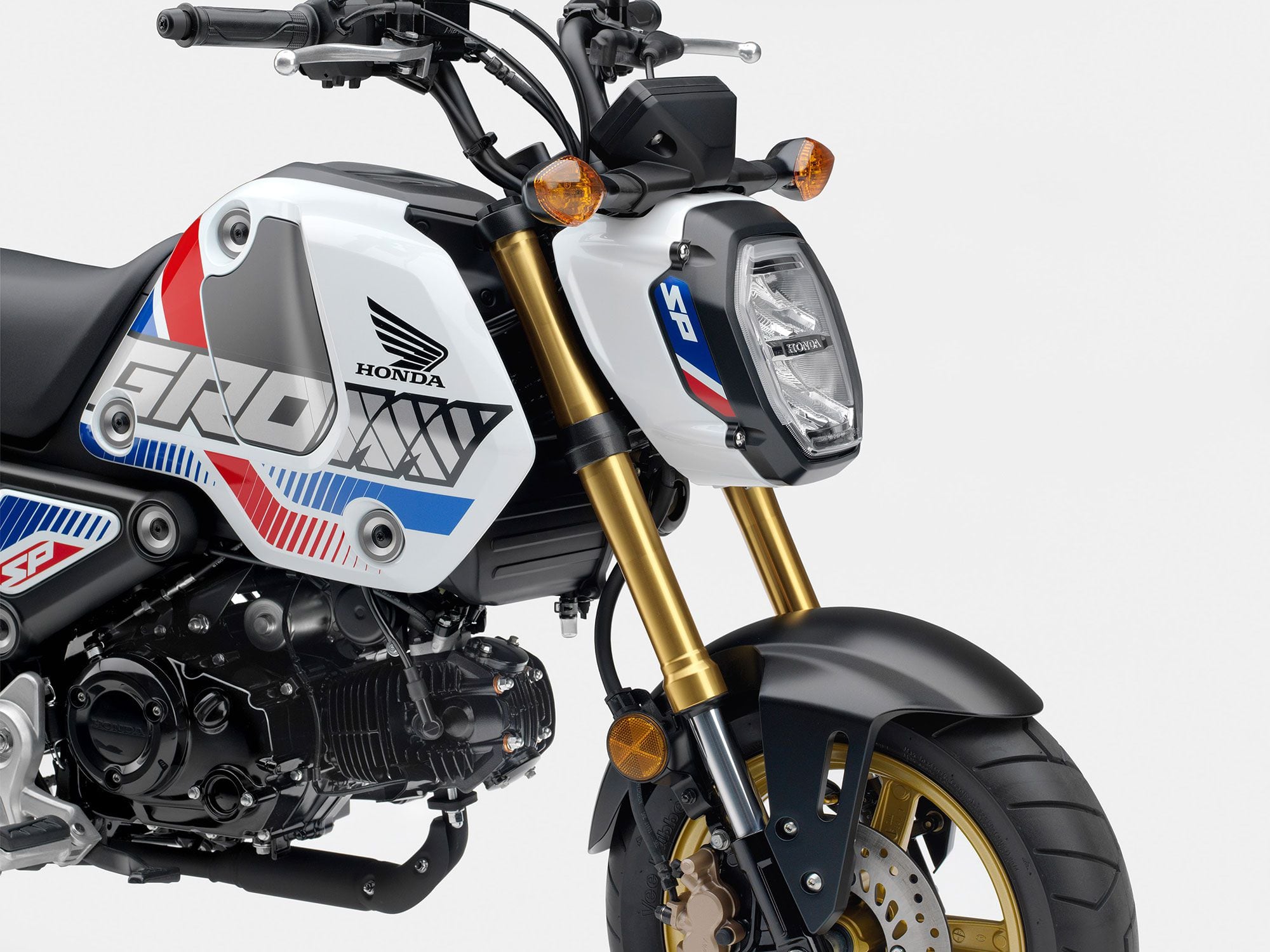
The SP option serves up stylish graphics and gold finishes on key components. (American Honda Motor Co./)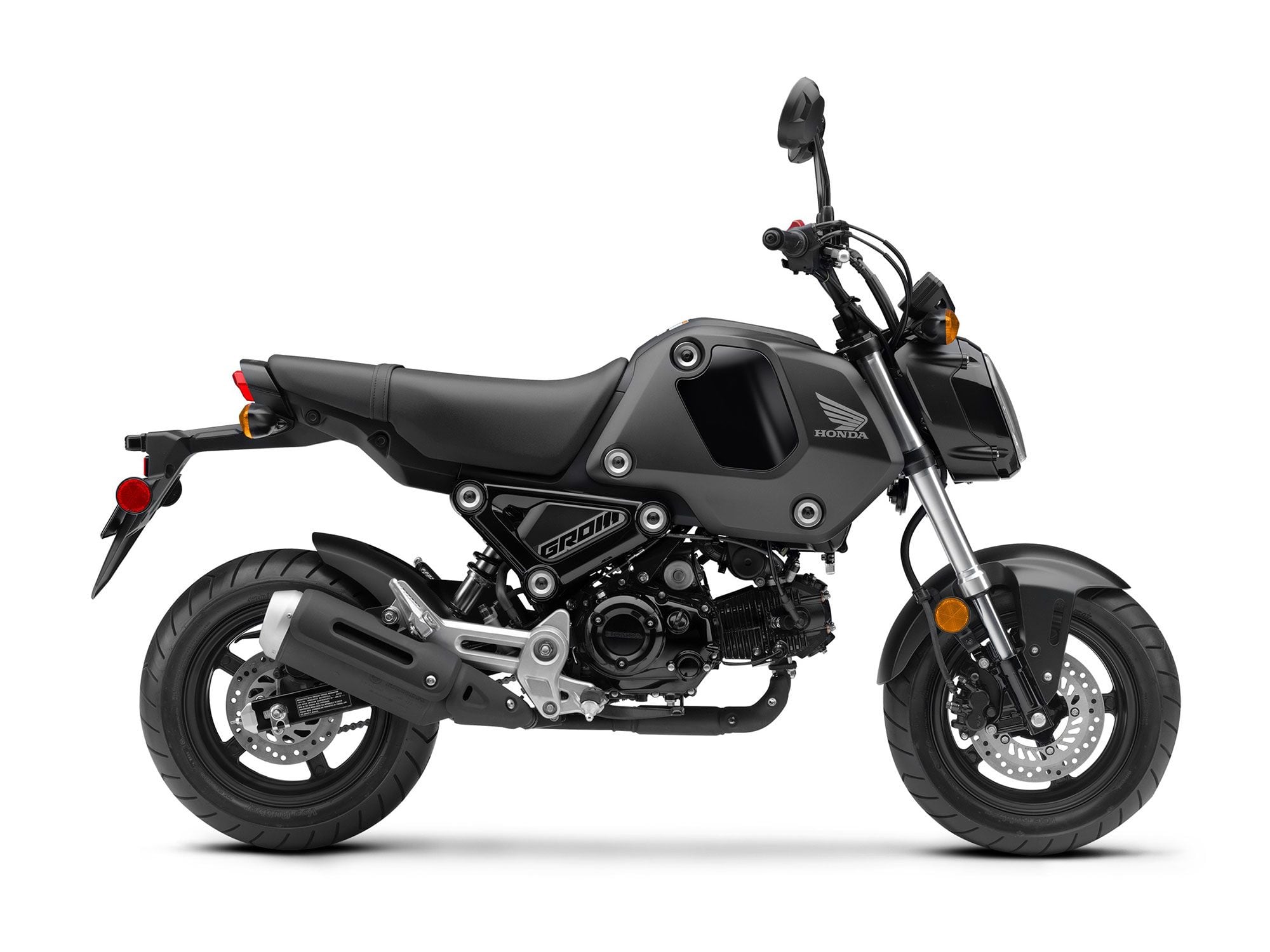
The base model in Matte Black Metallic. (American Honda Motor Co./)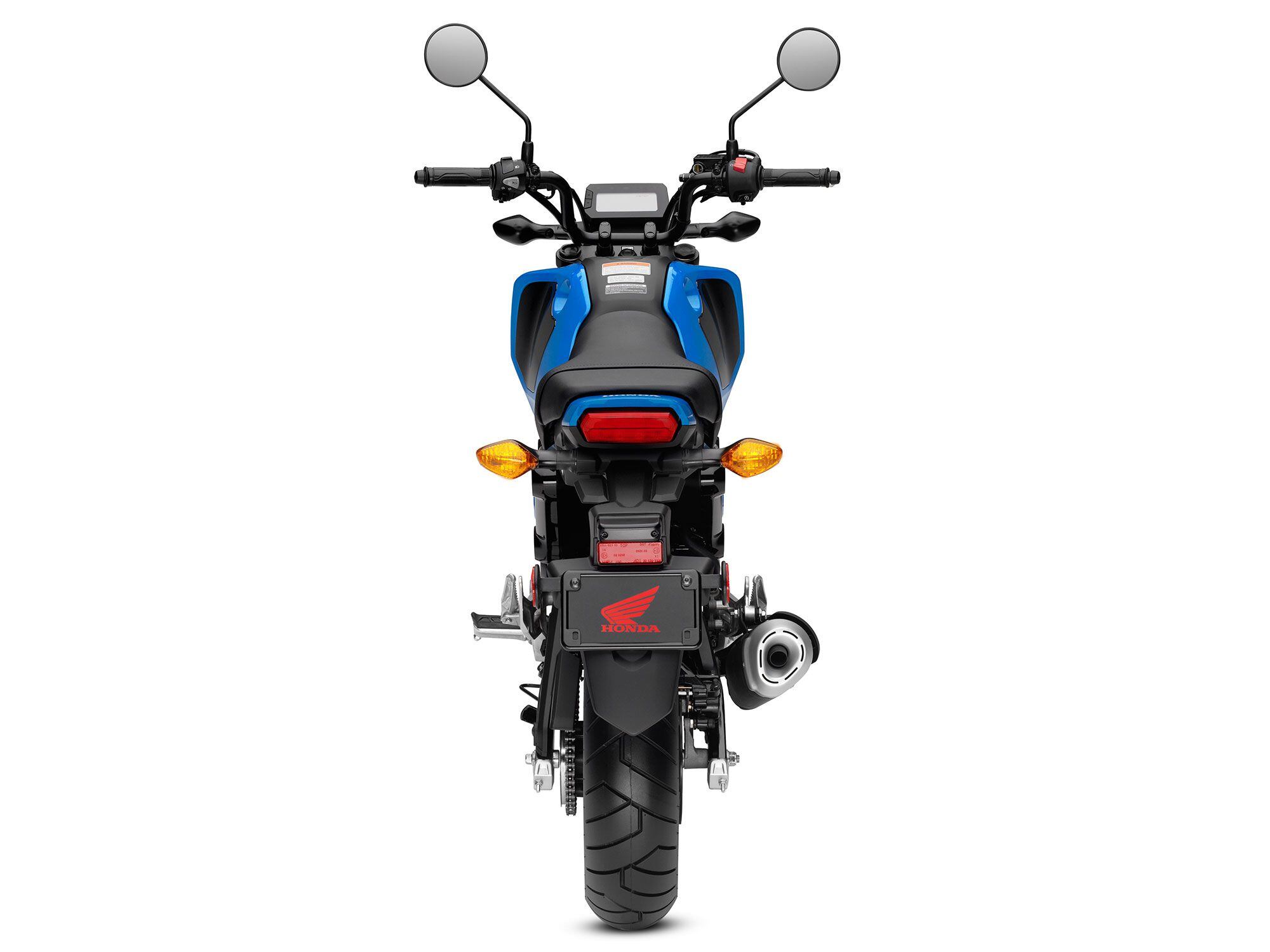
The Grom ABS now uses an IMU (inertial measurement unit) for better front-to-rear distribution of braking power. (American Honda Motor Co./)To sum up, the 2022 Grom can be had in Queen Bee Yellow or Matte Black Metallic for the base trim; the Grom SP with its stylish graphics and gold finishes for $100 more; or the Grom ABS, available only in Candy Blue, for $100 on top of that. The bikes will be available in the US sometime in May of 2021.
-
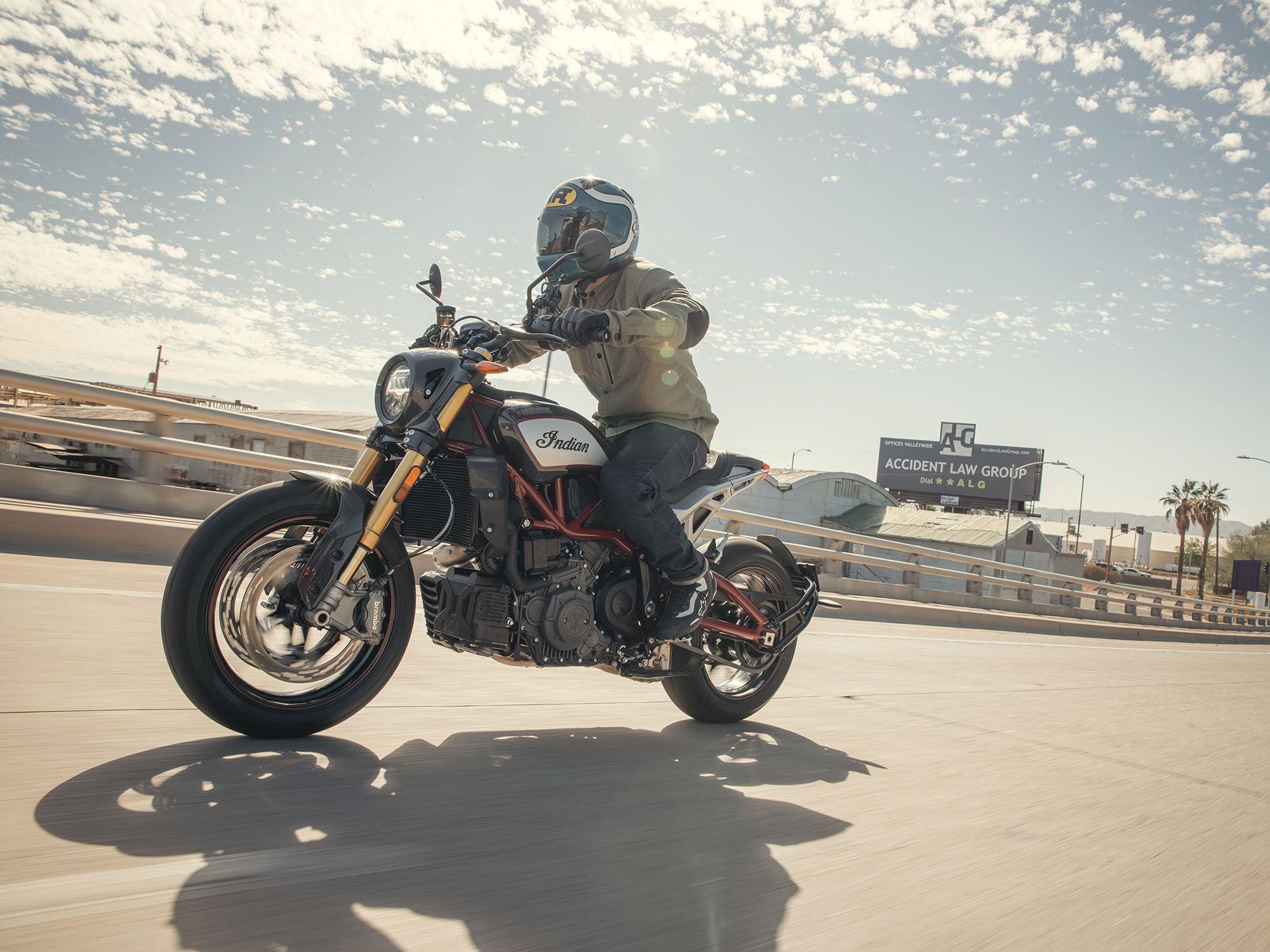
The 2022 Indian FTR 1200 transforms into a sport standard with several key revisions. (Jordan Pay/)Cycle World’s appreciation for the Indian FTR 1200′s rough-’n’-tumble feel is strong and deeply rooted. In fact, in a soul-searching five-bike comparison, we praised the American street tracker as possessing “the strongest spirit and personality of any bike in this comparison.” CW Editorial Director Mark Hoyer said it best: “The FTR’s strength is its successful evocation of Indian’s dominant, scratch-built FTR 750 flat-track racebike, and how well the company translated that into a ripping liter-plus street tracker. Its very limitations from a pure technical perspective and truth-to-trackerness are what make it so great.” Yeah, exactly.
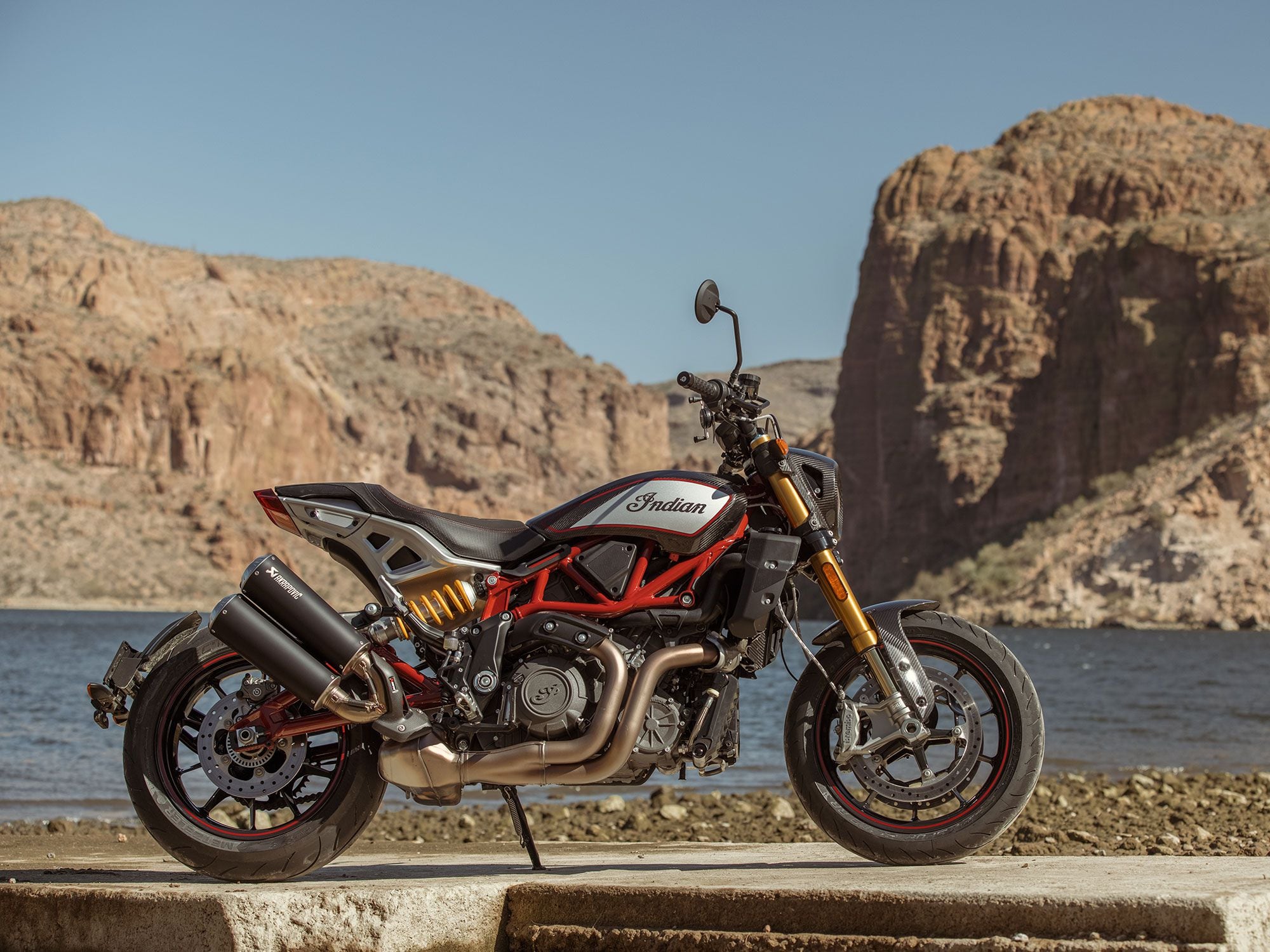
The R Carbon model is the halo of the FTR 1200 lineup, retailing for $16,999. In the sunlight, droolworthy carbon fiber paneling and Öhlins suspension catch the eye. (Jordan Pay/)But in an effort to civilize this street tracker and make it more approachable, Indian has traded in some of the FTR’s personality. After a day sampling the 2022 Indian FTR 1200 on the old-Western mountain roads around Phoenix, I can report that the FTR has been reined in for a more comfortable and practical ride, but it’s hard not to miss the looseness of its racing heritage. Previously the entire FTR lineup, except for the scrambler-styled Rally model, rolled on 19-inch front and 18-inch rear wheels with chunky dirt-track-inspired Dunlop DT3-R rubber. Indian has swapped the large hoops for traditional 17-inch cast-aluminum wheels and Metzeler Sportec street tires, a change that adds flexibility in aftermarket tire choices.
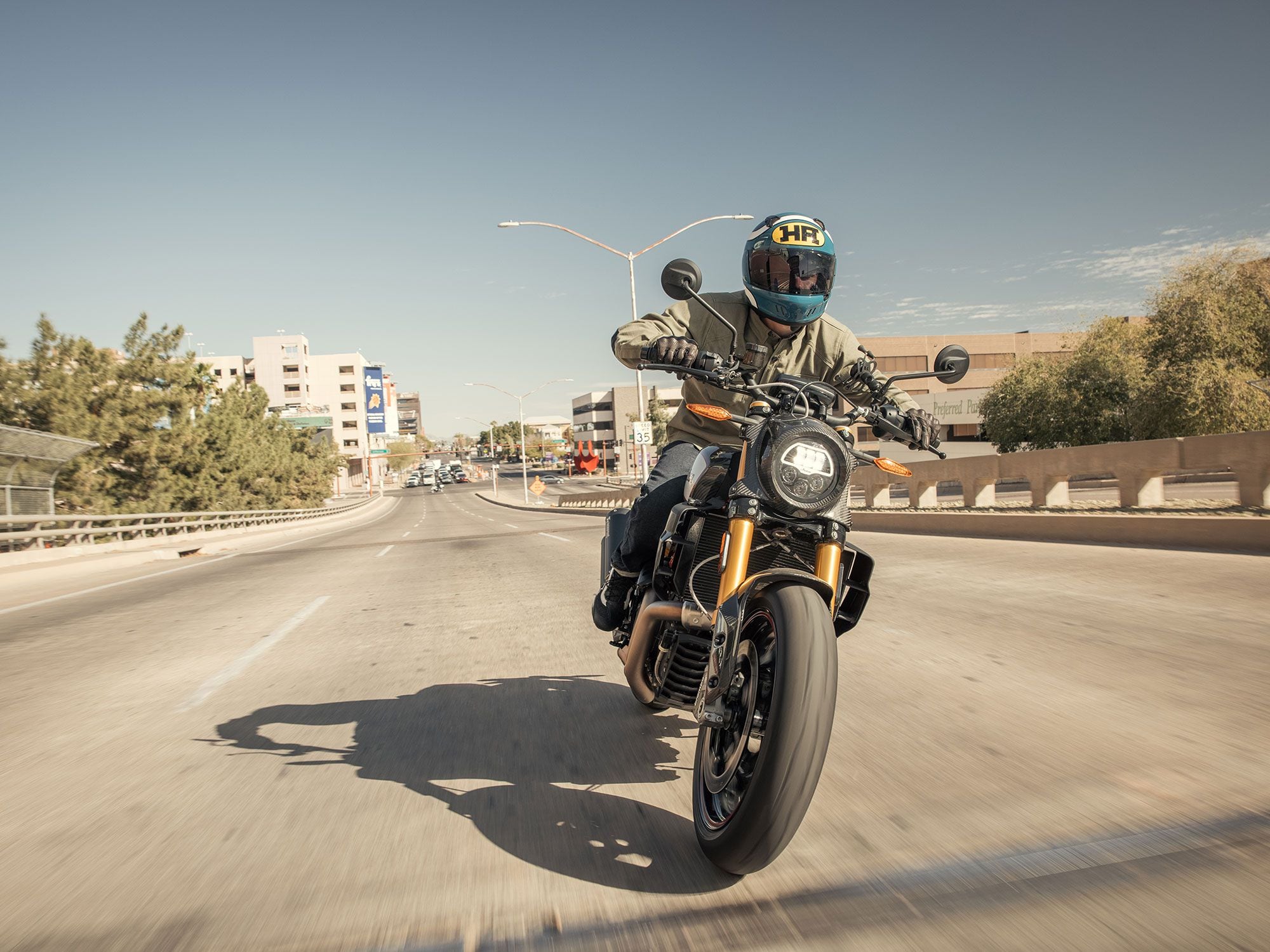
Indian emphasized practicality with the new FTR, notably revising throttle response and incorporating heat-reducing cylinder deactivation and air channeling. (Jordan Pay/)Sharper and sportier chassis geometry also adds to the FTR’s new all-asphalt prowess. The bike loses a full degree of rake, which now sits at 25.3 degrees. Trail has also been reduced to 3.9 inches from 5.1 inches. Suspension travel of the fully adjustable Sachs components, or the Öhlins units fitted to our up-spec FTR R Carbon test unit, has been reduced to 4.7 inches; also lowering the claimed seat height to 32.2 inches. For reference, that’s 1.3 inches lower than the CW measured 33.5-inch seat height of the outgoing FTR. The design is meaner and more precise.
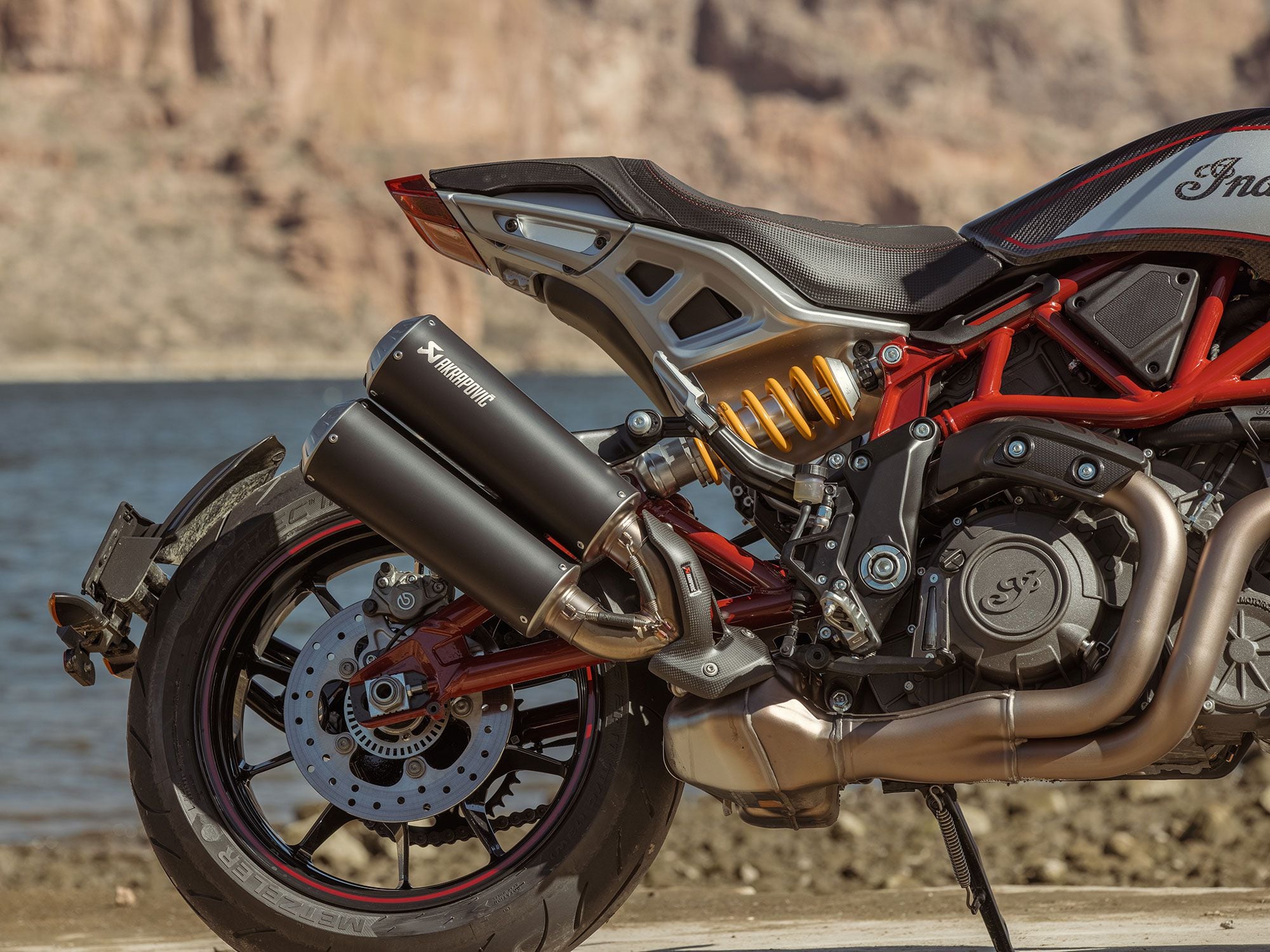
A highlight of the FTR S and R Carbon? It’s hard to deny the appeal of the Akrapovič exhaust. (Jordan Pay/)The feeling is similar on tarmac. This Indian benefits from quicker handling and lighter turn-in effort than its predecessor while also providing a more sure-footed feel at maximum lean. Its long 60-inch wheelbase adds confidence-building stability on high-speed sections of road. The ProTaper handlebar has been reduced in width by 1.5 inches, balancing the already neutral rider triangle, and is more comfortable for this 5-foot-7-inch tester. Brembo Monoblock calipers carry over from the previous model and provide quick stopping ability and good feel. However, ABS is now non-switchable—a death sentence to the hacked-out corner-entry slides we loved so much on the tracker.
Indian recalibrated the FTR’s 1,203cc 60-degree V-twin for smoother and more predictable throttle response without being as lurchy at initial touch. This makes for a smoother ride, especially in stoplight-to-stoplight and traffic-dense scenarios. Still, I chose the middle ground of the FTR’s three selectable ride modes, Rain, Street, and Sport, for the best balance of user-friendliness and immediate power delivery. Sport mode remains too abrupt for the tight confines of city riding, but is still preferred in the twisties.
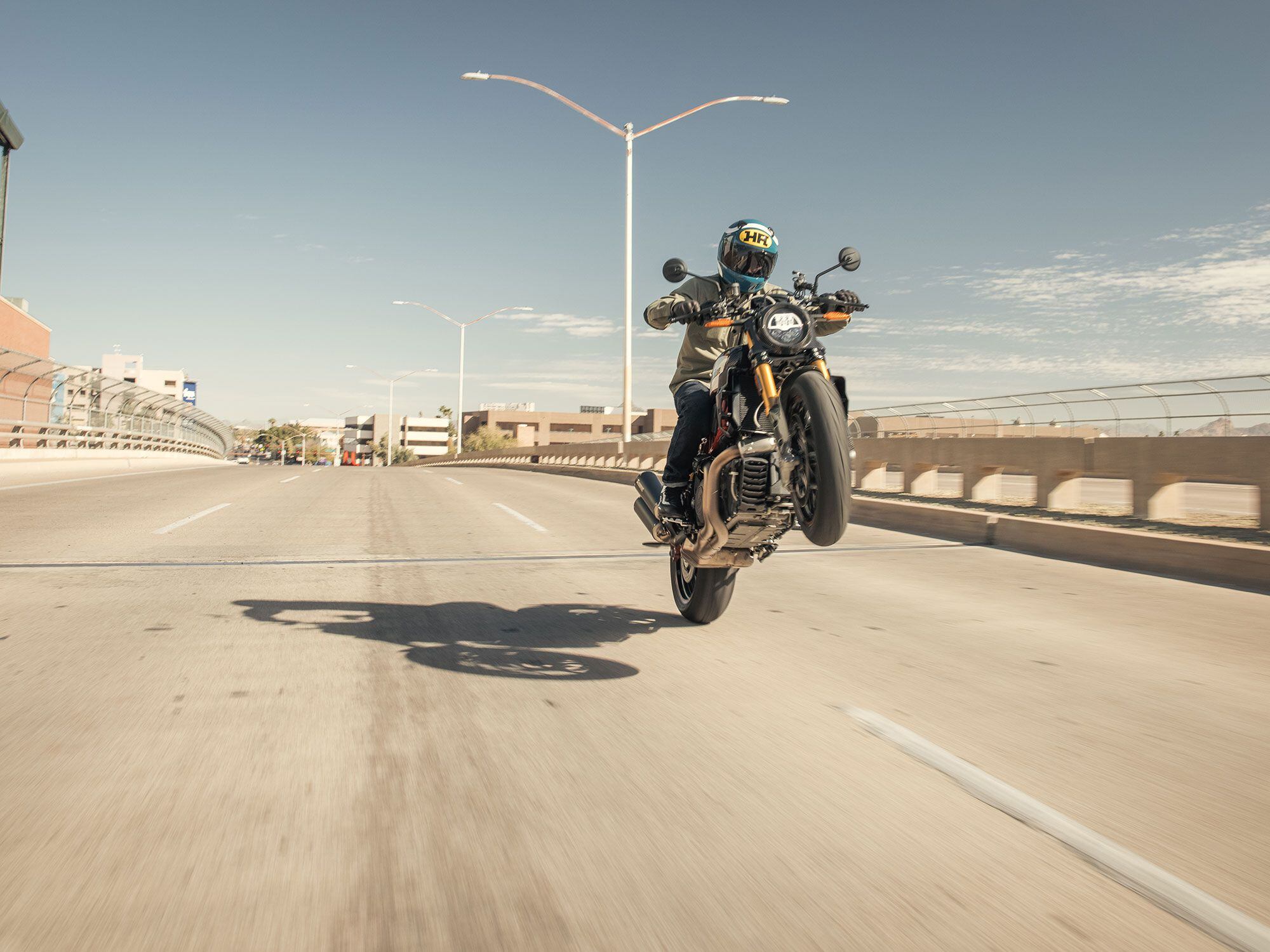
The FTR 1200’s rowdy personality has changed, but hasn’t been entirely eliminated. Wheelies galore! (Jordan Pay/)A cylinder deactivation system has also been incorporated, along with revised heat channeling to mitigate heat buildup. The system is activated above 176-degree Fahrenheit running temperature with the throttle shut and engine speed below 2,200 rpm, a nice touch for hot, summer days.
The sporty Metzeler rubber does an excellent job of handling the FTR’s power delivery. Gone is the squirmy rear-end acceleration action of the chunky Dunlop dirt track tires, replaced with gobs of solid traction. It’s a conflicting feeling, really: On one hand, the quick acceleration of the new FTR being ushered away from the corner by the sticky tires is addictive and will get you from point A to B in less time and with more confidence; on the other, the rowdy slips and slides of the outgoing model made you feel like the next American Flat Track champion. That will be sorely missed.
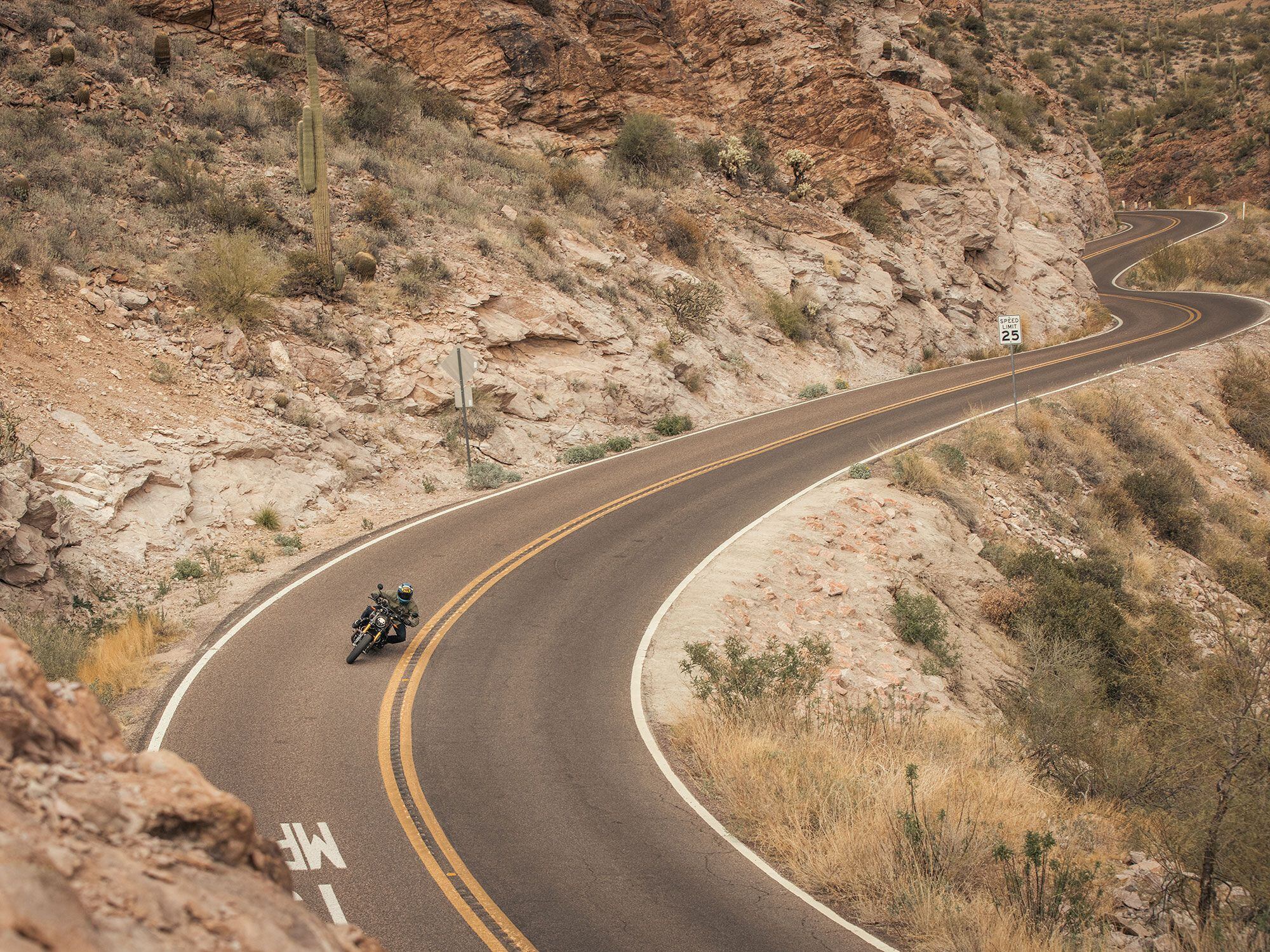
Revised geometry and sticky Metzeler tires make the FTR a menace at full lean. (Jordan Pay/)Still, opening the throttle on the FTR’s V-twin powerplant is always a hoot. The immediacy of the torque and a relatively quick-revving engine makes for a cruiser-meets-sportbike feel. This bike is originally based on the Indian Scout, after all. For reference, the last time we tested the FTR 1200 S on our in-house Dynojet 250i dyno, the Tracker produced 111.8 hp at 8,200 rpm and 80.5 pound-feet of torque at 5,800 rpm.
The 2022 Indian FTR 1200 will be available in three variants. The base FTR model gets fully adjustable Sachs suspension components, an analog dashboard, and a price of $12,999. Upgrading to the S model will get you an Akrapovič exhaust, a 4.3-inch TFT dashboard with Bluetooth functionality, selectable ride modes, lean-angle-sensitive traction control, stability control, and wheelie control for $14,999. The $16,999 FTR R Carbon variant gets the same features as the S models, but is decked out with carbon fiber fenders, covers, and accessories, as well as top-shelf Öhlins suspension bits.
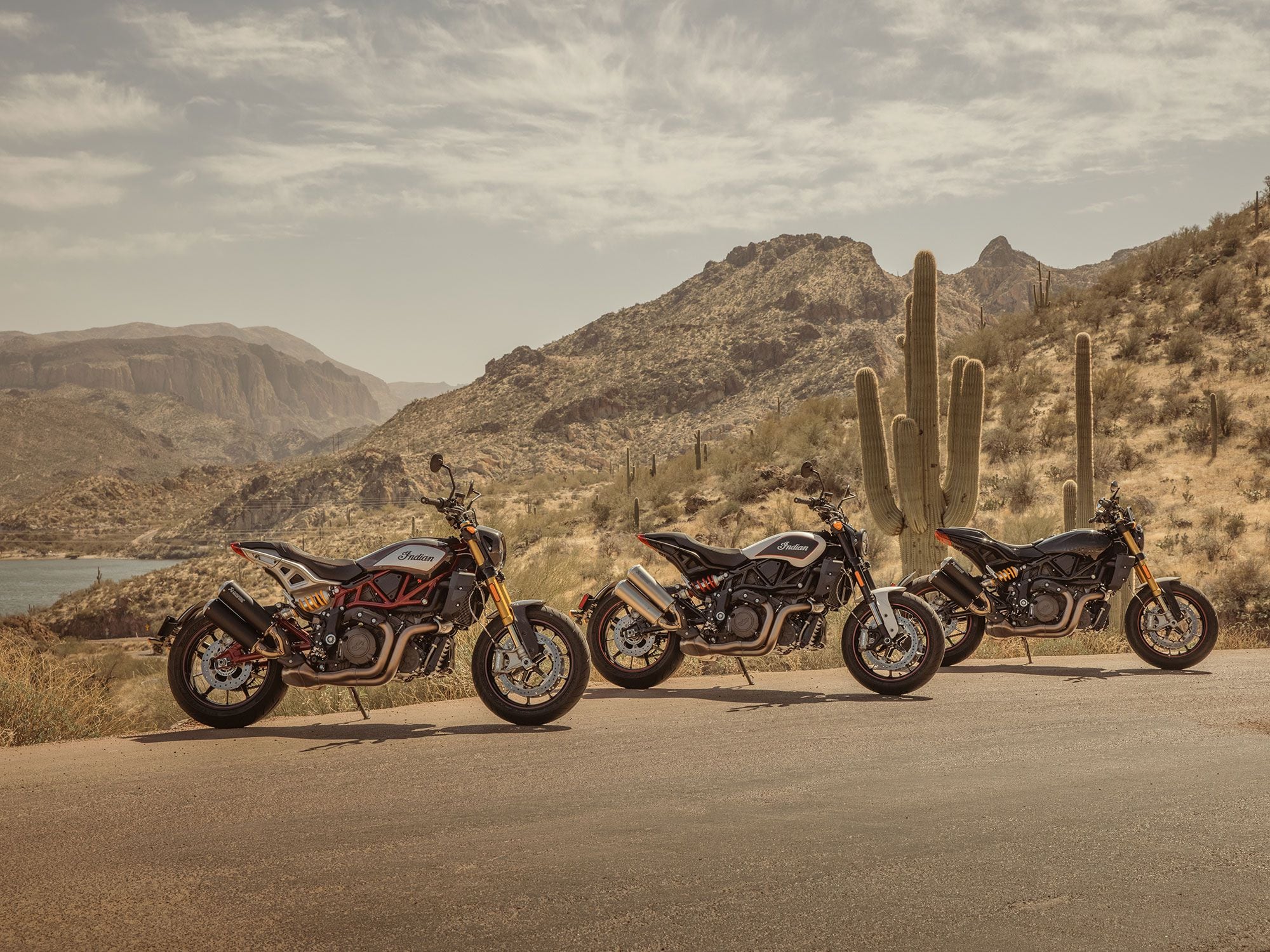
The Indian FTR R Carbon leads the S and base models. Each guarantees a seriously good time on two wheels. (Jordan Pay/)The FTR 1200 isn’t just an upgraded version of the original model. It is a real step toward Indian holding a significant slice of the sport standard segment. The FTR, updated and revised for more pinpoint road performance, remains a genuinely fun motorcycle that promises a good time, just with a somewhat different personality.
2022 Indian FTR 1200 Specs
MSRP: $12,999 (base model)/$14,999 (S model)/$16,999 (R Carbon) Engine: 1,203cc, DOHC, liquid-cooled, 60-degree V-twin Bore x Stroke: 102.0 x 73.6mm Transmission/Final Drive: 6-speed/chain Claimed Horsepower: 120.0 hp @ 7,750 rpm Claimed Measured Torque: 87.0 lb.-ft. @ 6,000 rpm Fuel System: Closed-loop fuel injection w/ 60mm Mikuni throttle bodies Clutch: Wet, multiplate, assist and slip Front Suspension: 43mm telescopic Sachs fork, fully adjustable; 4.7 in. travel/ 43mm telescopic Öhlinsfork, fully adjustable; 4.7 in. travel (R Carbon) Rear Suspension: Sachs monoshock, fully adjustable; 4.7 in. travel/Öhlins monoshock, fully adjustable; 4.7 in. travel (R Carbon) Front Brake: Brembo 4-piston Monoblock calipers, 320mm discs w/ ABS Rear Brake: Brembo 2-piston caliper, 260mm disc w/ ABS Wheels, Front/Rear: 17.5 x 3.5 in. / 17 x 5.5 in. Tires, Front/Rear: Metzeler Sportec M9 RR; 120/70-17, 180/55-17 Rake/Trail: 25.3°/3.9 in. Wheelbase: 60.0 in. Ground Clearance: 6.5 in. Seat Height: 32.2 in. Fuel Capacity: 3.4 gal. Claimed Dry Weight: 482 lb./479 lb. (R Carbon) Availability: Now Contact: indianmotorcycle.com -
Hello Amar,
Welcome to The Motorbike Forum. Please feel free to browse around and get to know the others. If you have any questions please don't hesitate to ask.
Why not tell us a bit about yourself too.
-
Hello VerySlowRider,
Welcome to The Motorbike Forum. Please feel free to browse around and get to know the others. If you have any questions please don't hesitate to ask.
Why not tell us a bit about yourself too.

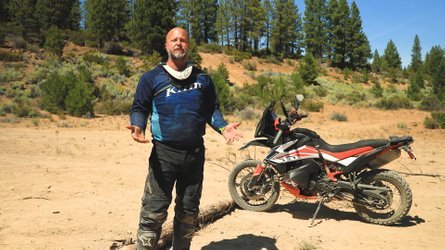
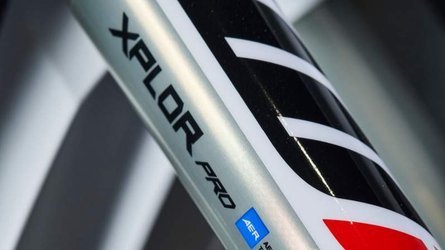
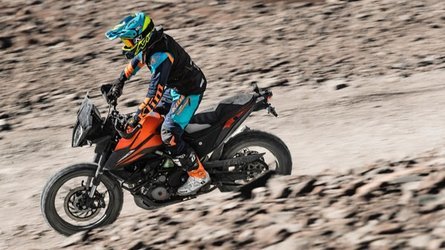
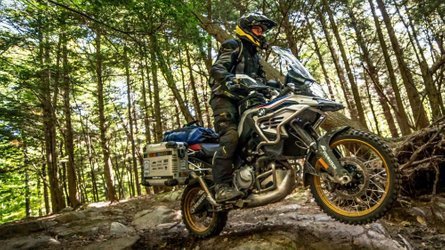
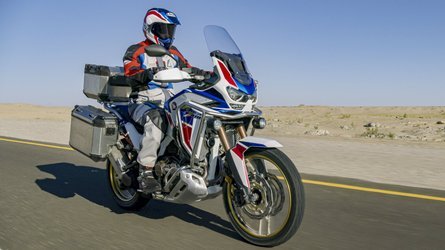
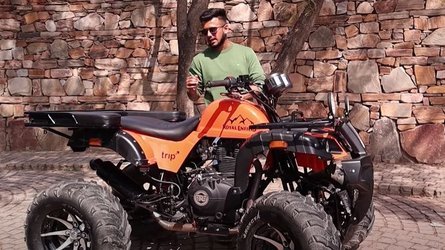
Could This Be Harley-Davidson’s New Mini Sportster?
in Motorbike news
Posted
Seems like Harley’s Chinese-made model may be getting a Sportster-like restyle, if this image from partner Qianjiang is any indication. (Qianjiang/)
Back in 2019 Harley-Davidson confirmed it was collaborating with Chinese manufacturer Qianjiang—Benelli’s parent company—to create a new 338cc parallel twin to appeal to riders in Asia, but now it appears a new V-twin project might be superseding that idea.
The original small-displacement bike was dubbed the 338R back then. Based on Benelli’s 302S chassis and engine, it had a slightly enlarged capacity by using the bigger-bore cylinders from the 500cc version of the same engine, but while design sketches, drawings, and even photos of a production-ready prototype emerged after the announcement, the bike hasn’t reached the market, and Harley has since become more reticent about the project. Now a new V-twin model with a more convincing H-D style and stance has emerged from Qianjiang, suggesting the project might be undergoing a substantial rethink.
Qianjiang’s teaser image calls the bike SRV300, and accompanying documents reveal a displacement of 296cc. (Harley-Davidson/)
The original 338R idea was spawned under the guidance of Harley’s then-CEO Matt Levatich, whose vision for the firm saw it expanding into a vast number of new product areas and markets. The new Pan America is the most notable result of that plan so far, complete with its up-to-the-minute, water-cooled, VVT, DOHC V-twin engine, but many other parts of Levatich’s plans have been dropped since he was replaced as CEO by Jochen Zeitz. Zeitz has replaced the wilder expansion bits of Levatich’s strategy with his own “Hardwire” road map, which focuses more tightly on Harley’s established markets instead of trying to invade segments dominated by other companies. However, even under the Hardwire rethink, Harley’s partnership with Qianjiang has remained in place, with the American firm’s most recent financial documents saying it intends to “develop and maintain a productive relationship with Zhejiang Qianjiang Motorcycle Co., Ltd. and launch related products in a timely manner.”
The redesign looks much more Harley-like than the 338cc sketches that preceded it. Is a mini Sportster on the way? (Harley-Davidson/)
With Harley-Davidson’s Hardwire plan putting the emphasis back on traditional market areas, but retaining the commitment to develop bikes with Qianjiang, a small V-twin with more conventional Harley styling than the 338R’s might be just the solution. And that’s precisely what Qianjiang is about to launch. So far the firm hasn’t revealed the bike officially, but it’s been type-approved in China, with a genuine photo accompanying the documents. Qianjiang has also revealed teaser images, calling the bike the SRV300. The type approval documents confirm the capacity is 296cc, with the engine rated at 22.6kW (around 30 hp) peak power. That might not be much, but a relatively low 163-kilogram (359 pounds) curb weight means it should be sprightly enough.
RELATED: New Harley 350cc
Although labeled as a QJMotor (one of Qianjiang’s Chinese-market brand names), the bike’s Harley-esque styling can’t be ignored. With the exception of the upside-down fork and the water-cooled, overhead-cam V-twin (with a neatly fitted radiator so as not to spoil the lines), it’s a near-perfect match for Harley’s Iron 883 model. Even the wheels follow the same design ethos, with polished alloy highlights on the edges of the black-painted spokes, while the guard for the belt final drive copies the holed look of the equivalent Harley part.
Everything is scaled down, of course; those wheels are 16 inches at the front, and 15 inches at the rear, while the wheelbase is just 55.1 inches. Top speed is pegged at 80 mph according to the type approval paperwork, while the bike’s kit includes ABS.
RELATED: Harley 350 Model From China Confirmed
It would be easy to write this off as another Chinese copycat machine, but Qianjiang’s relationship with Harley and its status as one of China’s leading motorcycle manufacturers (its controlling stake is owned by Geely, the company that also owns familiar Western brands like Volvo and Lotus) mean it’s worth taking seriously. People happily buy Chinese-made iPhones, and Harley already manufactures bikes in Thailand, so a Chinese-made Harley-Davidson isn’t as far-fetched as it might first appear.
View the full article